Blogger, amateur writer, gamer. Just a nerdy square trying to learn how to Tumbl.... How's tricks? Twitter: https://twitter.com/strategist9 YouTube Channel: https://www.youtube.com/channel/UCG8IYF_O0eHcFB3lbIKGAWQ
Don't wanna be here? Send us removal request.
Text
A Post-Mortem of MultiVersus

Roughly a year ago, MultiVersus came back from a year’s hibernation, promising a total revamp of the game that was originally launched in beta back in 2022. Of course, at the time of writing, MultiVersus has officially been taken offline for good, unable to be downloaded on any storefront, so clearly things didn’t go very well. And so we must ask…what went wrong here, and what can we learn from for any future attempts at crafting a game like MultiVersus? Let’s talk about it.
THE REVAMP’S FAILED REINVENTION
I’ve already written about the relaunch and its many problems (LINK HERE), but let me sum things up again. Upon relaunching back in June in 2024 MultiVersus was found to be a buggy, slow-paced mess that had also doubled down on all of the monetization models that people had already been complaining about back in beta. It was abundantly clear that the year they had spent reworking the game hadn’t yielded that much. We had a swap to Unreal Engine 5 for marginally better lighting, slightly improved (but still spotty) netcode, a few new characters and…that was about it. So right off the bat, the first impression of this full launch was negative, and it would be a herculean effort to right the ship after stumbling out of port like this.
To be fair to Player First Games, there was an attempt to save the game. They didn’t sit idly by and took criticism to heart, but for everything they added or changed, there’d be something else they would break in the process. It was truly one step forward and two steps back. Season two gave us Samurai Jack and Ranked Mode…except Jack was overtuned and annoying to fight, and Ranked had a ton of problems that held it back at launch. Season three had another fan favorite with The Powerpuff Girls…only for them to also be overpowered. They teased the addition of a shield mechanic in season three and fully implemented it in the following season, and while it was often requested from players, just as many hated the mechanic. Even defenders of the shield would largely agree it wasn’t implemented as well as it could have been. And then there was season four, their last big chance to turn things around and they pulled out all the stops. Arena Mode, Raven and Marceline as the new characters, and a new way to unlock fighters with Fighter’s Road. But uh…if you can guess the pattern here, those didn’t go well either. Arena Mode was a slog and barely anyone played it after a while. While Raven was mostly well regarded, Marceline felt super overtuned at launch. And then there was Fighter’s Road…the grind to end all grinds that largely created more problems than it solved.
With all this in mind, it was no surprise that season five would be the final season of the game. What WAS surprising though, is that the final big patch ended up leaving the game in a much better place, to the point people lamented that things were finally turning around…it was just too little, too late. The final patch decreased hitstop across the board and even adjusted the speed of some characters, finally addressing concerns over the game’s speed from the relaunch. Aquaman and Lola Bunny, the final two characters, were shown to be really fun additions just to rub salt in the wound. But for all of the positive changes, as much as hardcore fans might hate to admit it, MultiVersus was still a heavily flawed game, and it just stands to reason that it shouldn’t have relaunched in the state that it had in the first place. These issues were present even during the beta, and if those weren’t addressed with the relaunch, then its fate was sealed.
THE ORIGNAL SINS
For as highly as people speak of the beta version of MultiVersus, let’s not forget that game’s player base cratered well before the announcement it would be shut down for the relaunch a year later. Even in the beginning, this game had massive problems that went unaddressed. Monetization is an easy thing to gripe about, just to start. Having $15 and $20 skins was always gonna shoot this game in the foot. But it might have been easier to take if you didn’t have to buy characters too. There’s a lot of debate on if a free-to-play fighting game can even work with free characters, but I think MultiVersus had a chance to hit the ground running by offering the characters for free and just make the money back on all the skins. Look at the success of a game like Marvel Rivals, having all of the characters available all at once. While Rivals of Aether 2 is a paid game, all post-launch characters are going to be free, and they’ve also been relying on paid cosmetics to bolster development, as another example.
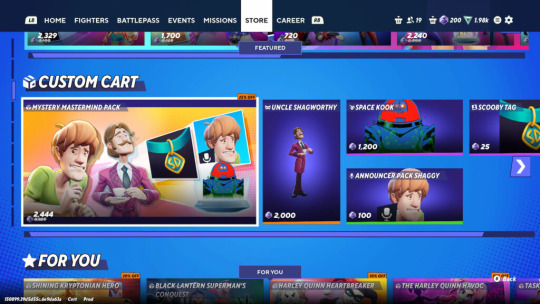
Even if you HAD to make characters paid, there was no reason they had to keep jacking the prices up. Going from $7 to $10, with new characters costing $12.50, this in addition to the skin prices just made this game a massive expense that many couldn’t afford. Really, this game failed one key aspect you see in all of these successful free-to-play games; you can hook the whales but you have to make it fun for everyone else too. The game feels like a massive grind if you don’t spend any money at all, and that just made people like me want to avoid giving it money in the first place. The game itself was shamelessly greedy, most evident with those limited time event skins. If you were willing to grind for hours to get the special currency you could spend ALL of it to get ONE of these skins for “free,” and then have to buy the others with real money…and all of those skins were roughly $30 each. Some people argued that because you were able to get ONE of them for the low, low price of several hours of grinding, it was OK to price the others that way and…yeah I’m just not buying it. And clearly it didn’t work or this game would still be around. Cuz let’s face it, TONS of free-to-play games are just as, if not more money grubbing than MultiVersus but they’re still kicking. And that’s because getting past monetization….this game just had huge flaws that sucked the fun away.
From the early days of the beta, it was clear MultiVersus left a lot to be desired with balance, hitboxes, and just overall core gameplay mechanics. Hitboxes were awful for most of this game’s life, and even after multiple changes you’ll still see characters phase through attacks that SHOULD hit them, or get tagged by something that was nowhere near them. We’ve had overtuned characters and one trick ponies throughout this game’s life. If it isn’t Samurai Jack, Shaggy or Banana Guard’s side special spam, it’s Taz’s tornado spam from the beta. Wonder Woman, Bugs and Harley barely got touched throughout the betas and full release, allowing them to just utterly dominate and do things so many other characters wished they could do. Velma, Gizmo and so many others got gutted with constant, needless changes, and then you have the gigantic can of worms that is the Iron Giant. All those years when Sakurai was made fun of for saying Ridley was too big for Smash…yeah no, I think he knew what he was talking about. Virtually every major patch required tons of extra work for Iron Giant, and at times he was taken offline entirely due to some exploit being found. He was always hovering over the precipice of being either total trash or completely breaking the game over his knee.
When it comes to mobility and defense, the game largely never sat right with me, or a lot of other people. The beta was too slippery and fast, and the full release was too sluggish. They never found a happy medium. I’m still baffled that they decided to put in a dash attack in a game with no dashing. The dodge serves as the only real burst movement option in the game, when it’s supposed to be a defensive mechanic. The dodge, as well as the parry added later on, felt finicky to use. Some characters, like Jason, barely moved when dodging and would eat attacks that others could avoid. The parry has so much recovery, even on a successful one, that you often couldn’t get the best punish out of it, and outside of a specific perk, it was detrimental to use against projectiles. Even the addition of shields later didn’t really help. Whether you’re for or against shields, I think we can be in agreement that such a major defensive mechanic shouldn’t have been so hastily added. Many were already used to the game lacking them, pointing to games like Brawlhalla or the first Rivals of Aether games as not having shields but still doing well. But those games had better core movement and just feel better designed in general compared to MultiVersus. The game was fun for a bit but the cracks formed quickly and weren’t being filled in fast enough, and the player base never really recovered. But maybe players would have stuck around with better picks for the roster.

From the jump, the potential that MultiVersus had was huge. Warner Bros. has so many properties that they either own or could get the license for that this could have been a game that celebrated movies and animation the same way that Super Smash Bros. celebrates video games. The original beta’s starting roster had a wide spread of IPs to pull from; Scooby-Doo, Game of Thrones, the various superheroes fromDC Comics…but there were also some rather strange picks that made many scratch their head. We got Shaggy and Velma but not the talking dog that’s the namesake of his series. We had Bugs Bunny and...Taz, but no Daffy in sight. I know there must be diehard fans of Gremlins out there, but did they really need TWO characters on that roster? The addition of Black Adam of all characters to the DC side was a transparent attempt at synergy with his own flop of a film, when there were several other more popular choices. And this is a problem that never really went away.
It was so strange for the relaunch to give us stages themed on Dexter’s Laboratory or The Powerpuff Girls, but no playable characters from those series (at first anyway). And when it came to adding in a new Adventure Time character, they went with…a random banana guard, a poor excuse for a joke character. We also settled into a pattern with these relaunch seasons that got old fast. It was a mixture of cartoon character and DC character after a while, with only Beetlejuice serving as a temporary break from that pattern. While characters like Raven or Marceline were well regarded, they came far too late. And when it finally came time to get another Looney Tunes rep…we got Lola Bunny before Daffy, despite a film starring the duck coming out around that same time. That said, it was Nubia who was criticized the most, a rather unknown DC Comics character that felt like a strange addition. An amazon wielding a spear, she felt a bit redundant when Wonder Woman and Banana Guard were already on the roster. I have no real qualms with the character and I can welcome more unexpected picks at times, but she really did feel like the epitome of “who asked for this?”
There’s rumors that the game’s main director pushed for some of these characters, and various datamines show that there are tons of other characters that were always in various forms of development that’ll never see the light of day. Raven had announcer packs leaked back during the beta, alongside a Wicked Witch of the West announcer pack. The Witch, alongside the likes of Scooby-Doo, also starred in the tie-in comic that was out around the same time as the relaunch. Why was the comic advertising characters that weren’t even in the game? Why all these leaked packs WELL before the character ever came out? Why prioritize someone like Banana Guard or Nubia over safer picks like Raven or The Powerpuff Girls? It just speaks to whoever was in charge being incredibly unorganized, and much like the rest of the game, they seemed ill-equipped to make what had been asked of them. So with all that being said…what can we learn from this?
LEARN FROM THE FLOP OR BE DOOMED TO REPEAT IT
Just a few years ago MultiVersus was being hailed as a shift in how fighting games could market themselves. Alongside the still un-released 2XKO from Riot Games, many argued that this was the beginning of the free-to-play age of fighting games. But I’m not so sure this will really work out. For one, there are simply SO MANY live-service games these days that competition is just too hard. All of these games are “forever games,” designed to take as much of your free time as possible and keep you from booting up anything else. Even with new titles coming out, they often end service within a year because they fail to tear people away from the heavy hitters. Fortnite continues to do well, alongside a few others, but for every success you have a dozen of failures like Foamstars, Concord, Knockout City, Rumbleverse and so on and so on. The live service bubble feels like it’s bursting, and this is a trend that just isn’t worth chasing.
But let’s pretend that isn’t the case. You’re built different, and you can deliver on a fighting game that can manage to get people’s attention and maintain it. You’re that rare confluence of events that leads to a smashing success. How exactly are you going to accomplish that? One of the biggest things successful live-services do is pump out content. You need to keep giving people a reason to boot your game up. So that means new skins or events or in the case of a fighting game, new characters. But right away there’s an issue: a fighting game character is so much more complex than just adding in a new gun or skin in something like Fortnite. It often takes MONTHS for a new character to come out in something like Street Fighter 6 or Tekken 8. Those games are also incredibly visually complex, with so much detail packed into a single character. So many cloth physics and high resolution textures so I can see every individual pore on their skin or hair on their head. Even if you go for a more stylized, less realistic look like the Guilty Gear series, the modern Arc System Works games spent so much time recreating that anime aesthetic, going through every animation frame by frame to adjust it so it looks just right. You’d have to try something different to pump out characters faster.
You’d need something with a simpler art style, that isn’t nearly as detailed or time consuming to make. But there’s also the matter of how complicated a character can be with their moveset and how you’d balance that with the rest of the cast. A gun being added to something like Apex Legends only has so many things it can do by contrast. So let’s trim that moveset down a bit, boiling it down to the bare essentials. You also need to make sure you’re constantly putting out new cosmetics in the meantime between characters. All this requires a TON of work though, and it can get costly, so you’ll have to find a way to price things accordingly. Don’t make players break the bank, but don’t give everything away for free either. Our ideal free-to-play fighter that learns from the mistakes of its predecessors would then have to have a simple art style, simple movesets, and not be too egregious with the monetization. Could such a thing exist? Well yeah…it’s called Brawlhalla.
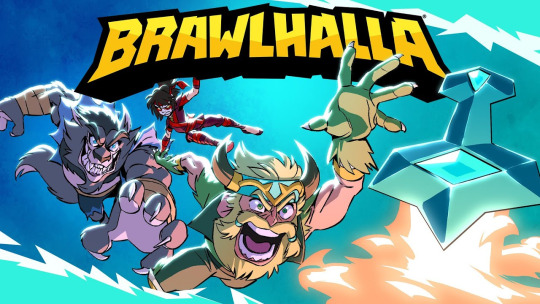
I’m not even really joking. Brawlhalla is a free-to-play fighting game that has managed to survive for a decade and still maintains a healthy player base. It has collabs with everything from Star Wars to Tekken to wrestlers and more. Now, I can’t speak to the monetization in general, as even in the best case scenario it’s bound to be pretty gross. However, this game also has an option to just buy the whole roster for forty bucks, and that will count for all future characters. It’s a ridiculous deal the longer the game exists. You can even try out every character and skin in training mode to try before you buy individual characters if you want to. It’s been a massive success largely in the background and other games refuse to really learn from it. There’s also 2XKO but that hasn’t launched at time of writing and we’ll have to see if Riot can pump out characters fast enough, and not overcharge for skins. Which uh…knowing Riot that probably will charge hand over fist for all of those Ahri skins. So in the end, the solution is there and everyone refuses to learn.
CONCLUSION
In the end, the writing had been on the wall long before MultiVersus came back from that year hiatus. There was a chance for the game to right itself, but it was a slim chance to fix everything in a year. I think that Player First Games certainly has very talented artists and for all the misfires with some character designs, they also had some really great realized characters. Tom & Jerry were a fantastic take on a duo character, perfectly showcasing their own animosity against each other, with other fighters just caught in the crossfire. Rick was also an inspired design with tons of shenanigans you can get into with his portals and various projectiles. I can give the game credit for attempting to make a 2v2 focused game and emphasizing team work. There are bones of a good game buried deep within MultiVersus but sadly you have to dig too far to get there. Maybe if things had just been a bit different. If anything, I hope this game can be used as an example of what not to do when designing a fighting game or a live service one for that matter. In fact, it seems Riot already took notice, as there are rumors that they had been working on their own platform fighter and it was cancelled after seeing what happened with MultiVersus. I do feel for the fans of this game and I hope that everyone who worked at Player First Games gets on their feet with a new job. Ultimately, a lot of people suffered for the decisions likely made by just a few, which is unfortunately a trend in the gaming industry these days. There will continue to be more flops like MultiVersus for as long as the industry is ruled by greed and hubris. I have my doubts we’ll see those in power learn their lesson, but it doesn’t hurt to hope for the best, right?
Until next time.
-B
#blog#xb-squaredx#multiversus#warner bros#looney tunes#bugs bunny#lebron#friday the 13th#fighting game#platform fighter#brawlhalla
2 notes
·
View notes
Text
Gaming in 2024: Layoffs, Live-Service Bombs and Mascot Platformers, Oh My!
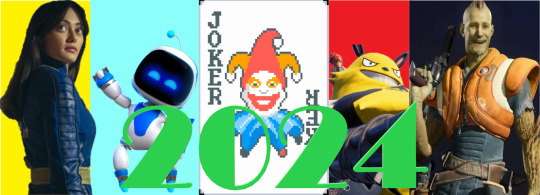
Another year in the rearview mirror, it’s important to remember where we’ve been to have a better idea of where we’re heading. Much of 2023 was marked by a massive amount of layoffs across the gaming industry, and uh….2024 hasn’t really seen any improvements in that regard. As the initial sale surges of the early pandemic cool off, unchecked corporate greed has led to all of these acquisitions and resulting layoffs rendering much of this industry a shell of what it was just a few short years ago. It hasn’t all been bad, of course, but it’s important to highlight the more worrisome trends in gaming alongside all of the success stories. So join me once more as we take a look back at gaming in 2024.
THE BIG THREE
As is customary, let’s start off with recapping what the biggest game publishers did with their year. Microsoft had…well, quite the tumultuous year. Following their spending spree of acquisitions over the past few years, we’re starting to see a lot of the negative effects of that. This year alone Microsoft would close down four studios (Tango Gameworks, Arkane Austin, Alpha Dog Games and Roundhouse Studios), and lay off over 1900 people in total. Tango at least would get picked up by…the developers of PUBG of all things with the Hi-Fi Rush IP intact at least, but that’s about the only silver lining. Even 343 Industries, the ones with the trusted Halo series under their belt, didn’t escape downsizing, with future games likely being outsourced.

Perhaps as a result of these decisions certain developers under Microsoft have fought back a bit. Activision’s QA department formed the largest western video game union this year, with various World of Warcraft devs also forming a union at Blizzard. Toys for Bob, known for working on the most recent Crash Bandicoot games also split from Activision to go independent. It’s honestly hard to not look at Microsoft as a bit of a sinking ship at times, what with their only landmark title for the year in Hellblade II getting a somewhat mixed reception, not to mention this year also saw the release of a few previously exclusive games to other platforms. Coupled with the rather bizarre “This is an Xbox” branding at the end of the year, it feels like in the near future Microsoft might not really be considered a major console developer and instead pivot to software, but we’ll see how much longer they can hold on like this.
For Sony, I think it’s fair to say they had a bit of an off year. Starting off, they were pretty public about not having many major releases for the bulk of the year in their tent pole series, and even mentioned needing more original IPs to leverage. In the realm of hardware this year saw the reveal and release of the PS5 Pro…to a mixed reception. For starters, it’s retailing at $699 USD, and that’s before getting into the optional $80 stand, or the fact it is digital only (but you could buy an optional disc drive for eighty more bucks!), but people are split on the actual value the system has with its upgraded specs. While a big game like Final Fantasy VII: Rebirth does look and perform noticeably better, it isn’t exactly a clear upgrade for most games across the board. Considering just how few games are truly next-gen exclusive at the moment (we still see games releasing on the PS4 even this year), it has been hard to convince people to upgrade and its sales aren’t quite matching the PS4 Pro in the same timeframe. The fact that scalpers are forced to sell at a loss should show that the demand just isn’t there. They weren’t strangers to cutting jobs either, with over 200 people laid off at Bungie.
That said, there’s three big games to talk about for Sony this year and unfortunately most of them don’t have the best stories attached. On the one hand, at the start of the year Helldivers II was a bit of a sleeper hit, selling very well and getting a lot of praise for being a hit multiplayer shooter in a market flooded with them. But that good will was hampered by the decision made by Sony higher-ups to require a PlayStation Network account to play the game even on PC. While they would walk that back a bit due to backlash, in the end 180 countries that have no access to PSN are also effectively locked out of playing Helldivers II. Coupled with some questionable updates and balance adjustments, the game lost a bit of its momentum. But hey, at least it didn’t pull a Concord.

Concord was to be the first title from the freshly-purchased Firewalk Studio, and Sony clearly anticipated it being a major hit. So much so they had commissioned an episode of the video game anthology series, Secret Level, to be about the game. And then with the release, Concord broke records…by becoming perhaps the most high profile video game bomb of all time. Launch numbers seemed dire, the game not even breaking 1000 players on Steam on day one. Within the first two weeks the game was effectively un-launched with all copies refunded and a month later Firewalk Studio was shut down. The game was developed over the course of eight years, well before the Firewalk purchase and was rumored to have a budget of over $400 million. It was lambasted for stale, uninteresting character designs, a kiss of death for a hero shooter, on top of just…not representing anything interesting in the overcrowded live service space. I’m sure retailing at forty bucks didn’t help it, though after Helldivers II’s massive success with a similar price point, no doubt Sony expected lightning to strike twice. While not particularly memorable itself, it has become one of the most infamous bombs in this industry, though time will tell if any lessons are learned here. Seeing that Sony wants to buy Kadokawa, one of the largest media distributors in Japan (not just for games but tons of anime licenses), it seems like Sony is still pretty acquisition hungry, even if a sale isn’t happening…FOR NOW.
The only real bright spot for Sony this year then was found with the surprise hit that was Astro Bot. Despite being around for much of the PS4 generation, Astro Bot finally getting his own standalone non-VR, non-pack-in game had him break out into the big time and was one of the more celebrated games of the year. For one thing, it’s just a high quality 3D platformer, and that’s an endangered species as far as genres go (if your name isn’t Mario or Sonic anyway), but it was also a game that celebrated the 30th anniversary of the PlayStation console in general. Tons of cameos and references to various Sony first party titles were found inside, on top of a lot of notable third party cameos too. Between this and the pack-in Astro’s Playroom on PS5, Team Asobi seem to be one of the few devs that still remember why people fell in love with Playstation in the first place. It ended up winning several awards at The Game Awards, including Game of the Year, so that’s a brighter note for Sony to end on for this year.
And that brings us to Nintendo, who had a fairly quiet year in terms of game releases, though they are not without some controversies. On the one hand, with multiple rumors swelling about the impeding “Switch 2,” that MIGHT come out next year (it will apparently be REVEALED by April 2025 at least), this was a year where games were mostly handled by various smaller dev teams at the behest of Nintendo as their major teams clearly have their hands full. Peach and Zelda got starring roles with Princess Peach Showtime and The Legend of Zelda: Echoes of Wisdom respectively, which is great and long overdue, but there were also smaller series given some spotlight. A new Endless Ocean, remakes of the Another Code series, and a brand new entry in the Famicom Detective Club series shows us that the Switch did so well, Nintendo had to dig deep once all the other bigger series were more or less taken care of. Taking note of that last title, Emio – The Smiling Man got a lot of attention for its mysterious viral marketing…that it was a new Famicom Detective Club game did roll some eyes, but it clearly got more eyes on the game than it would have gotten otherwise. Mario RPG fans ended up eating pretty well too, with the Paper Mario: The Thousand Year Door remake hitting in the summer alongside the first brand new Mario & Luigi RPG in more than a decade. All and all, not a bad year for a console that’s been around for over seven years.
That’s just with games though, as Nintendo DID get involved in some more dubious things as the year went on. On the one hand, we have the more zany, left-field Nintendo ideas that were dropped at random points throughout this year like the Nintendo Music app or Alarmo…the digital alarm clock that plays game sounds and music to wake you up. But on the other hand, Nintendo was on a bit of a warpath with lawsuits this year. Notorious Switch emulator Yuzu were sued for over $2.4 million this year, seemingly shutting down by far the most prominent emulator for the system. And then there’s all the stuff related to Pocketpair and Palworld.

Palworld is definitely one of the more infamous games released this year. Developed by Pocketpair, a smaller Japanese dev known for little before this, the game made waves whenever a new trailer was shown off, being known by many as “Pokémon but with guns.” It released early in the year, showcasing a blending of monster catching and survival elements that made it out to be a strange fusion of an open world game similar to Breath of the Wild or Genshin Impact with a side of ARK: Survival Evolved. That said, what caught many people’s attention was just HOW similar a lot of the designs of the Pals were compared to a variety of Pokémon. Some argued that the wire meshes for the models was too similar to be a mere coincidence in some cases, but on the other hand…most Pokémon are based off of animals and mythical figures, so it’s not like THEY are wholly original either. That said, many felt it was just skirting the line and wouldn’t have been surprised if Nintendo or The Pokémon Company retaliated…and they eventually did, though not in the way most expected. Pocketpair would receive a joint lawsuit filed from Nintendo and The Pokémon Company over patent infringement, all relating to mechanics and animations that were present in Pokémon Legends: Arceaus, and while this is ongoing and will likely take some time to fully complete itself, the suit itself doesn’t really set a good precedent. Many would argue that trying to patent rather broad gameplay elements like this is anti-art, and only hurts the industry. But at the same time, Palworld feels like a rather cynical, derivative work that really straddles the line of plagiarism to a degree. It IS worth noting that Sony has a vested interest in the Palworld IP and has even invested some money and wants to go into multi-media so this could also be read as Nintendo and The Pokémon company wanting to snuff out any early competition. Who would have thought a seemingly unreal meme game would eventually lead to all of this?
And while we still have Pokémon on the brain here, we should also bring up the rather massive data leak that came from Game Freak late this year. Following a successful phishing attempt with an email, a reported terabyte of data was stolen from the developer. We’re talking the source code of some games, beta designs from older Pokémon games, potential info on the upcoming Pokémon Legends: Z-A titleamong many other things. The element that probably drove the most engagement in the aftermath of the leak was a lot of alleged old lore entries or stories in the Pokémon world that often had Pokémon engaging in very…graphic acts. At this point though, it’s hard to tell how much of this was actually real, the results of dodgy translation or just a writing exercise as developers tried to hash out what they wanted for the series. All I know is I’ll never look at Typlosion the same way again. That said, the actual worst part of this leak is that this also included employee information. Don’t get me wrong, seeing some of this beta stuff and development notes IS legitimately fascinating, but it shouldn’t come at the cost of real people’s safety and privacy. With all this in mind, it hasn’t been easy to be a Pokémon fan this year.
That’ll cover the big dogs, but there’s still the matter of other assorted industry news to cover and…sadly the trend won’t really improve all that much.
THE LITTLE GUYS LICK THEIR WOUNDS
For starters, we can look at Square Enix. They announced layoffs in their US and Europe offices, and saw a major drop in their stocks. After lacking sales in their most recent Final Fantasy games, Square seems to understand that staying console exclusive isn’t a viable path anymore and will likely be changing course on that in the future. Ubisoft is also not having the best of times at the moment. For one, they were sued over the closure of The Crew, a pretty notable lawsuit regarding how online-only games are allowed to be made worthless with the flip of a switch. They’ve had quite a few gaffs this year, such as trying to tell people that they should just “get used” to not owning the games they buy, and wants Steam to hide player numbers so people aren’t aware of how their games have been failing. One of their most high-profile failures this year was with Star Wars: Outlaws, showcasing that despite the Star Wars branding, people are not totally down with the open world Ubisoft formula anymore. With that in mind, there have been rumors of Tencent buying up Ubisoft.
Speaking of Tencent, they were notable for laying off the staff at Ouka Studios before their latest game, Visions of Mana, could even release. We’re at a point where you don’t even get to see if a game is successful before you get let go anymore it seems. And lastly from Tencent, renowned Capcom developer, Hideaki Itsuno has jumped ship to Tencent, though time will tell if that venture pays off for him. In the realm of game journalism there were quite a few shake ups too. IGN acquired multiple publications from Gamer Network, with perhaps the most notable being Eurogamer. Elsewhere, Gamestop would shut down Game Informer, which is a pretty major loss for gaming news. For over 33 years they were the premiere US-based gaming magazine known for in-depth interviews and looks at games; the void they leave behind is pretty massive.
In April Void Interact suffered a massive 4 terabyte data breach which sadly included source code for their game, Ready or Not, a tactical FPS that had just hit early access late last year. No employee information was seemingly found in the leaks at least, but alongside the Game Freak leak this year its clear security in the video game scene needs a lot of work. Annapurna’s gaming division all resigned en masse this year as well, following disagreements with where to take the company, which certainly calls into question the fate of certain games partnering with them. I suppose it might be better than the alternative of just laying everyone off.
Speaking of even more layoffs though, just to make sure we’re covering our bases, there’s even more jobs lost from the likes of Riot. They cut 530 jobs this year alone. Seeing how they still rake in so much money from the likes of League of Legends it’s frustrating to see that success not equating to job security. Supermassive laid off 90 staff, following the less-than-stellar reception to some of their latest games, including the Until Dawn remake. And perhaps most devastating of all, EA saw 5% of its workforce laid off, so that’s another 670 jobs gone. Grim stuff in general here.
I suppose I should bring up that in the realm of video game adaptations we had some mixed reception to certain new products. On the one hand, the live-action Fallout adaptation was extremely well received and successful, and Arcane mostly seemed to deliver on its final season. However, the Amazon-original Secret Level has been a lot more hit-or-miss. An anthology show depicting a truly random assortment of games, audiences seem split on the quality of many of these episodes. Some, like the Mega Man one, were very short and relatively solid reinterpretations of their origin stories, but some took more creative liberties, such as the Pac-Man episode that seems to have mostly been a stealth ad for the recently revealed Shadow Labyrinth game, a darker and edgier take on Pac-Man similar the reviled Bomberman: Act Zero. And then there was that episode on Concord which uh…need I say more there? Oh and then the Borderlands movie bombed, but at least the Sonic 3 movie seems to be doing well (less said about the Knuckles spin-off the better though).
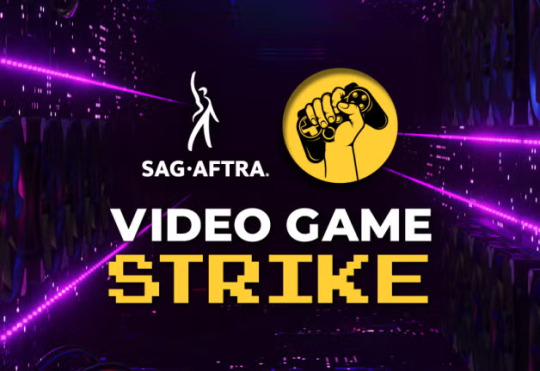
I also feel I need to at least pay some lip service to the ongoing video game voice actor strike with SAG-AFTRA members. Following ongoing negotiations with the ever-growing threat of generative AI taking over the industry, in July of this year a video game strike was launched against various video game developers and publishers. While some publishers have made interim agreements or side deals with the actor union, many are still on the picket line as they fight for the right to not have their voice thrown up on an AI database and just used without their knowledge or consent. AI is a pretty hot-button issue right now, not just in gaming but everywhere. We’re living in a world where it can be hard to tell what is real and what is being generated by an AI program, where capitalists see this as a way to cut down on costs at the expense of art losing its soul and manmade touch, not to mention the potential environmental impacts. I certainly hope that actors can get the protections they need and eventually this strike can come to an end, but at time of writing it continues onwards. Maybe once that AI bubble pops we can get some GOOD news for once.
Speaking of good news though, I want to switch gears and indulge my own niche interests a bit here, and talk about all the good (and bad) things in the realm of fighting games this year.
LEGENDARY PARTNERSHIPS AND RESURRECTIONS
All things told, this year was pretty good for fighting games, though there’s definitely a few stinkers mixed in here. The year itself started off with the launch of French Bread’s Under Night In-Birth 2: Sys Celes, and despite some launch issues overall it’s a fairly well-regarded release that continues to iterate on the gameplay that makes the Under Night series stand out. SNK also was in the news a lot this year with continued news about their next title, Fatal Fury: City of the Wolves. They’re received a lot of praise for the game’s visual style, and fans are eagerly awaiting the release early in 2025. But the biggest game release by far this year was Tekken 8. Pretty much the sole big 3D fighter at the moment, the game drew equal amounts praise and criticism for its more aggressive playstyle and changes to older characters, alongside the rather large visual upgrade. The story mode was also praised for being very bombastic, with a very intricate final boss that takes the Tekken story to new heights. Sadly…it couldn’t escape some criticism here or there though. After release the game would suddenly add in a cosmetic shop littered with microtransactions, something that reviews never seemed to get wind of, and later on drew the ire of players with the release of a new stage that was NOT included with the season pass, despite an earlier stage seemingly being included in the pass. They received a lot of flak for some of the DLC choices as well, with the latest character for the season, Clive from Final Fantasy XVI, splitting the fanbase a bit. Despite all of that, the game has clearly done well for itself (taking home Fighting Game of the Year at The Game Awards) and will likely be supported for years to come.
This year also saw a lot of older franchises come back from the dead, and some longstanding partnerships were suddenly highlighted. For starters, a new entry in the Dragon Ball: Budokai Tenkaichi series, Sparking Zero, saw release. This was a bit of a dream come true for longtime Dragon Ball fans who love diving into the virtual toybox that this series supports…though it IS worth noting it was also home to a very embarrassing official tournament that highlighted some fairly terrible balance decisions in the game. Capcom came out of nowhere with the surprise release of a fighting collection of all of the Marvel Comics fighting games they made over the years, especially the iconic Marvel vs. Capcom series. Not to be outdone on that note, they confirmed yet ANOTHER fighting collection, this time being made up of a variety of early 3D titles such as Project Justice or the Power Stone games, alongside the two SNK crossover titles. Capcom and SNK are particularly buddy-buddy this year, as this year also saw that for Street Fighter 6’s second season we would see Fatal Fury’s Terry Bogard and Mai Shiranui joining the game, and for City of the Wolves both Ken Masters and Chun-li will also guest star. Adding onto all of that, there was also the finale to the Capcom Cup and the $1 million prize. About the only thing to complain about is a lack of costumes for SF6.

That said, by far the most significant return to fame this year was Sega finally confirming a brand new Virtua Fighter game. With a teaser shown off at The Game Awards, and a massive “Virtua Fighter Direct” detailing things afterward, Sega seems to be committed to reminding people why they were once the kings of the 3D fighter. When you have the president of Nvidia and a Saudi prince singing the praises of the series and seemingly throwing their own support towards this revival, it seems like it might be something special, though we don’t yet know how long we’ll have to wait for the game. In the meantime, there has been yet another re-release of Virtua Fighter 5 on PC that supports proper rollback netcode as well as balance adjustments to sate players for now.
Of course not everything was great in the realm of fighters. Mortal Kombat 1’s first full year was filled with a fair bit of criticism, but the announcement of their second season and major story expansion, Khaos Reigns, didn’t seem to do much better. For starters, it was quite pricy at over fifty dollars for a short story expansion and six characters, with no ability (at least at first) to just buy the characters separately from the pack. There’s also the matter of the character choices; revamped versions of the cyborg ninjas alongside Noob Saibot were a bit disappointing for some but then there’s the guests. Ghostface from the Scream films, Arnold Schwarzenegger’s Conan the Barbarian, and the T-1000 from the Terminator films. Some feel they’re kind of scraping the bottom of the barrel for “fitting” guests, not to mention many are still reeling with the double dose of “evil Superman” characters like Omni Man and Homelander last season. Rumors swirled that the expansion sold poorly and future DLC likely won’t follow. In general it’s hard to feel like MK1 wasn’t a bit of a misstep.
We’re not done talking about Warner Bros. fighters either. After a yearlong slumber, MultiVersus returned. While this free-to-play platform fighter seemed like it was going to be a smash hit during its open beta in 2022, it quickly ran dry of content and then abruptly announced it would be going offline for a year to prepare for the “real” launch. I’ve talked about why this relaunch faltered elsewhere but to sum things up: the game plays substantially differently, it is still loaded with bugs and strange design decisions that were still present in the beta, on top of some of the most aggressive and desperate monetization I’ve seen yet. At one point, WB outright bought the studio behind the game, Player First Games, so it seemed like maybe they were ready to invest more into the game. However, ahead of its fourth season reveal, WB Discovery CEO David Zaslav stated in an investor call that the game, among others, contributed to a $100 million loss so….getting some mixed messages here. That said, the recent release of Rivals of Aether 2 does seem to have given platform fighter fans SOME solace.
Oddly enough, MultiVersus’ failures seemingly scared off Riot and their own attempt at a platform fighter, if rumors are true. Outside of that potential game, Riot finally unveiled a bit more information on their upcoming League of Legends game. Once known as “Project L” for years, it has a new name….2XKO. This name got lambasted pretty quickly, though later on in the year the game got a playable beta that received a lot of feedback from players. Many still seem to be really highlighting this game as being something special, but details are still scarce regarding the release date, so this is far from the last we’ve seen of it.
And lastly, I feel the need to highlight the truly awful hand dealt towards the indie fighter, Them’s Fightin’ Herds. Going from a fan game based off of the Friendship is Magic My Little Pony generation, it eventually became its own title. It was a fairly solid little fighter, even if it never quite got a lot of attention for one reason or another. Sadly, this year the devs, after being purchased by Maximum Entertainment, were abruptly laid off before work on the final two characters of their first (and now only) season pass could be complete. These last two fighters were hastily released and completely broke the game with massive oversights and game breaking bugs that threatened to ruin the game’s small, if dedicated, competitive scene. Later patches would smooth over SOME of these issues but it’s clear that this game was not given the sendoff it deserved. With other fighters in development with Maximum Entertainment, such as Diesel Legacy: The Brazen Age, a beat-em up fighting game hybrid that employs controversial fighting game dev Mike Zaimont, as well as a game set in the Avatar: The Last Airbender universe, I think audiences should think twice about supporting this publisher. They clearly don’t support their developers.
With that detour out of the way, let’s return to talking about some big titles that hit this year as a way to wrap things up.
THE BIG GAMES OF 2024: MANY HITS AND MISSES
Fans of live-service shooters were spoiled for choice this year, though not all of those experiences are made equal. After all, we already talked about Concord. That said, another failure of sorts in this genre was WB’s own Suicide Squad: Kill the Justice League. The first brand new (non-VR) game from Rocksteady in almost a decade, the game was sadly dead on arrival and was one of the more notable bombs early in the year. Many felt that it wasn’t the best call to make a game about taking out such beloved heroes in their first major appearance in the Arkham Series. There’s also the fact this came from a studio known for making tight, single-player experiences and suddenly jumping ship to a live-service multiplayer game seemed unwise. Really you could go on with all the ways in which this game failed to be very appealing, but it ultimately lead to poor sales and would barely get out a year’s worth of planned content before effectively wrapping up. In all, it is said to have cost WB $200 million in revenue. With all that being said, a bit of a major shocker at year’s end was the surprise success of Marvel Rivals. While clearly somewhat derivative when compared to Blizzard’s Overwatch, the slick presentation, relatively consumer-friendly microtransactions and generally solid gameplay has led to the game getting a ton of attention, gaining 10 million players within three days of going live. Certainly did better than something like Foamstars, a game clearly aping Splatoon that has fizzled out in the same year it debuted. I guess at the end of the day live-service games can do just fine if you…you know…make it appealing.

We’ve covered most of the bigger games from the major, well-known publishers this year but there are some more notable hits from various developers in Asia. From Korea, we have Shift Up’s Stellar Blade, an action game that managed to be very…eye catching in various ways, seen by many as a solid title that took more than a little inspiration from Nier Automata (even scoring a collab with them). It DID unfortunately get embroiled in some culture war stuff; some feeling it was a game that “destroyed” the West because uh….the main character had a big ass or whatever. There WAS a bit of controversy from this same crowd when some of the costumes in-game seemed to be censored…but honestly it looks like people making a mountain out of a molehill. At the very least, the devs seem to be pretty normal about things…which unfortunately I can’t say for one of China’s biggest success stories this year: Black Myth: Wukong. This title became a true smash hit with over 21 million copies sold and won a variety of awards by the year’s end. But there WAS a lot of controversy regarding the game, with some bizarre streaming guidelines that forbade influencers from talking about “feminist propaganda” among other things. And then there’s the director of the game being more than a little salty that the game didn’t win Game of the Year at The Game Awards. Still, it’s good to see gaming continue to grow throughout the world with a variety of other countries really coming into their own.
And lastly, I want to shed some light on some of the more notable indie games released this year. There’s dozens of titles that deserve some limelight, like Lorelei and the Laser Eyes, a visually stunning mystery game from the developers behind the equally visually stunning Sayonara Wild Hearts. Or there’s Arzette: The Jewel of Faramore, a game that sets out to emulate the infamous Zelda CDI games…except, you know…good. There’s the adorable platformer The Plucky Squire, or the acclaimed puzzle metroidvania Animal Well too. In sheer variety, UFO 50 has you covered with 50 games from a bunch of different genres in a way that emulates those old retro collections with games of dubious quality. Horror games even got some interesting entries this year with Crow Country as a fun throw-back to PS1 horror similar to Signalis from last year. Mouthwashing also came out of nowhere and ended up becoming a surprise hit for many, as the dark and at times distressing story really connected with people, introducing one of the most hateable characters in gaming (seriously, Jimmy is the worst). But the biggest hit by far this year was Balatro. The Poker roguelite has sailed past 3.5 million sales this year, ending up securing some wins at The Game Awards, and it shows little signs of slowing down. A deceptively simple gameplay loop, themed around gaining special Joker cards that allow you to cheat in increasingly crazy ways at Poker, the game proves hard to put down and even as some were perplexed that it would be nominated for Game of the Year, all it takes is a few games to be converted. Seeing as this was made by one guy, that’s pretty damn impressive. With how bad the industry has been for the top dogs out there, it’s not hard to feel like indies really pick up the slack in many ways.
Ordinarily we’d be done here, but I have one last segment I want to go over….because we’re STILL not done with the rampant layoffs and such that plague the industry, but one company in particular needs to be brought to task.
A DEADLY EMBRACE
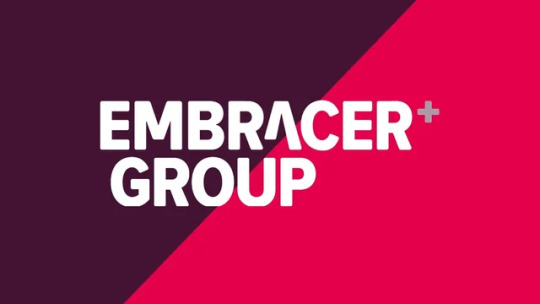
So far we’ve covered a variety of layoffs and studio closures from Microsoft, Sony, EA, Riot, Square Enix and more, but there is one company that stands out among all others. An entity that has been putting its fingers in all the pies, and it has basically ruined the entire bakery. I’m talking, of course, about Embracer Group. The last few years have seen Embracer swooping in and grabbing up as many studios as possible. At one point it was easier to think about what they DIDN’T own. However, their spending sprees (and a failed Saudi deal) have had a lot of repercussions this year especially. Let’s take it from the top of the year.
First, Lost Boys Interactive hit layoffs right in January, though an exact number wasn’t given. A second round of layoffs would occur in September, once again being quite significant but no numbers shared. Also in January, 97 jobs were cut from Eidos Montreal, and on top of that work on a new Deus Ex game was halted and cancelled. After Embracer picked up the studio in 2022 they haven’t exactly done much with it and now here we are. We’re STILL in January with more cuts from Black Forest Games losing a whopping 50% of its workforce. With this in mind, by February of this year, taking into account some cuts made at the end of 2023, Embracer was suddenly out nearly 1400 workers. To paraphrase a quote given about these layoffs, their highest priority is their shareholders. These people don’t care about games, or people’s livelihoods…they just want to make sure the line keeps going up. I wish I could say we were done here but we’re still just getting started.
You see, in addition to all of these layoffs, they also sold off a variety of studios that they owned in an attempt to get rid of debts and right their ships. In March, they sold off Saber Interactive for a deal that seems to be valued at around $250 million, with a variety of projects now given ownership to the buyer, Beacon Interactive. At least with this deal jobs seemed to be secured. The same can NOT be said for the sale of Gearbox to Take Two for about $460 million. Shortly afterward Gearbox faced layoffs, though an exact number wasn’t given.
As a result of all of this, in April Embracer would announce plans to split into three different brands: Asmodee (dealing primarily with trading cards, off of a purchase from 2022), Coffee Stain and Friends (focusing on a variety of their smaller gaming IPs) and Middle-earth Representatives and Friends (focusing on bigger powerhouse IP with games as well as the Lords of the Rings franchise). This is being done to allegedly allow all of these different studios and business ventures to run as efficiently as possible but forgive me if I’m not altogether optimistic. To prove my pessimism right, in June Embracer would close down Pieces Interactive, known for the Alone in the Dark franchise. One final blunder to close this section out, also in June Embracer would talk about embracing AI for even more efficiency in their game distribution. Oh sure, they say that AI won’t replace any real human jobs, but I trust them about as far as I can throw them. Then again, if they keep closing down studios and laying people off, they really won’t have any humans left to replace.
Laying it all out here like that, it’s just so…sickening. Somewhere around 1600 people losing their jobs in the span of a year after ONE company went on a spending spree and thought they’d landed a multi-billion dollar deal, on top of riding the highs of inflated spending from the pandemic. Adding to all of the other layoffs and closures this year it’s a wonder the gaming industry is still standing. This isn’t sustainable, and the fact there seems to be next to no protections to keep things from getting to this point, let alone being able to punish the companies that play chicken with people’s jobs is just…well, it’s enough to make me say something that would probably get my Twitter account suspended. The biggest question here is undoubtedly “when will it end?” And how many people’s livelihoods have to suffer while the so-called leaders are mostly unaffected? I wish I had an answer.
CONCLUSION
The gaming industry rode a wave of profits for some time while so many were forced inside. The ones at the top believed that this would last forever and kept spending more and more, blinded by the dollar signs in their eyes. But the common worker is the one who pays the price, and the industry somehow still limps along anyway. Not to be a big downer or anything but…it’s hard to look at all of this information and not feel like things are so utterly bleak. But giving into despair isn’t going to solve anything.
There ARE some bright spots here at least. I’m glad to see a game like Astro Bot win so much acclaim, since it was a title made by some talented, driven people that haven’t forgotten what gaming is SUPPOSED to be about: fun. Or at the very least an engaging experience that isn’t concerned with checking off boxes for focus testing or making sure it maximizes profit about all else. With all of these live-service blunders I can only hope the industry eventually forgoes this model, or at least makes it all less predatory. With a new Nintendo console on the horizon again, I’m also hoping the Big N can bring about some great games that don’t need to cost hundreds of millions of dollars to impress and then barely make any profit back. Indies continue to hold up this industry with some really inventive games that make for pure experiences that can go toe-to-toe with the biggest AAA titles. One last little story that emerged at the end of this year also gives me a bit of hope for the future. Following the turmoil at Platinumgames, Hideki Kamiya has formed a new studio, Clovers, and is working with Capcom once again on a sequel to the Okami game that once made Clover Studio infamous. Kamiya mentioned that had he stayed at Platinum, his creative soul would have died. Seeing that Platinum seems more focused on live-service titles at the moment (despite their previous effort crashing and burning), I take this as a sign that the creatives out there will still fight for the right to make the games they want to make and won’t just roll over and let the greedy executives win without a fight. There are silver linings in these massive clouds over the industry and I think that, if the people will it, brighter days will be ahead. I certainly hope that 2025’s year in review will end on a much happier note.
Happy Gaming.
-B
#blog#xb-squaredx#video games#layoffs#embracer group#astro bot#wukong#concord#suicide squad#switch 2#palworld#pokemon#2024#year in review
1 note
·
View note
Text
B-Squared's Top Games of 2024!
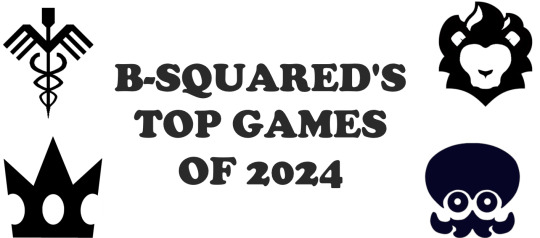
Another year has come to an end, and you know what that means! Reminiscing on all that I’ve played and engaged with this year but uh…times are tough and I’ve had to be even MORE selective with money for new games this year. Most of what I played was older games on sale so I can’t quite give you a Top 10 List of my favorite games from this year…best I can do is a Top 6. Regardless, let’s talk about the new games I DID manage to play this year!
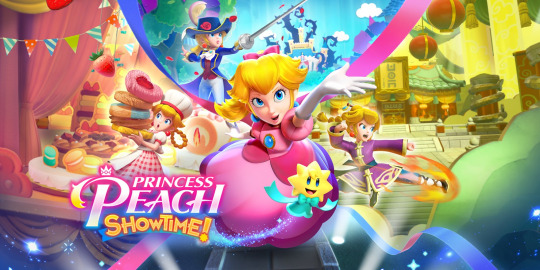
#6: PRINCESS PEACH SHOWTIME!
It’s been quite a while since Princess Peach got to headline her own game, but the surprise reveal of Princess Peach Showtime last year was a highlight. Compared to Super Princess Peach on the DS, a very by-the-books and easy platformer, Showtime has more going on with it from a mechanical standpoint and has a lot more potential moving forward as a possible franchise. Peach has to save the day by taking on a number of roles in magical plays, and so she’s constantly swapping between being a sword fighter or a superhero, alongside a mermaid or ice skater. Levels are relatively short and straight-forward, with each outfit having its own gameplay style. Admittedly the game is quite easy and a bit on the short side, but it’s a great way to showcase Peach in a way we haven’t seen until now. The developer, Good Feel, managed to make this game a real visual treat…though sadly the performance suffers a bit, like most late-gen Switch titles. On the whole I think this game has a lot of charm and personality, though I do wish it had a bit more meat on its bones. It really feels like a sequel could flesh things out a bit and be really special, but it’s a good foundation for the Mushroom Kingdom Monarch to really strike out on her own.
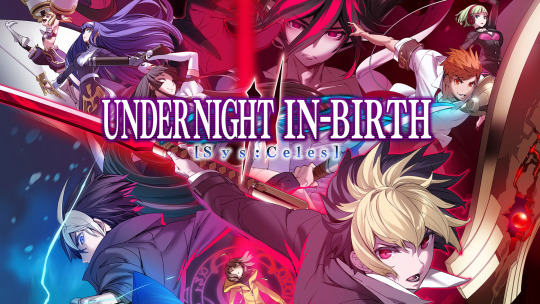
#5: UNDER NIGHT IN-BIRTH II [Sys: Celes]
I’m on a never ending quest to play as many fighting game franchises as I can, and French Bread’s own Under Night In-Birth series is one I haven’t gotten around to until now. The latest in the series, it furthers the overarching story while serving as the most polished entry yet. The game’s presentation is pretty stellar; with really clean hand-drawn sprites and some colorful, gorgeous backgrounds, coupled with a fantastic sound track to tie it together. Seeing as most fighters these days are fully 3D, it’s good to see French Bread holding down the fort with a 2D title. As far as the gameplay goes, it has an interesting mixture of accessible controls with a lot of hidden depth. There’s the GRD (grid) system that basically acts as a tug-of-war between both players. Every ten seconds or so the game tallies up who has the most GRD filled up and bestows a buff that leads to more damage and a potential combo cancel opportunity, making for an interesting pace where proper offense AND defense is rewarded. You earn GRD by attacking or defending, but can also use GRD as a resource for certain actions, so there’s some interesting risk and reward that takes this concept further than a more traditional super meter (which exists here too). Under Night II is also notable for finally bringing proper rollback netcode to this series, so it can finally have playable online. All things told, there’s a lot to like here, but as I’ve only recently gotten the game and haven’t poured THAT much time into it, I’ll have to leave it here.
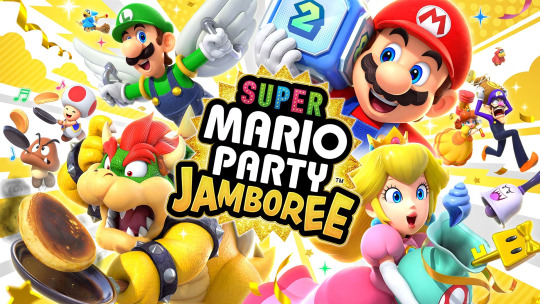
#4: SUPER MARIO PARTY JAMBOREE
Party games are often derided as nothing but shovelware, but the Mario Party series has been able to survive for quite a while, so they have to be doing SOMETHING right! The Switch games have seemingly gotten over the slump they originally found themselves in after a few experimental titles from developer ND Cube, with each game getting better overall. Super Mario Party Jamboree combines the newer minigames and partner mechanic of the first Super Mario Party on Switch with the updated online and remastered maps of Mario Party Superstars to make the definitive Mario Party experience. The partner mechanic has been further fleshed out, with partners doubling the effects of pretty much every space or board interaction…but that goes for both good AND bad outcomes. Coupled with partners being easily stolen by other players, there’s a lot more risk and reward with them in this game, so you’ll have to think strategically when it comes to using them. On top of that, this game also has some interesting new modes, including the return of a single player campaign, alongside an 8 player co-op mode AND a 20 player online battle royale race. It’s probably the most ambitious Mario Party in a long while, and it’s been a blast with friends…the only real downside is how long some of these games can last, drawing the parties out. All things told there’s worse problems to have!
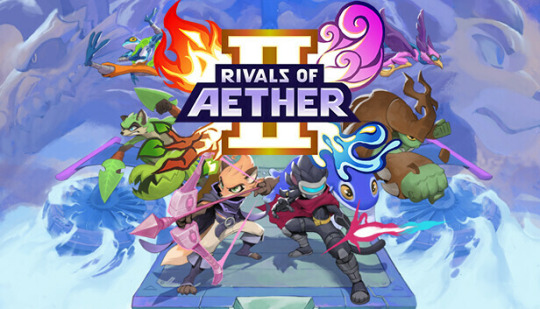
#3: RIVALS OF AETHER II
The original Rivals of Aether is one of my favorite fighters out there, and my favorite non-Smash platform fighter, so I was already pretty excited about a full sequel, but Rivals of Aether II has managed to meet all my expectations and then some. The game looks great in 3D with a really flashy style, but the game isn’t content with just a visual upgrade. Rivals II attempts to smooth over some rougher elements of the first game with some new mechanics, like grabable ledges on top of shields and throws, alongside further fleshing out each character’s moveset with even more specials. Being able to do special attacks from ledge, when rising from a knockdown, or during a grab adds a lot to a given character’s kit. Really, the characters themselves are the highlight here. Each fighter feels really unique both from each other and compared to other platform fighters. Kragg is a super heavy character who can alter the terrain of a stage at will, on top of having a solid projectile to dominate in a way most heavies fail to in other games. Newcomers like Fleet or Loxodont also bring some nice variety to the game. Fleet is a very agile zoner, floating through the air as she aims her bow and waits for the perfect shot to snipe her opponents, while Loxodont is like the lovechild of Super Smash Bros. Ganondorf and King Dedede, another heavy character who commands great range and can be a real juggernaut with his magma armor. Rivals II boasts rollback netcode for some great online and has a roadmap with tons of new modes and features planned too, with all post-launch characters being free. I really want to see this game be as successful as possible, and I’m looking forward to seeing how it grows. It would honestly probably be my Game of the Year…if my potato PC could run it better.
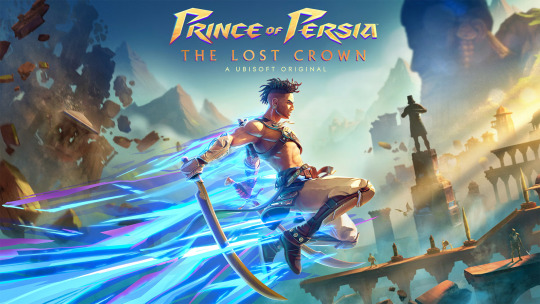
#2: PRINCE OF PERSIA: THE LOST CROWN
Earlier this year I played the demo for Prince of Persia: The Lost Crown and was immediately hooked. It took me longer to get to the full game than I wanted, but it ended up being worth the wait. I’m not really all that familiar with the franchise, but The Lost Crown was a really solid, seemingly standalone adventure that sadly didn’t seem to hit for most. The reveal of the game got a lot of mixed reception and its sales were lackluster, which is a damn shame because it’s one of the better games Ubisoft has put out in years. Considering how bad the company has been doing lately, on top of the toxic culture that enables abusers in high-up positions, I suppose this is just karma. All the same, I do want to highlight what some very talented people did at a company that clearly doesn’t deserve them.
Playing as an elite warrior working for the royal family, Sargon finds himself trapped in a mysterious mountain where time flows all over the place and he’ll have to fight all manner of monsters to get to the bottom of this mountain’s secrets as he attempts to save the kidnapped prince. The Lost Crown ends up being a fun mixture of 2D action game and Metroidvania or “search action” as some call it. My biggest compliment to this game has to be the overall feel of the controls. Sargon feels great whether he’s slicing and dicing foes or performing some tricky jumps. You gain more interesting tools and abilities as the game goes on and they really put you to the test at points. Boss fights are often full of spectacle and really pushed me at times, and I felt compelled to scour every inch of the map until I found everything. It does suffer a bit from the “Ubisoft Bloat” problem that plagues so many of their other titles, but it was a blast from start to finish and was well worth the time I put into it. We’re certainly spoiled for choice with solid Metroidvanias these days but it’s always great to see some AAA efforts sprinkled in with all of those indies.
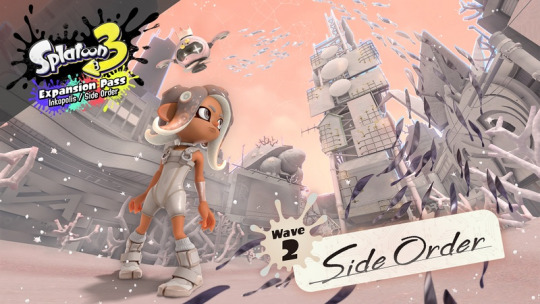
#1: SPLATOON 3: SIDE ORDER
This year saw the conclusion to Splatoon 3’s planned content, and as I went into with a previous post, one of the highlights of its roadmap was the paid single-player expansion. Side Order had been teased before the original game even released, and it was ultimately worth the wait. Once again starring Agent 8, the protagonist of Splatoon 2’s Octo Expansion campaign, players are trapped in a virtual world and have to repeatedly ascend the Tower of Order in an attempt to save the world from a looming threat.
While Side Order is still a third person shooter like Splatoon games past, it also incorporates rogue lite elements. Each floor is randomized with a number of different objectives, layouts and enemies to deal with. Adding to that, you get different power-ups for each floor and can eventually give yourself some really impressive builds that can bend the game so far in your favor it becomes a real power fantasy. That said, you’re expected to fail quite a lot, so each attempt gives you a currency to spend on permanent upgrades to make sure each future attempt goes by more smoothly than the last. Considering this is Nintendo’s first real take on this genre they did a great job, creating a satisfying loop that kept me coming back for more. I poured SO much time into this game over the year, to the point that my thumbs were hurting, and that’s honestly never happened to me before. I’ve had my qualms with Splatoon 3 proper, but the single player stuff has never been an issue, and Side Order continued that trend. An addictive experience that I couldn’t put down to the end, I’d consider this whole expansion to be my Game of the Year. Is it a little sad that it’s DLC and not a completely new game? Sure, I guess….but tons of people are gonna say that Elden Ring’s DLC counts for this so why not Splatoon?!
CONCLUSION
So here we are, another list of games done for another year! I really do wish I got to play more games this year but sometimes things just don’t really go that way. From indie hits like Balatro or Mouthwashing to other big hits like Final Fantasy VII Rebirth, not to mention the Paper Mario: The Thousand Year Door remake OR the Mario & Luigi: Brothership Mario RPGs…there was a lot there that I just didn’t have the ability to play this year. Hoping things look up next year because there’s never really been a shortage of great games to play. Obviously you can’t play everything, but it’d be nice to have a bit more variety in my picks for my top games of the year. I still had a lot of fun with what I DID play, at least. Stay tuned for my year-end wrap up for this year in gaming on the whole though!
-B
#blog#xb-squaredx#nintendo switch#GOTY#prince of persia#elden ring#mario#zelda#legend of zelda#rivals 2#video games#review
1 note
·
View note
Text
A Final Look at Splatoon 3
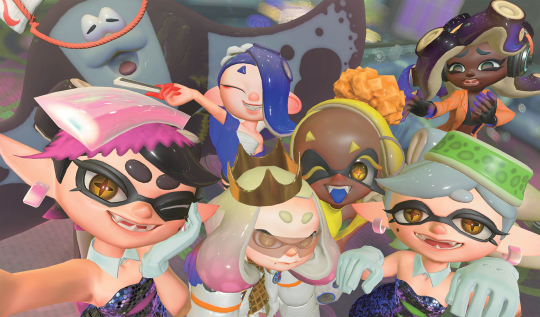
A little over a year ago I put out this post going over my frustrations with Splatoon 3 and my hopes that with another year of planned updates they could address these issues and end on a strong note. As of this writing, Splatoon 3 seems content complete without any plans to add any more substantial content, so it’s time to do a deep dive on how this game spent its final year of updates and come to terms with how this trilogy will close out.
REWORKS AND ROADMAPS
First off, let’s recap my main complaints from the original post and see just how Splatoon 3 addressed those points: I had issues with the game’s online stability, the seasonal update cycles, Salmon Run’s reward system and the quality of the multiplayer stages. To be honest…very few of these complaints were addressed, though I kind of expected that. The online experience in Splatoon 3 is largely the same now as it was back when I made that post, and any alleged improvements aren’t all that noticeable to me. Rooms still break down at random when matchmaking, and you still see a lot of players disconnecting at all points of a match. There was a patch not too long ago that seemingly tried addressing lag issues in matches, though I can’t say I noticed any major differences. For a while the game seemed to disconnect me and then punish me despite doing everything in my power to stomp out issues, though that did diminish greatly over time. Other than that, it’s the same ol’, same ol’.
I didn’t expect the seasonal content droughts to really be addressed and they also went mostly unchanged. In fact, we got LESS per season near the end with less weapons and stages. There was an attempt to improve the frequency of the various Challenges with wacky rule sets though. I’d still argue they were too infrequent and I was often not able to play even when they were active. There was a fun one where Rollers were super-fast, so that was neat I guess. Salmon Run also received a patch that awards players some silver and gold scales per shift if you do all your rewards, but that’s a bandage being slapped on that game’s horrid economy that comes too little too late. The shop still makes you buy things just to see what else is on sale and the prices are still FAR too high most of the time. There’s only one thing I think this game really did that felt like they were responding to criticism and that was regarding the stages.
For one thing, many of the later stages added post-launch got better with time. Starting with Drizzle Season 2023, I think the devs were finally willing to budge on some of their early design decisions with stages. Crableg Capital had a lot more verticality for starters, with Shipshape Cargo Co. having a lot of wide open space and multiple ways to get around and into the enemy side of the stage. From there Robo ROM-en was a really fun stage with a good theme and an interesting lower route that allowed you to actually flank your opponents. Marlin Airport made use of fans that would move platforms around for an interesting stage gimmick too. Our final brand new stage, Lemuria Hub, was an interesting take on asymmetrical stages with more moving platforms as a hazard to make it stand out. Admittedly, Bluefin Depot’s return was a bit underwhelming but it still has a very unique layout that helps it stand out. But the real talking points here were all of the stage reworks.
Starting with version 5.1 Splatoon 3 would start doing stage reworks as they have done in the past two games. First up was Mahi-Mahi Resort, which ended up addressing a lot of my problems. The stage was made a lot bigger even before the water levels dropped, with the side routes on the left side being made bigger and a better flank route overall. It still doesn’t hold a candle to Splatoon 1’s iteration of the stage but it was a great step forward. That said…I think we kind of peaked there. The subsequent reworks for Mincemeat Metalworks and Undertow Spillway were a lot less impactful. They did make the stages a bit better with extended routes out of spawn or slightly reworking the middle of the stages but they were still largely the same and barely count as a rework in my mind.
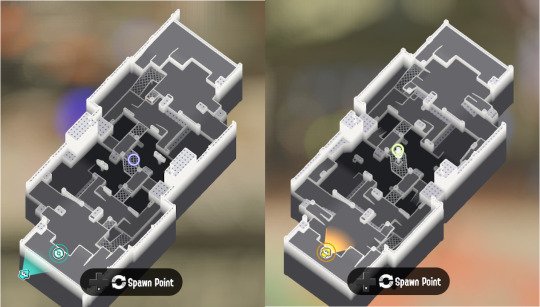
(Compare the launch version of Mincemeat Metalworks (LEFT) with the reworked version (RIGHT). Sure they're some changes, but at a glance could you even notice?)
The Version 8.0 update ended up changing MULTIPLE stages at once though. Hammerhead Bridge and Barnacle and Dime would also receive reworks, alongside multiple other stages getting smaller changes across a few of the modes. That said, these final reworks were a bit all over the place. Barnacle and Dime did add a new route on the left of the stage and slightly reworked paths out of spawn which was appreciated, and Hammerhead Bridge did extend the routes out of spawn a bit alongside a one-way drop into the middle of the stage on the right side of the stage…but the stage itself was still a glorified corridor. In the other ranked modes (aside from Splat Zones), these changes were barely notable. When it comes to the other assorted changes, some ended up being more notable than expected. Eeltail Alley added some blocks that allowed you another way to get up to the center bridge (though only in Turf War), and the changes made to the lower flank routes on Museum d’Alfonsio and Brinewater Springs were pretty major changes. Adding a random block here or there on Manta Marina…doesn’t really set the world on fire though. Oddly enough, Um’Ami Ruins received a lot of changes that I count it as an unofficial rework, getting a completely revamped right path out of spawn with a new ink rail to get to the middle of the stage faster. To be honest, this game did end up changing more stages than I thought they would, and we are definitely in a much better place with stages now then at launch or even a year ago. But at the same time, the issues these stages faced are systemic and would take way more time to change than a simple patch would allow. I can only hope that Splatoon 4 isn’t afraid to let players ink walls and have more routes to get around. I feel like making sure stages could be modified for extra modes like Big Run or Tricolor Battles, alongside all of the other ranked modes led to stages feeling less dynamic and interesting across the board. Still, as perhaps my biggest beef with this game, I appreciate the effort. With that said though, let’s talk about some of the NEW stuff the final year of this game’s content cycle would give us.
SPLATOON GOES ROGUE(LITE), WITH A GRAND FINALE
Teased way back before the game even officially launched, the single player expansion was hotly anticipated…and they ended up taking quite a bit of time to release it. That said, I think it ended up being well worth the wait. Side Order ends up serving as a bit of a follow-up to the storyline from Splatoon 2’s Octo Expansion while also being a very experimental side mode. Side Order is a roguelite adventure, with Agent 8 having to scale a tower in a digital world in order to take out the embodiment of order itself to save Pearl and Marina. Players start with a weakened main weapon but each floor they ascend gets them a random power-up that can help turn the tables. For every given “run” of the game, failure or not, you get currency to purchase permanent power-ups to ensure the next run goes smoother. It ended up being a lot of fun with some really addictive gameplay that kept me playing until my thumbs hurt. While maybe not quite as large as Octo Expansion was, it was definitely filled with more than enough to keep me coming back again and again until I cleaned my plate and did everything. All the power-ups cataloged, runs with all the weapons, and even the special run with the Order Octo Shot with no upgrades. For Nintendo’s first crack at a rogue-lite I’m happy that they nailed it so well, and it makes me hopeful future Splatoon games continue to experiment with their single player content. If nothing else, Splatoon seems to always nail their single player modes.

That said, as the end approached it was clear that we’d have to say goodbye…and the game did everything in its power to ensure the final main Splatfest would be one to remember. The Grand Festival didn’t just feel like the finale to Splatoon 3 but a celebration of the entire trilogy. All three main idol groups came together to form the Now or Never Seven, performing for an extra-long Splatfest that lasted three entire days. For this event players were also transferred to a completely different locale this time around, the Grand Festival Grounds near the desert crater where our story first began in this game. It felt like a real full-circle moment, and the fact that the developers went and made a HUGE venue filled to the brim with characters and little details that would only be used for three days was pretty impressive. We live in a world where game devs do everything they can to reuse assets and make sure players see everything they worked hard on, and a lot of this stuff was only available for three days! You know, assuming you don’t own an amiibo of the idols.
Adding to that, prior to this event we got a sneak peak of the final Tricolor map, the Grand Festival Bowl with the final Big Run of the game. Once again, introducing content that wouldn’t be readily available afterward, it was a cool way to tease the stage. The prompt for this final Splatfest was also an interesting one, asking players what they valued most: the Past, the Present, or the Future, with the three idol groups all picking a side to represent them. In the end though…it was a blowout. The power of nostalgia dictates that people value the Past more (or maybe they just like the Squid Sisters the most?), and while Present had a decent showing…in the end Future ended with zero points. How fitting that the final Splatfest of this game would once again demonstrate how hard it is to balance three choices without creating a third wheel that doesn’t really contribute to the greater outcome. That bummer aside, I think the Grand Festival was a really special sendoff for the game on the whole. It’s worth noting we’ll still see reruns of some seasonal Splatfests as time goes on, so it isn’t the TRUE end to the game, but its close enough. That said…as good as this finale was, I do think the true final state of the game does come up a bit short.
CLOSING THOUGHTS
With confirmation that no more major updates were planned for this game, fans will have to more or less accept Splatoon 3 for what it IS rather than what it COULD be. I do find it strange that, for a game as obsessed with the number 3 as Splatoon 3 is, we never did get third kits for weapons at all. It is worth noting Splatoon 3 has more weapons than either Splatoon game before it even WITHOUT third kits though, so I’d argue there is still a lot of variety. That being said, the lack of more options for some weapons can really hurt, especially when you consider the long wait some weapons had to even get their second kit (Bamboozler mains I feel for you!) thanks to the seasonal updates. The fact that we got brand new weapons such as the Decavitator right at the end of the game’s life with both kits at once stings all the more.
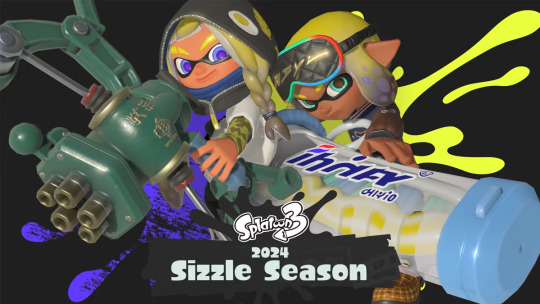
Considering how much work this game put into multiple versions of stages for certain modes and events, I am a little shocked a final update didn’t let players do private room Tricolor Battles or even be able to add on the modifiers from the random Challenges. Seeing as Shifty Stations became fair game after the Final Fest of 2¸I don’t see a reason for not implementing something similar for the likes of Tricolor stages, or even Big Run stages. I understand that making something limited-time only makes it feel more special (I even just praised this about the Grand Festival), but considering what past games have done it’s hard to feel like 3 isn’t dropping the ball a little bit.
Just so we’re clear here, I still think Splatoon 3 is a game bursting at the seams with content. Between two solid single-player experiences, by far the most stages and weapons in the series (especially if we’re counting variations for modes like Big Run or Tricolor Battles), a more fleshed-out co-op mode with Salmon Run, it even manages to have smaller stuff like a card game hidden within. Both Splatanas and Stingers are interesting new weapons and some of the other new weapons added later on in the game are pretty interesting. I’ll still hold firm that the Zipcaster is one of the coolest special weapons they’ve ever made. The game has a lot of technical polish and the visuals, even if they aren’t a huge leap from past games, feel all the more refined. I put hundreds of hours into the game across these two years and some change, and I enjoyed the vast majority of it. Playing with friends on the weekend was a pretty common activity, as opposed to the other two games that eventually boiled down to dusting it off every so often for a Splatfest and then turning it off again for months at a time. Splatoon 3 is a great game and in a lot of respects a great finale to the trilogy, but I won’t deny I still feel a little let down.
We have no idea what the future holds for this series now. Final Splatfests have had some impact on the next game in the series. Marie having more of a role in 2’s story, or the entire “chaos” theming for 3 on the whole…so who knows how Past winning will impact the hypothetical Splatoon 4. The devs have mentioned the trilogy closing the chapter on the current plot, so I wouldn’t be surprised if we saw a total clean slate moving forward. Maybe we’ll get a game set in the past to get more of that juicy lore. Maybe we’ll get a game that’s geared more towards design elements from the first game even! One can hope, I guess. The Splatoon trilogy has definitely had its share of ups and downs, so I don’t want to paint this as something that only 3 had going on. The first game was at times an unbalanced mess, since it was a new IP that wasn’t sure what it wanted to be yet. The second game got rushed out the door to hit the launch window of the Switch too, and had its own share of strange design decisions (here’s looking at you, Sting Ray). With 3 I had hopes the devs would finally have the time and resources, not to mention past experiences to draw from, to make the best game in the series and…3 was not that at all. But it was also a game made during a pandemic, with a new Nintendo online infrastructure, on top of being on aging hardware that may or may not have once had a “pro” version in development. All things considered I think Splatoon 3 came out OK. It still delivered on a sense of style that stands out from the rest of Nintendo’s games, and kept me coming back for more even with all of these issues, so clearly they were doing a lot right. Whatever the future holds, I’ll always be down to make a mess with some ink.
Stay fresh.
-B
11 notes
·
View notes
Text
The Many Missteps of MultiVersus
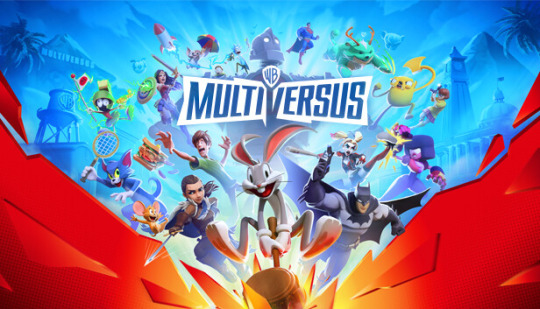
In 2022 Warner Bros. released a new platform fighter that managed to make quite the splash. MultiVersus, a 2v2 focused free-to-play title, found impressive success after it entered its open beta with well over 10 million players within the first month. The game was praised for its colorful artstyle that blended together characters from all sorts of different mediums, from the Looney Tunes to Gremlins, to the likes of Rick and Morty with Game of Thrones; it was a crossover that seemed like it had potential to rival Nintendo’s own Super Smash Bros. But then just as suddenly as the game arrived on the scene…content dried up, the devs were silent and at the conclusion of a rather underwhelming season two it was announced that the open beta was concluded and would re-launch within a year. This struck many as odd, as the game’s beta period was quite long and featured a multitude of balance patches, new content and characters being added, as well as a plethora of monetization options that certainly made it look like a full release. That year has come and gone, and MultiVersus has re-launched…but something has clearly gone wrong, as we enter a multiverse filled with a multitude of mishaps.
A REGRESSIVE RE-LAUNCH
In the first ten minutes of me booting up the re-launched MultiVersus, I found myself constantly repeating the same question: why was this feature better in the beta? For starters, the tutorial, while a bit more robust with a true level to run through as you’re taught the basics, lacks the advanced tutorials found in the beta. No more ways to learn about directional influence or how certain moves are meant to function. This is especially puzzling when this re-launch added new mechanics, such as the parry and dash attack, so you’d think they’d want to make sure people know they exist! Following this, I went into training mode, but was dismayed to see that you could no longer go into training with every character regardless of having unlocked them. In a world where every fighting game gets DLC and being able to train against them or even see how they play requires buying in, MultiVersus allowing you to “try before you buy” felt really revolutionary and fairly consumer friendly. The same held true for local play, making it a godsend for offline tournaments that would no longer have to rush to unlock everyone in preparation. That BOTH of these features are gone is troubling on its own, especially when you factor in changes to progression and monetization, but I’m getting ahead of myself here.
As I went into training mode I noticed that ranked play was present on the menu, but grayed out with a “coming soon” message. The original beta eventually got some form of ranked play briefly before the beta’s shutdown, and to not see it back again is disappointing. There were also a number of options and settings that were either taken out or adjusted from the beta, such as being able to swap the inputs for your basic three-hit combo and your strong attack. I used that feature since I felt the default was a bit awkward, but now I have no choice but to leave it as it is. Training mode no longer lets you change controls, and it seemingly takes longer to swap characters while in that mode. Another puzzling change is that stats from the end of battle are no longer there, such as listing who got the most ringouts or who did the most damage, making it difficult to tell how effective you really were in a fight. You can’t even see which players agree to or decline a rematch, and there’s no longer an option to “toast back” your opponent if they toast you, making it harder to give them props for a good fight. In general the UI is…different, and while somewhat improved it still feels somewhat lacking. You no longer have to move a very slow cursor for individual menu items on console, but there’s still parts of the UI that make it feel like it was made for a keyboard and mouse first and foremost.
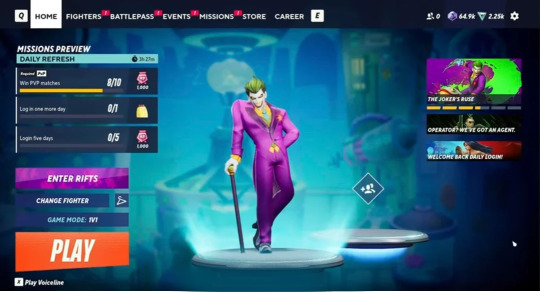
Really, I could list out all of these changes all day, and to be fair most beta versions of a game are going to see changes for the full release. But to see so many changes that are basically just whole features being taken out is a concerning first impression. Now, about a week into the game’s re-launch an update has gone out that now allows everyone to play as every character in training mode, though not in local battle. Player First Games has been quick to respond to feedback and are currently attempting to put back in as many of these features as they can…but that kind of begs the question…what were they doing for a full year if this is the finished result?
SACRIFCED AT THE ALTAR OF GREED
An issue this game has had since day one is that Warner Bros. is the publisher, and they’re among the greediest when it comes to Western game publishers. From prioritizing DLC rather than fixing poor PC versions of various Batman Arkham games, to adding in loot boxes to a single player game like Middle Earth: Shadow of War, I knew things weren’t likely to be great. The beta was rife with terrible monetization. They gave you a fair bit of the free currency for characters right away to trick you into thinking the game will be more generous than it actually is, because after all…the first hit is free but once you’re hooked you have to pay for the rest. We had an abundance of costumes costing twenty dollars or more, with characters at seven dollars a pop. I knew that the chances were slim that the monetization would get any better, but I wasn’t really expecting it to get worse.

For starters, characters now cost ten dollars each…at least for the older beta characters. A new character like Joker costs about $12.50. That’s not even getting into the changes to the free currency. In the beta you had Gold, which could be used for characters, perks and a small handful of cosmetics. For this re-launch, they’ve seen fit to cut Gold entirely, but ADDED three new currencies to replace it. There’s a separate currency for perks and a separate one for fighters, with a new “prestige” currency that you only acquire by…getting cosmetics, which then lets you get a small handful of EXCLUSIVE cosmetics. Speaking frankly, it’s disgusting in just how brazenly greedy it all is. Before, you had options of what to spend your hard earned Gold on, and you’d gain some for every match played. Sure, it was a drop in the bucket, but every bit helped. But with these separate but equal currencies you’re far more limited. Once I’ve bought up all the perks I want that perk currency just sits there, useless and unable to be converted into anything else. Same goes for character currency, which also takes way longer to acquire. You only get it for specific events or character mastery, and even then you’ll get like 100 of it at a time, which doesn’t mean much when every character costs THOUSANDS of the stuff. In the beta, characters cost varying amounts of Gold; easy to use characters like Garnet or Taz were cheaper at 1500 Gold, hard characters like Tom & Jerry were 3000 Gold, and everyone else was at 2000. But now you’ll find EVERY character from the beta is 3000 of the character currency, and a new character like Joker costs 6000 of it. I already disliked the idea of pricing characters differently, since it kind of sets them up to be compared. If Joker costs more than everyone else is he just better? For the record, for the past two weeks or so since release I’ve done all my daily and weekly missions and about as much of the PvE stuff as I can, and that’s netted me a little over 11,000 character currency. I’ve gotten one character from the old beta, as well as Joker, leaving me with roughly 2000 currency I can’t do anything with for some time, and knowing future characters are going to cost more I’m more likely to hoard it than anything else. Adding to this, at launch you only earned battlepass XP by doing your daily and weekly missions, severely curbing just how fast you could advance through it. A later patch granted you a comically small amount of XP for a win and even less for a loss, though those amounts were also increased with yet ANOTHER patch a bit later. Nothing’s been done with character currency, meanwhile, so hoarding continues to be the way to go there.
You’ll see people try to defend this, stating that this is just like the good old days where you’d unlock everyone by playing, but the time investment here isn’t comparable at all. A game like Super Smash Bros. Ultimate infamously locked the bulk of its 70+ character roster away, leaving you with only the first game’s 8 initial fighters, but it took me way less time to unlock the entirety of that game’s roster than it has to get TWO characters in MultiVersus. I have it better than many, as I got to retain anyone I unlocked in that beta period. I have roughly half of the roster at this point, but for anyone starting fresh all you get is Shaggy and four rotating characters every week. I remembered when completing the initial beta’s tutorial got me Wonder Woman for free, thinking it was super generous…little did I know we peaked there. In all honesty, the initial closed beta was even more generous so this is the SECOND time they’ve slowed everything down to a crawl. But nowhere is this horrible, manipulative design more apparent than with the PvE mode added here, the Rift.

At first glance, The Rift seems like a lot of fun. A full on campaign mode with mini-games and boss fights, with plenty of ways to modify fights and give you a lot of things to do cooperatively with friends rather than just fight against each other online. But as with everything else here, fun has been sacrificed at the altar of greed. For starters, to get very far in the mode you’ll need to unlock and level up Gems, power-ups you affix to your characters that can have a range of effects. These help to make you stronger and fight back against increasingly tough missions, but you’ll quickly realize how much they drag things down. You see, there’s multiple difficulties for each campaign in a given Rift, and you are outright gated out of certain difficulties if your Gem level isn’t up to snuff. Even then, some fights get so tough at the higher difficulties you might not be able to win without getting your Gem levels up even higher. You have two options to get stronger: you can either go through every mission and complete the various sub missions within, some of which are fairly tedious to do and might require a character or skin (or a specific skin of a specific character) that you don’t have….or you could just slide them some money to juice the Gems that way. So much of the Rift’s progression is designed around a grind that wears you down so you just shell out and make it stop. It’s all about the path of least resistance, and BOY does this game resist you a lot. If you want full completion on a given Rift you’ll have to do almost every submission in every fight. It’s easier if you have a friend with you, as every fight has a submission for doing it with a co-op partner, but if you don’t have a friend to play with you’ll really struggle to fully complete a Rift. The devs even got into some hot water when it was found that later difficulties would have a limited amount of lives you had to budget each day, with the option to buy more lives with real money. They lie through their teeth that this is some bug, despite this being a part of the in-game shop and has dedicated UI elements for it, but even if it was a bug, it certainly fits in with the manipulative design.
It became pretty clear early on that the Rift mode just wasn’t going to do it for me, but you’re forced to contend with it if you want to progress your daily missions among other things. They even have an event going on that will reward you with the next character, The Matrix’s Agent Smith, if you can defeat 20 bosses in Rifts…but that will require a significant amount of time and effort…or money, of course. That would mean doing pretty much every Rift on every difficulty, and later Rifts actually take away one of the easier difficulties, just outright forcing you to contend with the harder versions of these same handful of missions over and over. This could have been a great contender compared to the Smash Bros. single player experiences, but they’ve only succeeded in making a mode I’m loathe to even look at. But hey, even if the monetization is awful, and the new mode is a grindy slog AND this full release is missing tons of features from the beta, as long as the core gameplay is fun this is all worth putting up with….right?
TOO FAST OR TOO SLOW, NEVER JUST RIGHT
The original beta for MultiVersus was fun, but flawed. It had a lot of interesting ideas, but with some shoddy execution. I had hoped that with a year or more to polish things up, the game could at least come back with some kinks ironed out…but what we got instead is practically a different game in some ways. For starters, the beta was notable for being a bit “slippery” for people. You had a great amount of air control and your dodge was fast and easy to spam over and over. So it was difficult to really catch up with opponents and chase them down. Adding to that, many attacks both came out fast and had barely any recovery, meaning you could just keep swinging away with no one able to punish that behavior. This re-launch has slowed the game down considerably…but now it just feels awful to move around. Some of this might be down to taste, but most players seem to agree that something is OFF about the game now. Some have noticed that the input buffer seems ludicrously high, storing inputs for upwards of 30 frames. For reference, Smash Ultimate has a buffer of around 10 frames, and people haaaaaaate how that feels. To be fair here, I think slowing the game down in some respects actually was the right call. There were too many actions in beta MultiVersus that were basically instant and really hard to punish. Finn could throw out a gem and instantly teleport over to it, as an example. Finn’s infamous backpack spin and Taz's side special spin were also notoriously hard to deal with as if you dodged them they’d recover and be able to do it again before you could stop them. The online for the beta also got…really bad at times, with characters constantly teleporting around and acting weird due to instability. They’ve allegedly upgraded the netcode for this game, and while I still see a fair variety of issues (such as frequent desynchs), the online experience DOES seem better. A slower game makes it easier to deal with stronger moves, while also making the online experience smoother….but the problem is that they didn’t stop there.

(Credit to MadMikeYT on Reddit)
In addition to slowing the game down so much, they also increased the size of every character by a good deal, all without changing the sizes of stages at all. The camera is also zoomed in a lot more than it used to, making things seem even more claustrophobic, especially on certain stages. But I think the single worst change here was the addition of FAR more hitstun to virtually every single move in the game. All of this combined makes for a game that’s incredibly different in feel and pace. Beta MultiVersus was slippery, making it hard to run someone down and start your offensive, but the full release of MultiVersus is a sluggish time where you’re in constant danger of being stuck in a near-infinite loop that’ll lead to your death. As a result of this, 2v2 matches feel like crapshoots, where you could just constantly get ping ponged around and suddenly have a high damage percentage seconds into a match. 1v1s run the risk of being locked into long combos that can lead to early kills too. With the more recent patches, they have attempted to look into these issues a bit, such as reducing the hitstun in 1v1s only, but also changing a number of moves in an attempt to stop all of the infinite loops and force people to get more creative with combos. That said, they still have a lot of work to do.
On that note with these patches, the balance is clearly lacking this early on. I’m not a competitive player by any means so I can only say so much about it, but the consensus seems to be that the game is still a bit of a mess, not really an improvement from the beta. Certain characters seemingly got touched up and greatly improved like Taz or Black Adam, while characters like Velma got completely gutted. Curiously, some of the reported best characters in the game like Bugs, Harley and Wonder Woman, are barely touched despite so many other characters clearly needing more work to bring them up to par. I’m still baffled at how this game has tried to balance moves with cooldowns in a very uneven way. As an example, Wonder Woman’s lasso had a cooldown in the beta, despite it not being THAT powerful, and then it was removed for the full release….and now it’s back again after the first patch. Which is it? Why does Velma’s down special have a nearly TWO MINUTE cooldown when the buff she achieves with it doesn’t last more than a few seconds? There’s also the matter of the Iron Giant, who was found to have tons of infinites and exploits, leading to him being taken offline for well over a week before returning. Now, I don’t expect any fighting game to ever be perfectly balanced, especially at launch, but for things to be so bad you have to bring an entire character (that people might have paid MONEY for) offline for several days again begs the question…why did this game release in this state?
WHERE DO WE GO FROM HERE?
At this point, MultiVersus has been out for a few weeks, with a few patches thrown out to address some issues, with more along the way. I’m sure with time bugs will be addressed and certain features will be added that were missing. Player First Games have been pretty up front that they ran out of time with this re-launch and had to prioritize certain things to meet the deadline. The upgrade from Unreal Engine 4 to 5 is also likely contributing to some of the problems in this game. I’m not a programmer but I can assume performing an engine switch in just a year’s time is a tall order for any studio, let alone a smaller, less experienced one.
I want to make clear that I’m not going after anyone from Player First Games. The ones that are in the trenches doing testing and bug fixing and putting their all into designing characters are just doing their jobs to the best of their ability. I’d never accuse anyone here of being lazy or phoning things in. I truly think this dev team wants to make the best game they can, but they are also saddled with a publisher that is known for screwing over games with their greed, not to mention the whole of Warner Bros./Discovery being on fire right now and having to cancel projects for tax write offs and trying to shake off debt. I can only imagine the issues going on behind the scenes that the devs are forced to endure when they just want to make a fun fighting game. I’m sure that no one is more frustrated with the state of this game than the people working on it day and night.
That all being said though, this is still a game that people have spent money on. A game that people are trying to compete in professionally. Just because I can be understanding of the circumstances surrounding this game that doesn’t really change the fact that this full release is littered with bugs, predatory design and gameplay changes that severely impact my enjoyment. I’m sure others are in a similar boat; I WANT this game to succeed, but I also don’t want to make excuses for it. Time will tell if Player First Games can stomp out some issues and keep a decent content stream going for this game, or if people will get burned out or impatient and just move onto something else. With a new Nintendo system on the horizon, that just means a new Smash Bros. game is a matter of “when” and not “if.” There’s also more competition with games like Nickelodeon All Star Brawl 2 or the upcoming Rivals of Aether 2 that’ll be competing for the attention of platform fighter fans everywhere, so…the clock is ticking. That’s kind of the rub with live service games; you only have so much time you can dedicate to them and there’s SO much competition. If something better comes along, people WILL flock to it. The always-online nature of this game also worries me with the fact that one day Warner Bros. could just flip a switch and take it offline forever. Hell, they’ve already done that once! I think there’s still time to improve this game and maybe down the line they can redeem themselves…but this is already their second chance and I’m not sure they’ve done anything to warrant a third.
Until next time,
-B
#blog#xb-squaredx#multiversus#warner bros.#adventure time#DC comics#batman#superman#rick and morty#game of thrones#fighting game#free-to-play
3 notes
·
View notes
Text
B-Squared's Belated Top 10 Games of 2023

Well, this has come out…a lot later than I wanted to but life gets in the way. 2023 had a lot of fantastic games in it…but sadly I didn’t get to very many of them. So many great games, from the indies to the AAAs and everything in between. As of now I’ve had to be a bit more careful with money and still haven’t gotten my hands on either a beefy PC to play all the new games or a next-gen console, so my options are somewhat limited…which will be reflected in this list. So for anyone asking why Baldur’s Gate 3 or Alan Wake 2 or Spider-Man 2 or anything else isn’t on this list…I had no real means to play it. That said, I still enjoyed the bulk of what I played in 2023, so I figure it’s better late than never to celebrate those games.

#10: F-ZERO 99
F-Zero is a franchise I have limited experience with; I’ve played far more of Captain Falcon in the Smash Bros. series than any other F-Zero game combined. Regardless, the release of a new game after a near 20 year hiatus certainly had my attention. F-Zero 99 is a new take on the original game, after the popularity of Tetris 99 on the Switch. Up to 99 players race together in a battle-royale fashion, aiming to take first place…or at least survive to the finish line. I’ll be up front that I’m terrible at this game and didn’t play that much of it, but I can recognize that it was a fun spin on an old idea, giving players ample ways to try to play catch up in the chaotic, high-speed races, and for those that are more well-versed in F-Zero it served as a way to scratch an itch that has been bugging them for a good long while. Its unclear what the series’ future will be but I’m hopeful that the overall positive reception to this free-to-play title means there might be more to come for F-Zero sometime soon.
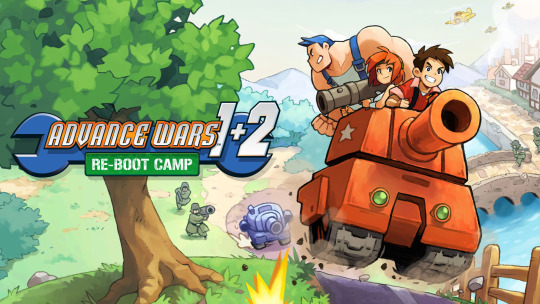
#9: ADVANCE WARS 1+2 RE-BOOT CAMP
As long as we’re talking about older, revived Nintendo franchises, we may as well talk about Advance Wars. After Fire Emblem really took off worldwide, this series has been rather dormant over at Intelligence Systems. Due to real world events, this release was delayed by about a year, but I’m glad that the remake of the first two Advance Wars games helmed by Wayforward was able to finally release. Overall, these are very faithful remakes with some great new bits of animation, voice acting and music, with players able to compete in the campaigns or wage war locally or online in the multiplayer modes. Some people weren’t a huge fan of the visual style in this remake, or felt that it could have done more, but ultimately I’m just happy to see this series come back again and I think Wayforward did a great job. The endless horrors of war have never been so fun!

#8: HOLOLIVE FAN GAMES: (HOLOCURE: SAVE THE FANS AND IDOL SHOWDOWN)
You might remember from a while back that I’m a VTuber fan, especially the ones over at Hololive. There’s been a number of really fun fan games that have released over the years but this year we got two of them released that were right up my alley…well, kinda. First off we have Holocure, a “bullet-heaven” game in the same vein as Vampire Survivors starring the Hololive girls. It’s technically still in early-access and has been out for a while…but the STEAM release was in 2023 and that’s when I first played it so it counts. It’s a very fun game with cute pixel art, great remixes of Hololive songs and is filled to bursting with tons of interesting references to these streamers…which makes it almost completely incomprehensible to non-fans, but that’s beside the point.
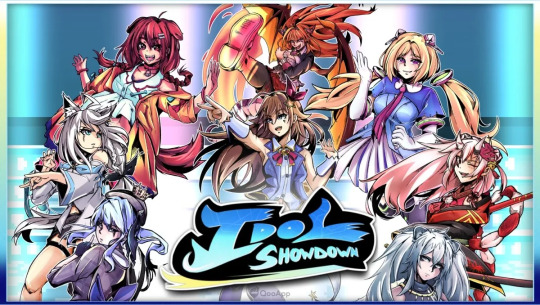
We also received a Hololive fighting game in Idol Showdown this year, which I also enjoyed for the most part. The character movesets are filled with just as many references, with some very expressive sprite work on both the playable cast and the backgrounds. A rogue like Digital Frontier mode adds to the stuff to do in the game if pure fighting isn’t for you, and it’s even received some free DLC characters as time has gone on. I do wish the game was a bit more optimized in some regards, but it’s otherwise a really fun game that managed to combine two of my interests together into one package. So I’m counting both of these games together under the umbrella of being Hololive fan games. Give them a try….and fall down the rabbit hole.
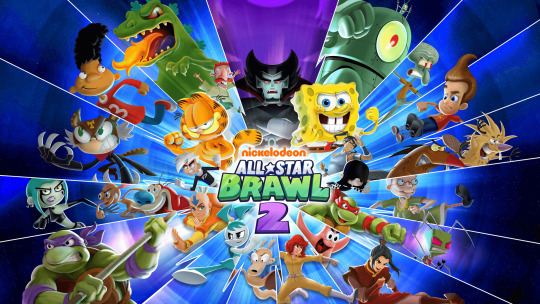
#7: NICKELODEON ALL STAR BRAWL 2
Speaking of fighting games, I was pleasantly surprised by the reveal and subsequent release of Nickelodeon All-Star Brawl 2. Despite being excited by the prospect of the first game, I wasn’t all that fond of it by the time it released. It was a barebones experience, devoid of any voice work for these iconic characters (often with iconic voices), looked bad, ran worse at times and most of the cast had very same-y, uninspired movesets. So I’m very happy to say that the sequel is everything the original game should have been.
NASB 2 is a gigantic improvement in every way; it looks a lot better, the voices are here from the get-go now, there’s a huge single player campaign and the cast this time around all feel FAR more fleshed out and distinct. I still have some qualms with the roster overall, but I’m glad the team at Fair Play Labs (and the few members of Ludocity on this project) managed to create something that can appeal to both hardcore platform fighter fans and fans of the Nick characters. Sadly, I think a lot of people felt burned by the last game and didn’t even give this one a try, but trust me…this really is one of the more inventive platform fighters out there. The Slime mechanic itself is kind of worth the price of admission, being able to augment your moves, burst out of combos, or spend on a huge super move to send foes flying. The single player is also filled with fun references and a fair bit of things to do as you fight various minor enemies and bosses from across the various Nick shows. While a bit bug-riddled at launch and my potato PC can barely handle it at times, I had a blast with it, and I hope that people can eventually give this game a chance.
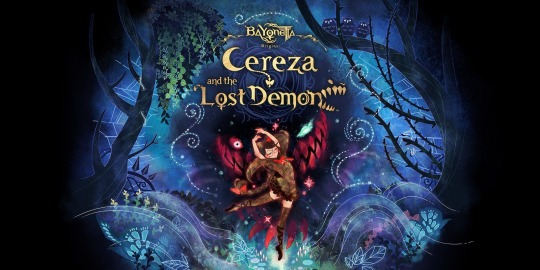
#6: BAYONETTA ORIGINS: CEREZA AND THE LOST DEMON
Oh hey and speaking of burning fans with the last installment and giving things a chance…yeah Bayonetta Origins: Cereza and the Lost Demon was always going to be a tough sell. Even if Bayonetta 3 had been well-received by fans, taking a series known for its over-the-top arcade action and extremely sexual heroine and pivoting to a fairy-tale aesthetic and relatively simple puzzle solving and exploration wasn’t ever going to have a wide appeal. If you don’t like the other Bayonetta games you might end up enjoying this, but then why would you even be looking in this game’s direction? And conversely, if you love the other games, this one is so completely different there’s no guarantee you’d enjoy it. Truly, Bayonetta Origins is a game for an extremely small niche of players, but I was willing to give it a shot and ended up quite enjoying it. In fact, I think it’s one of the best games Platinum has put out in years.
Taking place when young Cereza was still a witch in training, players have to guide Cereza and her first demonic summon, Cheshire, through a maze-like forest infested with dangerous fairies. The game itself feels inspired by something like Brothers: A Tale of Two Sons, alongside Platinum’s own Astral Chain. Players control Cereza and Cheshire simultaneously, using each control stick to guide them through puzzles and the occasional combat encounter. Cereza uses her magic to hold enemies in place or manipulate the environment while Cheshire is in charge of tearing enemies apart. The cel-shaded storybook aesthetic is very charming, making for a game that I think is a lot easier on the eyes than Bayonetta 3, and the coming-of-age element of Cereza learning to stick up for herself and get stronger gave us a fairly well-told story (which is kind of a rarity for this franchise). Outside of a map that isn’t all that helpful, and the fact that it’s still connected to Bayonetta 3 in some strange, confusing ways, this is far and away the best Bayonetta game developed for the Switch, and yeah, I’m just as surprised as you are.
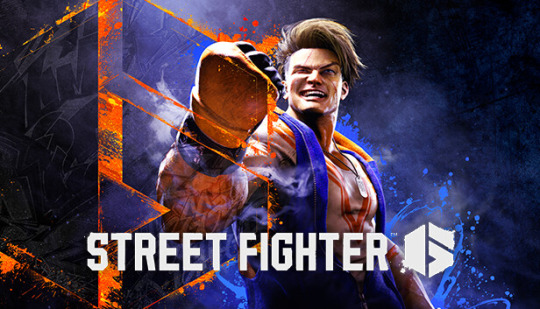
#5: STREET FIGHTER 6
Once upon a time Capcom was considered to be the kings of fighting games, but everything changed when Street Fighter V came out in such a barebones, awful state that the FGC at large moved onto other things. But 2023 was the year Capcom returned to take their crown back, and MAN is Street Fighter 6 a massive return to form. Now, I should stress my time with this game has been limited; I’ve played with a friend with their own copy of the game as well as poured over the PS4 demo, but I don’t actually own this game myself yet. If I DID, this would probably be a bit higher on this list honestly.
SF6 took a long hard look at the complaints levied at the previous game and did everything they could to turn things around here. Rather than launching with no arcade mode and later adding a lackluster story mode, 6 launches with a massive World Tour campaign, giving players the ability to create their own character and dive into the world of Street Fighter in what is ostensibly an action RPG hidden within the greater game. Rather than give us the divisive V-System that encouraged passive play and largely locked away each character’s strongest tools, the Drive System in SF6 gives players tons of way to engage with the game right from round start and encourages both aggression and proper resource management. At high-level, SF6 becomes a tug-of-war between players doing everything they can to whittle down their opponent’s Drive Gauge, while holding onto their own, and then place them into checkmate when they go into Burnout. The game’s new, more realistic artstyle took some time to grow on me personally, but I think they ended up making it work, though admittedly I’m with everyone else in stating that the OST for the game is a bit lacking. Thankfully, they nailed it where it really matters: the roster is filled with some awesome new faces (Marisa my beloved) and manages to make the veteran fighters feel fresh, and the cherry on top is an almost impeccable online experience. I’m glad Capcom learned from their mistakes, and the result is one of the best fighting games around.
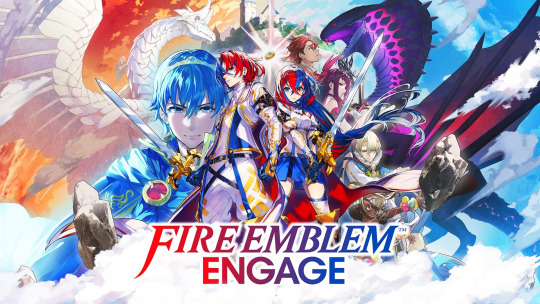
#4: FIRE EMBLEM: ENGAGE
Releasing right at the start of the year, I’m sure a lot of people forgot about Fire Emblem Engage, though really I think they’re missing out. I’ve been a fan of the series since Awakening, so the gaps in knowledge with the series is vast, but I could still recognize this as a love letter to the entire series. Clearly intended as a celebration of the franchise’s 30th anniversary before a certain pandemic got in the way, Engage is filled to the brim with fanservice…and not just the sexy kind! Truthfully I do feel aspects of this game are at odds with each other; while the overall presentation is great, being the most colorful and flashy game in the series yet, its story is…let’s say lacking. The characters are all fairly one-note and at times lean way more into stock anime archetypes than fully-fleshed out cast members, especially in comparison to the best parts of Three Houses, and there is the odd….otaku-bait stuff for lack of a better term, especially regarding the romance options, but the actual core gameplay is the best in the series.
Fights are fast, ferocious and give players a ton of great new mechanics to sink their teeth into. The star of the show is obviously the various rings characters can equip, which can summon a ghost of a past Fire Emblem hero to help out, giving you a neat little Stand of sorts to augment your abilities for a short time. Adding to that, players can push enemies away, or even break their guard, preventing them from attacking during your turn. I really enjoyed some of the changes to the core weapon triangles of the series, including a new one with archers, mages and bare-handed fighters. Being able to have my healers lay waste to those units with some fisticuffs never got old. Engage might not be the most ambitious game in the series, but at the same time it was a fantastic celebration of how far this series has come and how much more life it still has in it yet. Alear’s hair is still kinda dumb though…
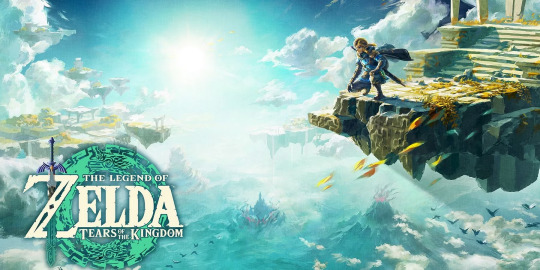
#3: THE LEGEND OF ZELDA: TEARS OF THE KINGDOM
Years ago Breath of the Wild not only launched the Switch into immediate sales success, but also started a conversation about how to craft an interesting open world game after years of the genre feeling overdone. And now in the twilight years of the Switch, Tears of the Kingdom returns to that same world with some new tricks. Link’s new abilities give players even more options for engaging in that world, and many of them are true technical marvels. I’ve gone over a lot of this game in a separate blog post, so I won’t try to reiterate what I said there too much, but ultimately I just enjoyed getting to bounce around a familiar world with even more freedom and opportunities to mess around and see how things worked.
I’d argue that TOTK has more in common with a big old box of random Lego pieces than a game at times. Half the fun is reaching inside and seeing what I can create when mixing and matching things together. Using Link’s Ultrahand and Fusion abilities I can craft vehicles and weapons that are often very goofy and don’t always work right…but when you land on something that’s just crazy enough to work it’s magical. In addition to the massive world from BOTW we also have islands in the sky to investigate, alongside the mysterious Depths, so there was always something to poke at and do. You get into a pretty solid gameplay loop of using the sky islands to look for areas of interest down below, then messing around on the ground during quests and visiting towns, before traveling into the Depths to harvest ore that goes towards making a variety of vehicles that can help me get around elsewhere, especially when it comes to getting back into the sky. Your options start out limited, but as you play you get more and more tools to work with and your various mechanisms become that much more complex. This even gets reflected in some of the dungeons you investigate, with one in the Depths in particular being such a programming flex, tons of game developers on Twitter were losing it, just wondering how Nintendo made it happen. For as much as we tout graphical upgrades as true progress in games, Nintendo is doing more interesting things with the very innards of a game using a console that was already out of date when it launched, and that needs to be championed.
For as much time as I poured into this game (probably somewhere close to 200 hours), I’d be lying if I said I enjoyed all of it. With that amount of playtime, you’re bound to notice some cracks. While this game definitely amplified everything I loved about BOTW, it also failed to really address many of the concerns people had with the previous game. Fusion as a mechanic makes ALL weapons feel usable to a degree, but the constant breaking is even MORE frequent. While there IS a way to stop slipping on wet surfaces, it requires a TON of time investment and the potions that give you slip resistance feel like a bandage over the whole annoyance. And then there’s the story being…very repetitive and a bit too much like the previous game in ways. I can see why talk of this game kind of dried up faster compared to BOTW; there was both a lot more competition this year, but also a lot of this game felt too derivative and lost that novelty of the original game. I wouldn’t have poured over 200 hours into the game if I didn’t love it, but there was definitely enough there to hold it back from being my favorite experience of the year.
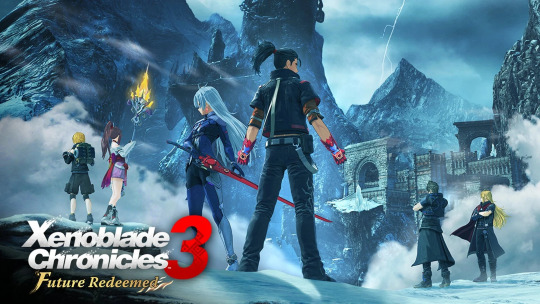
#2: XENOBLADE CHRONICLES 3: FUTURE REDEEMED
Xenoblade Chronicles 3 was my GOTY last year, and I knew that a beefy DLC campaign was still in the chamber. I was looking forward to Future Redeemed, but it exceeded about all of my expectations. While the core Xenoblade games have their connections, they’ve all been relatively standalone experiences on the whole until now. I had remembered going into Xenoblade 3, curious to see how all of these elements from the first two games would come together, but that game’s story leaned far more on the brand new cast rather than touching on the older characters in the series and I was left with a lack of closure. I should have had more faith in Monolith Soft, as Future Redeemed serves as not just a prequel to the story in Xenoblade 3, but as the glue that ties the entire Xenoblade series together.
Similar to Xenoblade 2’s Torna: The Golden Country DLC campaign, Future Redeemed is about the size of a medium-sized RPG in its own right, even if it never got a standalone release like Torna did. It keeps a lot of the same core systems of the base game here, but with some interesting twists. Whereas base game Xenoblade 3 made use of a class system and the ability for allies to fuse together, Future Redeemed emphasized pairing up different characters so they could cover for each other’s weaknesses or add to their strengths, on top of having some flashy combination attacks. There was a ton of things to do on the world map at any moment, with Monolith Soft making great use of a more limited map compared to the base game. Seriously, grind rails that can go up AND down were about the one thing Xenoblade 3 really needed! There was also just…so much fanservice and real love for this series found throughout. Seeing Shulk and Rex, the protagonists of the past entries, interacting with each other was fantastic, and newcomer Matthew was a great lead in his own right.
Longtime fans of Monolith Soft CEO and overall creator of the Xenoblade series, Tetsuya Takahashi, will know that his vision of a complete story has been a difficult one to see to completion. Starting back with Xenogears and later Xenosaga, it’s here that Xenoblade finally managed to have a satisfying multi-game arc and conclusion that finally answered some burning questions I had from the ending of 3. Somehow Future Redeemed managed to bring it all together in ways that longtime fans had always hoped for, and all in a neat 30-ish hour package. While I had greatly enjoyed Xenoblade 3, it was still missing something and Future Redeemed was that final piece, making me feel really valued as a longtime fan in the series, and also seems to have some nods to fans of the overarching “Xeno metaseries” that makes me extremely interested in seeing just where Takahashi’s Wild Ride takes us. If this DLC was an indication, the future is indeed bright.
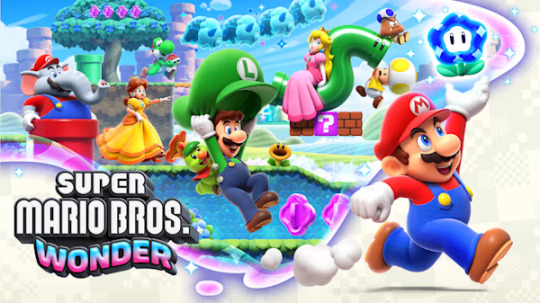
#1: SUPER MARIO BROS. WONDER
As long as we’re talking of bright futures…boy is it good to be a Mario fan right now. From a billion dollar box office hit, to remakes of two beloved RPG spinoffs, that alone would have satisfied fans of the plumber, but then we got hit with the first wholly original 2D Mario in almost two decades. While the New Super Mario Bros. games were all mostly well-regarded critically and commercially, they were just as often considered kind of stale. Inoffensive, but not very interesting, and with so many pumped out in such a short time, it was felt that Mario’s 2D outings had lost something. With the Super Mario Maker games, many had felt that Nintendo had done all that they could with the formula and left it in the hands of fans…but boy were we wrong.
Super Mario Bros. Wonder is oozing creativity out of every pore. From the stylish art direction that calls back to the older 2D art from the NES and SNES days, to the focus on music found throughout the game, it’s a rare game that made me smile about the whole way through. So much here feels fresh and different, from the litany of brand new enemies and power ups, to the various Wonder effects that often cap off levels and take them off the rails. I’ve gushed about this game enough in a separate blog post, which you can read here, but ultimately it has to be said that Wonder is a fantastic experience from moment to moment.
Not every game needs to be revolutionary or create a whole new industry standard to be recognized as great. Sometimes it just needs to be really fun. But even so, the amount of care that went into Wonder deserves praise. The developers weren’t given a deadline at first and got to really explore ideas before nailing things down. To see so much of the original Mario crew still involved on this project after so many years in the industry also showcases Nintendo’s iterative design that is continually polished to a fine sheen. The simple act of moving around is so smooth and responsive, the level design constantly plays with your expectations and makes hunting for secrets such a blast, and many of the new mechanics are slotted in seamlessly, like they were always there. Why yes, giving Mario a grappling hook makes perfect sense! Of COURSE he can turn into an elephant and put out fires with water shot out of the trunk! Some dislike the changes to multiplayer, no longer having any collision or ways to really screw with other players, but that results in seamless online play that lets players experience the levels together, yet apart, in a way I haven’t seen many other games implement. Being able to guide newer players through levels by giving them hints, or even a power up if they need it, and throwing down a standee sign that can revive them even if I’m not there…it’s really something special, akin to how players of Journey felt back in the day. The one blemish on what is otherwise a perfect experience are the boss fights that are both too few and too same-y, but honestly that’s a nitpick in the grand scheme of things. So yeah, Super Mario Bros. Wonder is the game that probably gave me the most joy this year. Not the longest game or the most technically impressive, but a masterclass in design that deserves every bit of praise.
CONCLUSION
There are tons of games I wish I got to this year. I’m sure this list would look a LOT different if I had a beefier PC to check out certain games with, or a fancy new PS5, but that wasn’t in the cards this year. If anything though that just goes to show how many talented people are in this industry that there are so many finely-crafted experiences, so many ambitious titles that keep pushing the medium forward. It was admittedly a lighter year for Nintendo, which has always been my bias, but I’m glad to see the folks over at Remedy and Larian and so many others pushing the boundaries of what we can expect to see in games. Having a virtual D&D campaign filled with moments where you have to adapt to things on the fly is nothing short of a magical experience, and seeing how Alan Wake 2 fuses together film and video game to create something so unique deserves its roses as well. Ultimately though, this was a year filled with some developers running on all cylinders, truly excelling at their craft. We’re getting fighting games with honest-to-God single player content! Strategy games are alive and well and continue to tease and torment players with tough decisions. All the while smaller developers pump passion into their projects, resulting in some fantastic experiences all their own. It was a good year for games and I look forward to seeing what will make my list next year. Until next time.
-B
#blog#xb-squaredx#nintendo switch#capcom#legend of zelda#TOTK#BOTW#advance wars#wayfoward#Pokemon#hololive#vtuber#f-zero#street fighter#xenoblade 3#bayonetta#NASB 2#final fantasy#baldur's gate 3#alan wake 2#super mario#fire emblem#GOTY
1 note
·
View note
Text
A Tribute to Akira Toriyama
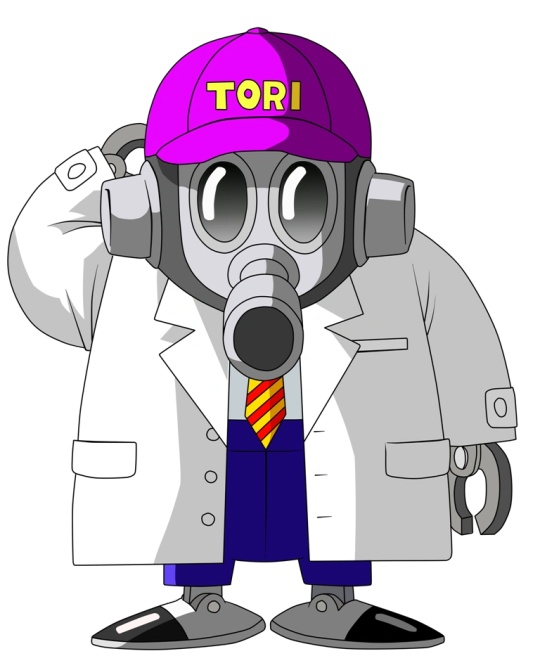
It’s been a bit over 24 hours since I’ve heard the news that acclaimed manga author, Akira Toriyama, has passed away, and frankly it’s still hard to process. I’d like to just say a few things to honor and mourn a man that I have never met, but whose work touched me and millions of others all over the world in ways I am only now really beginning to see.
Like a lot of 90s kids in the United States, my first exposure with Toriyama’s work was through the Dragon Ball Z anime. Despite the fact that I didn’t even know this was a sequel to a completely different series, and I had no real clue what anime even was at the time, I was captivated. For years I would race home from school and sit glued in front of the TV as Toonami would air the latest episodes. A phenomenon that rippled out across the world for several years in waves, from the original airing of DBZ, to some snippets of the original Dragon Ball and even later on with the anime-only continuation that was Dragon Ball GT, this series had such a hold on me. Friends and I would spend recess trying to recreate the iconic Kamehameha Wave, we’d scream trying to become a Super Saiyan, or take turns fighting each other in one of the MANY different video games based on the series over time. I’ve made friends through my love of Dragon Ball and it would go on to foster a love of anime and later manga. But little did I know just how far Toriyama’s influence would reach.
While I was never all that knowledgeable of his past work, particularly Dr. Slump, so many other series would be inspired by him or have his involvement in some way. Sonic the Hedgehog’s Super Sonic is an easy reference to spot, but less so was Cloud Strife’s garb in Final Fantasy VII being a dead ringer for Gohan’s outfit in the Cell Saga. As long as we’re talking about RPGs, Toriyama’s long history with various properties, from Chrono Trigger to Blue Dragon, and going back to the grandfather of all RPGS in Dragon Quest, it’s safe to say his legacy is felt in multiple mediums rather than just one. This wasn’t even limited to Japanese media either. I would see references to Dragon Ball in things like The Powerpuff Girls or Codename: Kids Next Door. Even well into my 20s, I was still seeing series inspired by him, like the whole fusion concept that made up Steven Universe. His reach was vast and multigenerational.
As I would get older, I would listen to Linkin Park AMVs on YouTube, with songs like Numb or In the End overlaid over the various hypest moments from the Dragon Ball series and its later movies. Even long after the series had finished airing, you’d still see the rare movie or special crop up, alongside an endless series of games trying to capitalize on the success of the Budokai Tenkaichi games. Toriyama was inescapable, and in a way it was comforting. You start to get used to his work being there, whether subtly or overtly. You never think about the day when he’ll be gone.
When first reading the article stating his death, it took a moment to really let it sink in. This man who had been with me, inspiring me throughout my childhood, was gone just like that. Over the past day I’ve seen the greater Internet in mourning, as people share their favorite manga panels, or iconic moments from the various anime interpretations of his work. Outpourings of fanart and inspirational stories from people who grew up with his work just like I did. There are people that got into bodybuilding to be just like Goku, for one. For another, during the finale of Dragon Ball Super there were massive watch parties set up in Mexico and even when authorities tried to stop the events they went forward anyway because they just had to see how Goku could finally defeat Jiren. I remember when Trunks first appeared in the anime, and I thought he was the coolest. I had to try to draw and replicate his first appearance, how he defeated Frieza, the person that took Goku so long to defeat, in a mere instant; I’m realizing now Toriyama might have been my real inspiration to start drawing, alongside who knows how many thousands if not millions of people. As sad as it is to see him go, to see so many people pay tribute and remember him, it really does lay bare just how influential he was, just how powerful art can really be.
It was only in more recent years that I’ve come to really respect Toriyama’s craft. Far beyond the screaming and power ups that many associate with him from Dragon Ball Z this was also a man who valued whimsy. He got his start as a comedy author, and for the longest time the Dragon Ball manga was just a humorous retelling of Journey to the West. The man loved a good bit of toilet humor and the occasional fourth wall break. Looking back at his manga, you can see just how amazing his panel work was, and how it still holds up. The ease at which he guides your eye from panel to panel, the expressiveness of his characters conveyed at all times. Many of his peers have called him a God of Manga, and I think they’re right to do so. The likes of Osamu Tezuka, the creator of manga, had called Toriyama his heir apparent, and stated he was “almost too good.” You can’t get higher praise than that.
Outside of his manga work, just his raw talent at creating iconic character designs needs to be praised. Taking a rather uninteresting mockup of the slime enemy in Dragon Quest, Toriyama would create perhaps the most iconic enemy in all of video games. His enemy designs are often cute and goofy, but occasionally can be quite ferocious. If nothing else, they are eye-catching and never boring. He was also a fan of vehicles and machines, with some really interesting modes of transportation shown off in a lot of his work. And then there’s the fact that so many of his characters have the trademark spikey haircut that has become shorthand for “anime hair,” that is understood to this day. To see him effectively retire after finishing with Dragon Ball back in the 90s, with the occasional contribution here or there, only to get right back to business as usual in the 2010s with amazing designs like Beerus or Android 21, not to mention his continual work on the Dragon Quest series all throughout that time…the man never lost his edge even once.
A sentiment I’ve seen over the last day or so is that Toriyama might, with no exaggeration, have inspired more artists than anyone else in modern history. So many people making their own “Saiyan-sonas” or being inspired to make manga of their own…we may truly never know how far his reach really was at the end of the day. But we do know that the “Big Three” of Shonen Jump throughout the 2000s can be attributed to Toriyama, as the likes of Eiichiro Oda, Masashi Kishimoto and Tite Kubo are all big fans of Toriyama, with Oda in particular worshiping the ground he walks on. Kubo is also on the record for stating that a letter from Toriyama, when his first draft of what would later become BLEACH was rejected, gave him the encouragement to try again and later be accepted into the magazine. And now these authors have gone on to inspire the next generation and so on and so on.
Over the last few years, we’ve lost a lot of creative figures in the manga industry. Toriyama now joins other similar legends, such as Yu-Gi-Oh creator Kazuki Takahashi as well as Berserk author Kentaro Miura. It is the end of an era, arguably of many eras, and it can be hard to imagine the future, but the Earth continues to spin and as Toriyama has inspired and influenced others, we too will inspire future generations with our work. It isn’t enough to call him a legend; he truly was in a league of his own, a legend among legends, and the outpouring of love for him across all manner of social media posts in just a little over a day alone is a testament to his immense talent and reach. I can think of no greater sendoff than the one that Eiichiro Oda gave him: “I pray for his soulful rest in peace. May heaven be the joyous world he envisioned.”
Rest in peace, and thanks for everything, Mr. Toriyama.
-B
18 notes
·
View notes
Text
2023 In Gaming: Great For Games, Terrible for Workers

It’s that time of year again (or perhaps a bit later than usual), and while we await the juicy gaming news and big reveals of 2024, we should really take 2023 to task. Every year in gaming is going to have its highs and lows, and especially since the start of this decade it’s been…a fairly tumultuous time. 2023 still manages to stand out from what’s come before. A huge refrain you might have heard throughout the year was that “2023 is great for games!” So many highly regarded games and some really big success stories…but that isn’t the whole story. So yes, 2023 was a great year for games, but a terrible year for anyone working in the industry itself.
THE BIG THREE’S BIG YEAR
We can start by examining the Big Three of the gaming sphere: Sony, Microsoft and Nintendo. Sony themselves had a somewhat mixed year overall. Certain timed or console exclusives like Forspoken or Final Fantasy XVI had somewhat mixed reception, though the latter at least seemed to sell alright. In the realm of adaptations to their video games, things were somewhat better. While the Gran Turismo movie…exists, and many enjoyed the Twisted Metal series, the real winner here was HBO’s live-action Last of Us series. It won critical acclaim for it’s writing and acting, regarded by many as one of the better game adaptations out there. The biggest first-party release was obviously Insomniac’s Spider-Man 2 and while that game did get a fair bit of acclaim and is the fastest selling PS5 exclusive so far…not long afterward Insomniac was hit with a major hack that put a real damper on things. From personal employee information being stolen in this hack, as well as the plans for Insomniac’s next few projects (such as the already-confirmed Wolverine game), there was also a lot of information shared about Insomniac’s difficulties with selling games to appease Sony higher-ups. At one point, one presentation questioned the much larger budget for Spider-Man 2 and how that didn’t seem to translate to higher sales, or even significant recognition for that extra bit of cash injected into things. While Sony seems to be doing fine in some regards, the PS5 having sold over 50 million units, keeping pace with the PS4’s sales along the same time frame, there are signs that the company is having major issues behind the scenes. After the acquisition of Bungie last year, (alongside the Firewalk Studios acquisition this year), Sony has changed course on a number of in-development live-service titles, shelving over half of them. Adding to this, there was the rather strange announcement of the Playstation Portal, a device that lets you stream games to a small screen imbedded in a PS5 Duelsense controller. Many have likened that to the ill-fated Wii U system, and as it stands it feels like a strange project to put money into with an uncertain audience to adopt it. Alongside their continued VR efforts, Sony trudges on, but the cost of these endeavors might be starting to take a toll.
For Microsoft undoubtedly the biggest story this year from them was the acquisition of Activision Blizzard. Despite resistance from various government officials, the business deal eventually went through. Along the way some absolutely WILD statements were thrown around by the likes of both Microsoft AND Sony, from downplaying Nintendo’s success in the industry, to Microsoft basically admitting to having failed the entirety of the Xbox One generation and losing customers, feeling that they NEEDED to take steps to become a monopoly to even compete. As talks closed down, Microsoft would promise to keep Call of Duty on Playstation consoles for the immediate future, though other titles are up in the air. Regarding their games this year, I’d say it was also a bit of a mixed bag. Starting the year off strong with the shadow drop of Hi-Fi Rush, a colorful, inventive rhythm action game by Tango Gameworks under Bethesda, we would later see the atrocious reception to Arkane’s Redfall not long afterward. Along with this, we ended the year with Starfield, a supposed “game of the generation” that many hyped up as being the ace in the hole Microsoft needed. That said…the game didn’t quite make the impact many might have wanted. While selling around 12 million copies by the end of the year, the game seemed to vanish from public opinion entirely. No nominations at The Game Awards, and no major impact on the gaming industry compared to the Elder Scrolls entries that came before it. Gamepass still goes on as a subscription service that attempts to bring in more players, but even Phil Spencer knows a lot of work must be done to win over fans again. During an appearance on the Kinda Funny podcast, Spencer was asked some hard questions on Xbox’s fumbles and he was honestly pretty frank, especially an admittance that losing the Xbox One generation was a major mistake that they’re still paying for. Regardless of the money they throw around, it’s clear Xbox is still on the defensive.
youtube
Now, I’ll admit I’m probably a bit biased here, but Nintendo had a hell of a year and is the clear “winner” for the Big Three. The launch of Super Nintendo World across various Universal theme parks was mostly well received and I’m sure that will continue to expand as the years go by. Getting in on the trend to have a shadow dropped hit, Metroid Prime Remastered came mostly out of nowhere to tantalize us and whet our appetite for the long-awaited Metroid Prime 4. Pikmin fans were thrown a real bone this year; from the first two games being ported to Switch to the release of the equally long-awaited Pikmin 4, the series feels like it’s experiencing a boom of newer players that could take the series to new highs. Strategy fans saw the release of Fire Emblem Engage, a title celebrating the history of the franchise, alongside the revised released date for the Advance Wars 1+2 Reboot Camp remakes. For the Xenoblade fans this year, the final bit of DLC for Xenoblade Chronicles 3, Future Redeemed served as an amazing sendoff to the trilogy and a way to tie things together in a way many fans had hoped for but figured would never come. One of the absolute biggest games this year was the latest Legend of Zelda game, Tears of the Kingdom. Building on what the previous entry, Breath of the Wild started, this was seen by many as a technical marvel. Getting such a massive world to run seamlessly on the Switch’s tech is witchcraft, as is the game’s advanced physics and building mechanics. Engineers were blown away by what this game accomplished, no doubt helped by the game having essentially an entire year of polish. That said, the game didn’t seem to quite hit the mark for some fans and ended up repeating some of the criticisms of Breath of the Wild, somewhat reducing its overall impact. Mario fans had a TON to chew on this year. For starters, there was the smashing success of the Super Mario Bros. Movie, with it becoming a billion-dollar earner for Nintendo and Illumination. While critically it didn’t fare well, it fared well with audiences and was clearly part of a plan to push the plumber this holiday season. The first wholly original 2D platfomer in a long time, Super Mario Bros. Wonder released to critical acclaim at the end of the year, alongside the reveals of remakes for Super Mario RPG and Paper Mario: The Thousand Year Door, thrilling longtime Mario RPG fans. With a Princess Peach game on the way in early 2024, alongside a remake of the original Mario vs. Donkey Kong game and a Luigi’s Mansion 2 port, Mario fans are eating well. This year also saw us saying goodbye to Charles Martinet as Mario’s voice, taking on the task of being a “Mario ambassador” (whatever that means) as we welcome newcomer Kevin Afghani to this role. With rumors of a new Nintendo console being revealed (and maybe even released) in 2024, Nintendo’s future is looking quite bright as the Switch enters its twilight years with some amazing games. But that’s just the Big Three so…what about everyone else?
OTHER INDUSTRY ILK
One major thing that really stood out this year was the final nail hammered into the coffin that is E3. The Electronic Entertainment Expo seems to be dead and buried, cancelling not just the 2023 venue but the next two years as well. After years of being THE place to get gaming news and reveals, it really is the end of an era. We’re at a point where other developers are using their own digital presentations on their own timetables to great effect, following Nintendo’s lead with their successful “Nintendo Direct” format. While E3 was a great way for fans to play games before anyone else and for some truly legendary on-stage moments to occur, the pandemic clearly sped up the venue’s demise, not helped by longstanding controversy with leaking attendee information and the costs of running these large presentations.
Sega had a particularly interesting year, starting with their acquisition of Angry Birds studio, Rovio which is sure to bring in some money. Following the success that the Sonic the Hedgehog brand has seen this year, Sega also seems poised to carry that momentum into new titles. They revealed several new entries in long-dormant series such as Golden Axe, Jet Set Radio and Crazy Taxi among others right at the end of the year, and are also apparently hard at work at some extremely expensive “super game,” though seeing as they also cancelled an expensive new IP in Hyenas I’m a little skeptical of how this project will turn out. Sega of America also voted to unionize, which seems like good news, but there have also been apparent threats of layoffs if a union comes to pass which puts a real damper on things.
Square Enix had a somewhat rocky year. Forspoken was one of the more ridiculed games online this year, particularly due to its dialogue, and it failed to earn high sales. The primary team behind this title, Luminous, has since folded back into Square Enix proper and the engine they used for this title (as well as Final Fantasy XV) seems like it might be shelved despite a lot of time and money pumped into it. Square Enix themselves has also stated that they are going to start focusing almost entirely on larger-scale projects and scaling back on smaller games in the near future, likely as a result of several smaller projects released over the last few years not doing very well.

When it comes to larger figures in the industry itself, it’s also been a bit of an off-year. Following the disastrous launch of Babylon’s Fall and the shaky reception of Bayonetta 3, one of the founding members of Platinumgames, Hideki Kamiya, left the company in late 2023. Starting a YouTube channel in his spare time, it’s currently unclear why Kamiya left the company, though leadership apparently going full-steam ahead on live-service titles despite signs of the bubble bursting in the industry is a pretty good guess as to why. Someone of Kamiya’s pedigree would likely be a great asset to any developer…just as soon as his non-compete clause ends. Elsewhere, Yuji Naka, largely viewed as the “creator” of Sonic the Hedgehog, was also sentenced to prison for insider trading during his time at Square Enix. It’s safe to say that Naka’s reputation in the industry is about shot, though it’s sad to see the fall from grace all the same.
Speaking of falls from grace, Unity as a developer tool and engine is likely going to be a thing of the past soon. Following news that Unity would begin charging developers after they’ve past enough sales of titles that use Unity, many have sworn off the engine entirely, or are at least heavily considering it. Konami also continues to lose a lot of goodwill from fans as many Silent Hill fans are forced to watch the quality of the franchise fumble. Silent Hill Ascension is being regarded as one of the most hated games of last year, with some accusations that the game’s writing might be using AI generated scripts, if not voice work. AI has itself become a hot button issue for most of 2023, and the gaming industry isn’t immune to that. Alongside Ascension, Embark Studios’ The Finals was under fire for using AI voices for the game in lieu of paying professional actors, and the most recent entry in the Naruto Ultimate Ninja Storm series has been accused of using AI voices for at least the English dub of some lines, though nothing has been officially proven. Of course we also have more old-fashioned scams alive and well with The Day Before, an online shooter accused of asset flipping and misleading marketing that ended up killing its developer, Fntastic, after only being available for purchase for about four days. Scams are eternal.
Leaks are ALSO eternal. Outside of the massive hack and leak of information from Insomniac, Rockstar also suffered various hacks, with the Grand Theft Auto V source code potentially stolen. This comes alongside the source code for League of Legends also being stolen from Riot. A bit of a recurring story throughout 2023 was repeated leaks of military information from forums for the game War Thunder as well; it seems people would risk the wrath of the US Military just to win some online arguments.
To end this segment on some GOOD news in the industry, several sexual assault cases from Riot, Activision and Ubisoft resulted in several victims receiving settlements. Several former members of Ubisoft were even jailed following sexual assault allegations, so there’s at least SOME justice in the world. And for some interesting surprise hits of the year, there were quite a few!
Larian ended up stealing the hearts and minds of gamers in 2023 with the long-awaited release of Baldur’s Gate 3. They would go on to sweep many award shows at the year’s end, enjoying tons of sales success for the title. Effectively letting players enter into the world of Dungeons and Dragons with a moving story filled to the brim with charming characters, it was also considered a marvel at giving players TONS of freedom to explore, fight and progress through the game. In some respects, it’s the next best thing to a real tabletop experience with lot of room for improvisation and countless variables resulting in unique playthroughs for everyone. Remedy also gained a lot of attention for the release of the similarly-long-awaited Alan Wake 2. A survival horror game with an arthouse approach, many praised the game’s presentation and foreboding atmosphere…alongside some dazzling musical numbers thrown in for good measure. After years of hit or miss titles, Remedy seems to have really hit their grove and fans have been enjoying the “Remedyverse” that has been connecting so many of these projects together. From the likes of the Max Payne games to Quantum Break, Control and now Alan Wake, the story goes ever deeper, and many a fan can’t wait to see where it goes next.
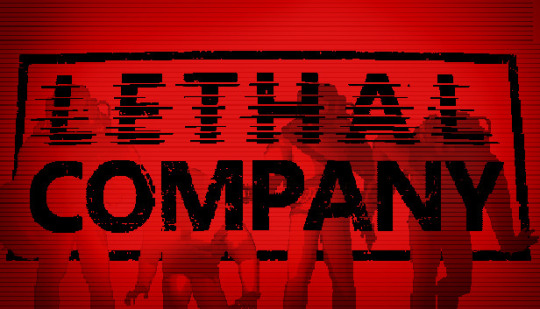
On top of the big AAA hits, it’s important to not forget some of the most notable indie hits this year. From RPG throwbacks like Sea of Stars to the colorful, distinctly-animated platformer that is Pizza Tower, there’s too many to list. Bomb Rush Cyberfunk is a loving spiritual successor to the likes of Jet Set Radio that has been in the works for quite a bit, and for fans of fishing, the horrors of Dredge were sure to delight. While not a 2023 game, this was the year that saw Suika Game gain a huge amount of fans due to various streamers (and Vtubers) playing it, resulting in a worldwide release after previously being only available in Japan. A fruit-based puzzle game, where players try to merge the same types of fruits to make progressively bigger fruits, the simple charm of the game won over millions of new players, having sold over 5 million copies by the end of the year. But if we’re talking big sales success with indies, we have to bring up the sleeper hit that is Lethal Company. Developed by Zeekers, previously an amateur developer using Roblox, Lethal Company came out of nowhere to become one of the biggest hits of the year at over 10 million sales since October of 2023, and this is still as an early access title. A co-op horror experience, players enter into creepy facilities in hopes of finding scrap and spare parts to sell in order to make a profit…but many things lurk in the shadows and players will have to keep their wits about them to survive and meet their quotas. A simple game and certainly a bit crude at points, the game’s success speaks for itself, becoming a gigantic hit especially with streamers. Just goes to show that success can come from anywhere.
While that covers the industry in broad strokes, I’d like to now spend some time investigating some more specific trends that slowly emerged throughout the year. Strap in, because with few exceptions, things start to get a bit bleak.
TO BE OR NOT TO BE A JRPG
With Final Fantasy XVI as one of the most talked about games of 2023, not all of that talk was positive. Playing like a traditional action game was controversial for longtime fans that associate the series more with turn-based affairs, or at least “RPG staples” like multiple party members and gear to collect and swap around to make builds. Many argued it was wrong to call the game an RPG at all. During the various bits of press for this game, as well as the upcoming Final Fantasy VII Rebirth game, Tetsuya Nomura mentioned his own dislike of the term “JRPG,” feeling it was trying to “other” games out of Japan. This kicked off a whole slew of discourse over whether he had a point or not. Some argued it was always said endearingly, or pointing out that design differences between a game like, say, Final Fantasy VII was markedly different from, say, a Fallout or Witcher game. While they are all considered RPGs, the way they are designed and play are so different that the umbrella term ceases to be useful. It did lead to some interesting discussions of game genres and how they’ve evolved over the years, but also a lot of disparaging remarks that seemed to brush off Nomura’s dislike of the term, among other things.
Nomura’s offhand comment on JRPGs would be the catalyst for a greater discussion of how western journalists and gaming pundits would often disparage anything out of Japan in the past decade or so. In some cases these seemed to be tongue-in-cheek digs, but some could be far more unpleasant and looking at them from today’s standards, it led to many a jaw drop. Among all this talk, the game review show, X-Play, was often brought up. So many “jokes” and comments directed at anything outside of Japan were seen as being incredibly racist at worst and just in poor taste and crass at best. From the constant mocking of anime or manga fans, not to mention RPG fans during this era, there was this common belief around the seventh console generation or so that the West was on top and Japan had fallen behind. Certainly Japan did struggle with the switch to HD consoles and certain Western franchises like Call of Duty or Halo found great success around this time, but none of that really excused the venom that was directed at Japan at the time.
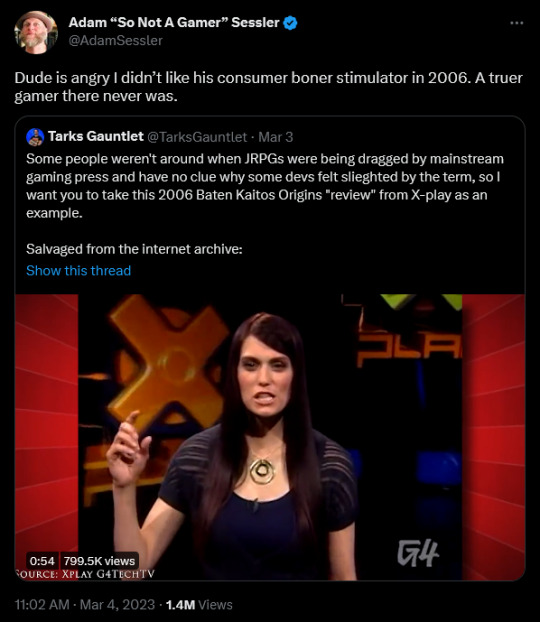
While I think you can argue that things have largely improved over the years, that one random comment from Nomura opened up some old wounds and a lot of that xenophobia that had started to fade away during the 2010s came RUSHING back as various game pundits denied any such sentiments had existed. Adam Sessler, one of the former hosts of X-Play, didn’t exactly have the best response to criticisms though. There have also still been some statements made from Western devs in recent years that show these sentiments are still around, such as firing back against Elden Ring’s UI and general UX design among other things. If anything, I think it shows that the gaming industry still has a lot of growing up to do and some skeletons in the closet they keep trying to hide.
CAPCOM RECLAIMS THEIR CROWN
Of my many biases, fighting games are a big one, and this year had a lot to talk about regarding the genre. Let’s start with the bad before we get to the good though. For starters, the winner of “Best Fighting Game” for 2022, Multiversus, ended up being taken offline partway through the year. Having started its second season of content around the holiday season of 2022, updates began slowing down to a crawl with only one new character added during that season amidst some seasonal costumes and events. The developers, Player First Games, would announce that the game’s beta period was ending and we would see the game return…sometime in 2024. This was confusing for many as it felt like the game’s full release had already happened alongside the first season pass. Considering the game’s hefty monetization, it certainly SEEMED like a full release, but as of now it’s as if the game never happened and considering the tumultuous nature of Warner Bros. after the Discovery merger, there is a real fear the game might not actually be brought back. Alongside this, the fighting game battle royale, Rumbleverse also shut down in 2023. Despite its interesting twist on the genre, many fans just didn’t click with it and it was lost in the sea of other live-service titles. Nintendo also ended up turning heads when they revised their tournament guidelines for games like the Super Smash Bros. series. Many are left confused and frustrated with the constant attempts to throttle the competitive scene, though at this point what else is new with Nintendo?

That said, there was a lot of hype this year with a variety of reveals and launches of some greater fighters out there. With more news on SNK’s new fighter in the Garou series, City of the Wolves, fans are looking forward to seeing them continue onwards, on top of them finally adding rollback netcode into the latest Samurai Shodown game. Arc System Works continued to pump out content for Guilty Gear Strive, and despite security issues with hackers affecting some players and lukewarm receptions to much of the season 2 DLC characters, season 3 has been more highly regarded with new mechanics, special moves, characters and modes being added. ArcSys would also throw fans of Granblue Fantasy a bone with an updated pseudo-sequel to the licensed fighting game with Granblue Fantasy Versus Rising, finally giving that series rollback netcode for fans to enjoy. Speaking of rollback, Dragon Ball FighterZ also finally received updates on the rollback to be integrated into the game, making just about every modern ArcSys game in line with online quality. French Bread fully unveiled Under Night In-Birth II Sys:Celes, a sequel to their original IP, launching right at the start of 2024. Namco’s Tekken 8 is also hotly anticipated, with many fans welcoming the new installment after years of waiting.
When it came to the biggest releases for fighting fans though, Street Fighter 6 and Mortal Kombat 1 were the stars of the show. The former was Capcom’s apology for the previous game’s sorry launch, on top of creating a deeply satisfying set of mechanics and new characters to play with, on top of a significant single player campaign with World Tour Mode, with perhaps the best online experience in a modern fighting game. Capcom also drew attention to their Capcom Cup tournament taking place in 2024, with the winner receiving one million dollars, which certainly helped propel interest in Street Fighter 6. Meanwhile, the latter was the first game set in a brand new universe following the events of the previous Mortal Kombat, and while the assist-based gameplay with the new “Kameo” system was praised, fans had some qualms with the story in this “new” world alongside the game’s DLC characters feeling a tad redundant (both Omni-Man from Invincible and Homelander from The Boys make the cut, both being “evil Superman” archetypes). The game also launched with a number of bugs and many criticized the lack of single player content compared to other entries, but it was still a major sales success.
Seeing new entries in the biggest fighting game series launching within a year of each other, Street Fighter, Tekken, and Mortal Kombat fans are eating well as we enter into a new era of fighting games. With some exceptions and issues here or there, most fighting games have finally embraced rollback netcode, and we’re starting to see more emphasis placed on single player content, resulting in games that feel like full packages. Indie fighters also pop up every so often, pushing boundaries in ways the bigger budget games might not, so no matter where you look there’s something to look forward to. I hope you all enjoyed this brief indulging of my biases and some rare good news in the industry, because our final segment here is going to cover what is easily the most distressing trend about this year in video games.
AN ENDLESS SEA OF LAYOFFS AND CLOSURES
There is no sugarcoating it; 2023 was absolutely awful for many in the industry, as month after month news of layoffs and closures would ripple throughout the industry. Studios big and small have seen massive issues, and as a bit of a spoiler for 2024, that trend isn’t showing any signs of slowing down. Where to even begin here? We have the absolute industry giant Epic Games cutting over 16% of its workforce, as reported in September. That’s over 870 jobs gone in the blink of an eye. Despite Fortnite being the biggest thing ever, apparently for years Epic hasn’t been really making much money and these layoffs are an attempt to cushion that blow. It’s hard to really picture the BILLIONS of dollars they rake in between Fortnite, licensing out the Unreal Engine and various other revenue streams still not cutting it, but regardless workers are paying the price.
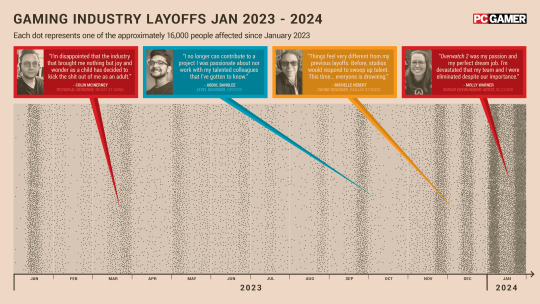
(from PC Gamer)
Really, September and October were where the floodgates really started to open with closing after closing, layoff after layoff. The QA staff for the upcoming Dragon Age: Dreadwolf game were laid off after being brought on to help out Bioware in late September. Team 17, known for the Worms series of games has laid off much of its QA staff, around 50 jobs on top of the CEO leaving. Following over three different rounds of layoffs, the devs over at CD Projekt Red have started unionizing to protect themselves. That’s over another 100 jobs lost. Things aren’t safe at Bungie either, also reporting layoffs, on top of a “soul-crushing” atmosphere at the studio. That’s about another 100 gone, same with Pokémon GO developer Niantic. These layoffs come at the price of cancelling games and delaying expansions, with employee morale at an all-time low. Even studios that died once and were resurrected, like Telltale Games, have seen layoffs.
Layoffs are already bad enough, but longtime developer Volition shut down in 2023 following several rough years. Once well-known for the Saint’s Row series, things were rocky after the fourth game’s somewhat mixed reception. Following the absolute dud that was Agents of Mayhem, the Saint’s Row reboot failed to perform well. That said, much of the blame for Volition’s demise must be laid at the feet of Embracer Group, their parent company that swiped them up a few years prior. Embracer was on a spending spree for quite some time, snatching up various other studios such as Eidos and Crystal Dynamics from Square Enix, which have also seen better days more recently, but the biggest blow came from a 2 BILLION dollar deal falling through, and as such they have had to do some serious “restructuring.” Considering they’ve snatched up somewhere around 138 different game studios alongside all of the other non-gaming ventures they’ve gone to (such as buying the IP rights to Lord of the Rings), this could wind up being absolutely catastrophic. One really has to question just where this ends, and if we might be brushing up against another gaming crash.
For my own two cents here, this is partially the results of unchecked corporate greed, mixed in with the short-sighted belief that the boom the tech and entertainment sector enjoyed with COVID would go on forever. As much as the pandemic lingers and the world state has changed, things are not like they were for the bulk of 2020 when most people were stuck inside with nothing to do. As the “streaming wars” have raged on with movies and what was once television, games continued to do well and brought in tons of money that is now drying up, at least in comparison to the days of lockdowns. We’re at a point in capitalism where the negative effects are harder and harder to ignore. Studios are bought up and then multiple “redundant” jobs are removed. All in the pursuit of capital. The line must ALWAYS go up, and it doesn’t matter how many people must suffer for that to happen. This year was good for business but don’t ever forget that it came at a very human cost.
CONCLUSION
Alright, let’s take a breath and try to take this all in. It’s kind of crazy what can happen in a year, just looking at one industry. As many were so quick to say throughout the year, it was a GREAT time for video games. Some amazing sequels, sleeper hits and breakthroughs in the industry I hold so dear. I’ve made it no secret that gaming is one of my biggest interests and over the last few years especially, it’s served as an escape from…well, the awfulness that seems to have enveloped the entire world. It’s certainly important to highlight the good in this industry. I’m glad to see a game like Baldur’s Gate 3 resonate with so many people, showing that games like this can find mass appeal and success. It was great to see the Xenoblade series get some closure with the trilogy’s final bit of DLC, which also feels like closure for all of the various projects Monolift Soft have been involved with dating back to the days of Xenogears. Seeing Sega bringing back classic IPs is always good to see, and Remedy finally hitting the big time with Alan Wake 2’s success is heartwarming. There was a time when Sam Lake felt a sequel would never happen, and then this year ended with him performing a song and dance number from the game at The Game Awards. A lot of fantastic games and great memories this year, but we can’t lose sight of the worst aspects of the industry that produces these experiences.
People make games, not corporations. People that work hard for years and often never get even a shred of recognition. And then, when we’re seeing record levels of profits, they can be cut loose. All to please the almighty shareholders. I don’t know how we get better from here; again, going into 2024 we’re still seeing TONS of layoffs that rival 2023 already. This isn’t going to get better anytime soon. It’s worth pointing out that this has been predominantly a Western gaming issue, and Japan has seen little if any layoffs overall. There definitely seems to be much stricter labor lays in Japan comparatively. The legacy of Satoru Iwata during his time at Nintendo is greatly impacted by his repeated reduction of his own salary to prevent layoffs during the tepid Wii U years, and while that is a very noble thing…that also just kind of seems like a cultural norm over there. I’m not saying the answers to our troubles lie solely in the Japanese gaming industry, as they have their own problems, but it’d be great if CEOs worldwide would realize that constant downsizing and expensive acquisitions don’t exactly keep the industry healthy. Because honestly if this continues there won’t really be much of a gaming industry anymore.
So far, roughly a month in, 2024 is already giving us a ton of things to talk about, but I’ll hold out hope that at least some of it will be some positive news for the industry going forward. Rumors have been swelling for a while that Nintendo’s next major console will release in 2024, and with the PS5 and Xbox Series consoles entering into their fourth years on the market, people are looking forward to seeing this new generation really take off. At any rate, I’m sure it will take a great while for things to stabilize. I suppose in the meantime, we still have indies! So that’s something, right? It’s hard to really end things on a positive note when you really look back at all the garbage at the end of the year. But it’s important to not give into despair and just let things go by without comment. As bad as things have been this year, it’s always possible to turn things around. While 2024 still isn’t looking great for employment in the industry, we still have 11 months to go, and I will hold out hope we can see some momentum swing into the other direction. That said, I think that’s about enough for now. Let’s keep our fingers crossed that the next time I do one of these, I’ll have some better things to talk about.
Take care out there!
-B
#blog#xb-squaredx#video game#nintendo switch#ps5#xbox#layoffs#volition#embracer group#square enix#capcom#lethal company#baldur's gate 3#astarion#pizza tower#totk#legend of zelda#street fighter 6#year in review#Youtube
1 note
·
View note
Text
Super Mario Bros. Wonder: How Mario Got His Groove Back
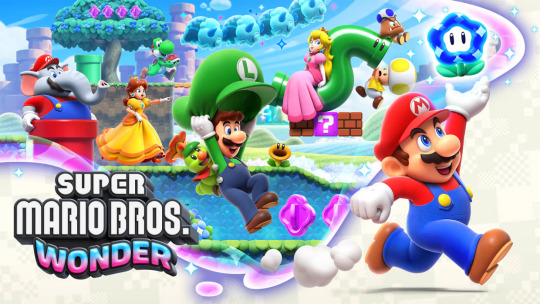
Mario has had a rough regression into 2D. Once the top dog in platformers, Mario has been in a bit of a lurch regarding a number of his titles for the last several years. While once seen as a breath of fresh air, as the New Super Mario Bros. series went on many regarded them as too same-y and stagnant. The same could be said for the 3D titles, as every title from Super Mario Galaxy 2 onward sanded off a lot of the wackier, more experimental aspects of the earlier 3D titles. The less said about the state of the Mario sports and RPG spinoffs the better. However, in recent years there have been glimmers of hope that everyone’s favorite plumber might be getting back to his roots. Super Mario Odyssey was a well-received return to form for the 3D sandbox titles, and the resounding success of the Super Mario Bros. Movie speaks for itself. But the real test was releasing a 2D Mario game that manages to actually FEEL new and exciting. Is Wonder that game, or will be left wondering when this supposed renaissance will truly begin? Let’s find out!
A NEW COAT OF PAINT, AND A FRESH NEW SOUND
The first thing that stuck out to me when first booting up Wonder was just how alive everything felt. The New series after a time felt anything but new, filled with lifeless animations and a bland visual style that was…fine but not exactly exciting. Wonder by contrast is vivid and adorns everything with either a painterly or even clay-like texture. It might not be the most visually striking game ever made, but as far as Mario’s 2D outings go this one really pushed past some boundaries. While in 3D, everything looks a lot more akin to the older 2D art for the Mario cast. Faces are rendered with this 3/4s style, always facing the camera and making sure we can see just how much more expressive each character is. From the determined looks on their faces when dashing about, the way Mario pulls his hat over his eyes when he crouches, or the little flourishes like how the extra-large elephant versions of characters have to squeeze through doorways or pipes, there’s so much attention to detail here.
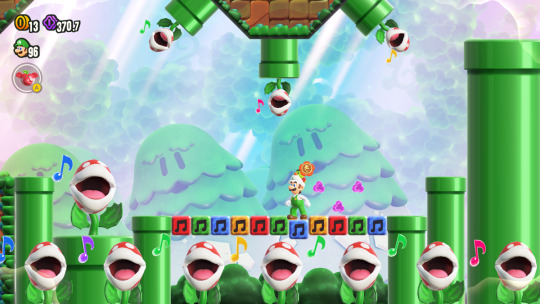
Adding to that is the sound design and music having a much greater presence here than normal. Over time, we’ve taken for granted how past Mario games have sounded, but Wonder shakes this up a bit. A jump is now the plucking of a string instrument that’s different for every character, while a ground pound is accompanied by a drum roll into a satisfying cymbal hit. Even the iconic sound of entering a pipe has been changed, replicated with a xylophone. The music in general matches the tone of each level well enough. From the early stages and their more laid back tones, to the more sinister themes of the Bowser airships, there are also several stages that feature musical setpieces that really stand out as the most memorable parts of the game. But that’s not all regarding the game’s presentation taking it up another level.
Wonder’s plot is about as simple as we’ve come to expect for the Mario series, and yet there is FAR more voice work and dialogue in this game than you’d think. Mario and friends are visiting Prince Florian of the Flower Kingdom when Bowser crashes their party, stealing one of many powerful Wonder Flowers. Harnessing their power, he merges with Florian’s castle, using his newfound status as…Castle Bowser to build up Wonder energy for…well, something that can’t be good! Florian accompanies the Mario crew in a manner similar to the assistant characters we’ve seen in the older RPG series, having something to say after major levels are beaten or when you enter into a new world. Each world itself also has its own subplot that gives a BIT more context to your platforming fun. In the Sunbaked Desert, we have to track down Bowser. Jr. and take back all the water he’s stolen from the residents. Whereas in the Fungi Mines, players have to investigate several ruins and progress further and further underground to save a group of miners that have been trapped by a cave-in. Even the talking flowers you see throughout the game help the world feel more real, like the adventure is unfolding in real time. At times they can be there for a joke, or as a more diegetic in-game hint, but they also serve as a way to test the waters for more natural voice work in the Mario series after mostly abandoning the prospect with Sunshine. On the note of new voices, this game actually marks quite the shake-up in the voice cast.
After nearly 30 years voicing the plumbers, Charles Martinet is now succeeded by Kevin Afghani. Afgahni’s take on the Mario brothers clearly takes a lot of inspiration from Martinet’s portrayal and in many cases is downright identical. His Luigi sounds uncannily like Martinet, though there are places here or there with Mario where you can hear a bit of a difference, but the transition is largely painless here. Giselle Fernandez also takes over for Daisy after Deanna Mustard’s similarly long tenure with the character, and they really capture the energy Daisy is known for overall. Nabbit is now voiced by Dawn Bennet, while Prince Florian and his Poplin subjects are voiced by Caitlyn Elizabeth and Christine Cabanos respectively. The likes of Peach, the Toads, Bowser and Bowser Jr. are all still done by their longtime actors, but this definitely feels like a new era for the series as the old guard is stepping down. It’s a bit strange to see more professional actors taking on some of these roles, as a good amount of Mario enemies and NPCs are often done by members of the sound team or even the Nintendo Treehouse, but if there was ever going to be a game to swap out a good chunk of the cast, it would have to be this one. The first of MANY changes and surprises in store!
ELEPHANTS AND BADGES AND FLOWERS, OH MY!
Within the first few moments of touching the game, I was reminded of my first impressions with the likes of Super Mario World and how different that game had been from the NES games. Wonder feels like another step forward for the series regarding not just level design and gimmicks, but core gameplay elements that aim to surprise and shatter past conventions. Don’t get me wrong though; this is still a platformer through and through. You run through stages, grabbing the flagpole at the end and gaining collectibles along the way. But each level has something that feels well and truly new and exciting to spice things up. Be it the rather large roster of new enemies, level-specific mechanics like pools of goop you have to slowly push through, or using water to cool down giant superheated platforms, there’s always something around the corner that makes for several standout levels. But the biggest takeaways for a given level will arguably be the various Wonder Flower segments.
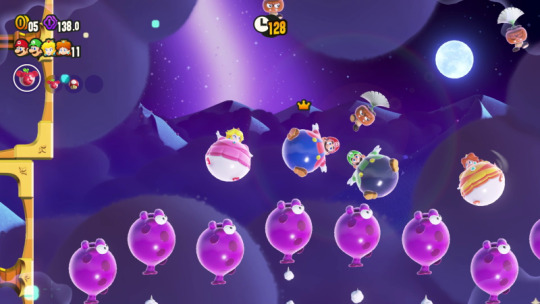
Just about every level features a Wonder Flower players can touch, which then triggers a large change to the stage that players will have to navigate in search of a Wonder Seed, which will turn things back to normal. Sometimes the stage itself starts moving like its alive, while at other times enemies might change in size or multiply, and there are even transformations that will affect the Mario crew. While a handful of effects are repeated throughout the game there are a number of completely unique ones that make for a fun climax to the stage. What’s interesting is that the vast majority of these segments are optional, allowing players to skip past them either on replay or when speedrunning, but you’ll be missing a huge part of the game’s charm if you don’t engage with them.
Outside of that, there are also new tools at your disposal to get through these stages. The Elephant Fruit power-up is the most documented part of Wonder in general, letting players become powerful pachyderms as they slam enemies away with a powerful trunk, which can also store and shoot out water. That said, its own uses feel a bit less revolutionary when compared to, say, the Cat Bell from 3D World. Other new power-ups include the Bubble Flower and Drill Mushroom, with the former letting you bubble up enemies and jump off of them for a boost, while the latter lets you burrow past obstacles and occasionally unearth secrets. Alongside the Super Mushroom and Fire Flower, Wonder uses the power ups smartly, especially with certain timed challenges that task you with taking out enemies as quickly as you can with your arsenal of abilities.
When it comes to character-specific abilities however, some might be a bit disappointed to see the cast is largely homogenous. While it’s great to play as the likes of Daisy and Peach, alongside the Mario Brothers and Toads, everyone is the same (barring the Yoshis and Nabbit, who function as “easy mode,” basically)…so that’s where the Badge system comes in. Players obtain Badges throughout the game, which come with a wide range of effects. From replicating those character-specific abilities (the very first one you get is essentially Peach’s floating from past games), to passive effects like drawing in coins or hinting at secrets, there’s even some Expert Badges that make the game harder on you. You can try out the Jet Run badge to speed through levels but there’s no way to stop running. Or try out the Invisibility Badge to sneak past enemies…just good luck platforming when you can’t see yourself either! Badges are probably my favorite addition to the game, allowing for a degree of customization with exploration and difficulty that really ups the replayability and even accessibility of the game, though I do wish there was a bit more freedom with the system. Only being allowed one Badge, even in multiplayer, is a bit of a shame, but if anything this is a great new system that I’d love to see become a mainstay to the series.
PLAYING “TOGETHER”
Speaking of multiplayer, that’s one facet of Wonder that’s drawn some ire from some circles. Compared to the past few multiplayer Mario platformers, Wonder doesn’t employ collision between players, and also limits the ways players can interact with each other. So this means no more running into people, or picking them up and “accidentally” throwing them to their deaths. This also allows the level design to no longer have to space things out for up to four players, keeping things from feeling too cramped OR too spaced out. It seems perfect and we should all be rejoicing…but for the griefers out there that love to mess with other players this is a dark day and they probably cancelled all of their pre-orders. Now, there is something to be said about being able to physically interact with players and create some spur-of-the-moment plans to grab a collectible or make it through a tough section. If someone plays as Yoshi you have the ability to ride on their backs at least, but otherwise it feels more like you’re playing alongside someone rather than truly together. But perhaps as a result of this, the online experience might be some of the best the Mario games have ever seen.
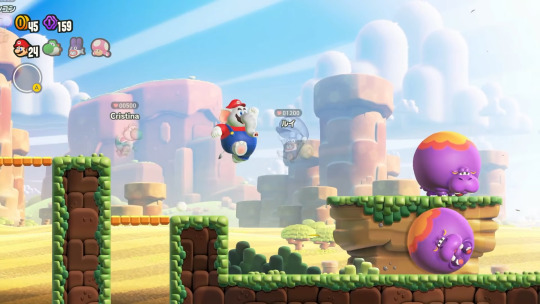
When connecting online, players will encounter “ghosts” or “shadows” of other players that can be seen but, similar to local play, can’t be interacted with normally. Players can see each other and use little emotes to communicate, but you’re all largely playing your own instance of the level. As a result though, there’s no real input delay or lag to worry about (except when players are loaded into a level you’ve already started) and you can go about your business without worrying about someone messing with you. That said, you can’t, say, ride on another Yoshi player online like you can in local play, but you do gain the ability help out other players. Players can share spare power-ups with other players even online, as well as revive players if they die if you can touch their ghost before a short timer goes down, in a manner somewhat similar to co-op in Cuphead. On top of that, online is where Standees showcase their use. Players can crouch down and press “X” to throw out a standee of their character on the spot, which can serve to either highlight a hidden block or area players can reach, but also serve as a way to revive other ghosts. Throwing down a Standee right before a tough spot can end up really helping other players out, even if it doesn’t do much for you. Players can gain “heart points” by helping other players out and finishing levels with them, which do nothing but give you a warm fuzzy feeling inside. While most online interactions are with random players that can come and go as they please, it IS also possible to make dedicated rooms with friends and engage in races through certain stages too. While the online and even co-op multiplayer might not quite be what every player wanted, I do feel that Wonder found a way to truly innovate after the last several Mario multiplayer experiences were often characterized as being chaotic and frustrating. It feels nice playing through levels and serving as a guide to less experienced players, and being able to race about with friends can be fun in its own way.
THE DIFFICULTY OF CREATING A CHALLENGE
Now, one major aspect of Wonder I was worried about pre-release was the overall challenge the game would pose. Seeing how strong the new power-ups and Badges were, combined with the ways that other players can help in multiplayer, I was worried this wouldn’t be very engaging and you could kind of sleepwalk through it. As subjective as difficulty can be for people, I do think that Wonder largely managed to keep me engaged and offered some real challenges, while also enabling players to really shape the game to their own skill levels. Mario is always going to be a series that appeals to as many people as possible. It doesn’t carry the kind of reputation that, say, the Donkey Kong Country series had regarding difficulty, but Wonder does give players a TON of options to make the game ease up on you and a lot of the difficulty can come from just NOT engaging with these options. Just avoid using Badges, the power-ups or the Yoshis and Nabbit for a more challenging run through the game. That being said, the game does pepper each world with far more challenging levels off the beaten path. Most of the world map actually allows you to tackle levels in any order you want, and levels have individual difficulty ratings so you know which ones to avoid if you want to have a chill time, or indeed which ones to seek out for a real challenge. The game’s final challenge was also suitably hard, so on the whole I was satisfied with my time with the game….with really only one exception.
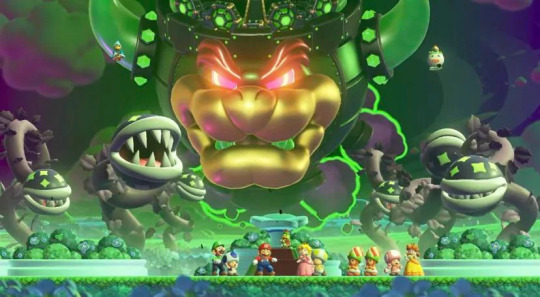
The vast majority of Wonder is designed around surprising players, constantly doing something unexpected and weird….which makes it all the more disappointing to see them drop the ball with boss battles. Now, this is a platformer and I don’t really ever go into a platformer thinking about the boss fights. If they’re fun, then that’s good enough for me, but they’re often not at the top of the list and I care way more about the levels leading up to them. In Wonder’s case though, not only are the bosses very simple and easy, they’re also infrequent and very same-y. In that regard, it’s the one thing that I think the New series handled better. You fight Bowser Jr. in most of the worlds, with the same overall idea of him attempting to run you over in his shell, with the only difference being a Wonder effect that changes up the arena a bit. But after about three or four jumps on his head the fight is over and they all fail to leave an impact. Not helping matters is that a few worlds just don’t even HAVE boss fights at all, not even minibosses like Boom Boom show up here. While the final boss at least was unique and fun, it still felt like it ended somewhat too soon and I was left underwhelmed by the finale before the post-game challenges. Again, most Mario bosses aren’t much to write home about but with every other aspect of Wonder really going out of its way to impress me, the bosses just stuck out like a sore thumb. Maybe if they had gone for a more setpiece driven platforming challenge for the final level, similar to the finales for 3D Land and 3D World, that would have been better, but at the end of the day I wish the game had just pushed the envelope just a bit further.
That being said, I applaud how accessible the game is overall, and for younger or more inexperienced players they’ll likely have enough to grapple with and be plenty engaged. Multiplayer can be both helpful but also make things a bit more tricky depending on the level, and having some easy-mode characters on top of certain badges SHOULD give everyone a chance at beating this game if they so desire. I do feel that the path to true 100% completion is a bit more fulfilling. Each level has at least two Wonder Seeds to get, one for beating it normally and one for completing the Wonder Flower segment. Some levels have secret exists that bestow another Wonder Seed though, and I had to really keep my eyes peel for hints to find those. Wonder Seeds are the only plot-critical collectible but the game also keeps track of whether or not you got three large purple coins in each level, on top of reaching the top of every flag pole at least once, so I had my hands full getting full completion and felt satisfied enough at the end, so I think they did well enough. Maybe in the future they could use the Badge system to let players tweak the difficulty a bit more minutely. Maybe give us some Badges that make enemies tougher or impose a time limit on stages (something this game notably removed compared to past games), just for some extra spice. Difficulty is always going to be tricky to balance, but for the most part Wonder excelled enough there.
A WONDERFUL START TO A NEW ERA
2023 really does feel like we’re entering into a new era for not just Mario, but Nintendo as well. A new console is all but confirmed to exist within the next year or so, and after the Mario Movie’s smashing success, on top of the debut of the Super Nintendo World theme parks, Nintendo is likely ready to make even bigger moves with their IPs, and that includes Mario. Wonder, at least according to the developers, isn’t necessarily the blueprint for every Mario title to come, but it does at the very least paint a picture that this franchise isn’t anywhere close to running out of steam. Mario’s “dark ages” are still far better than the heights of many other franchises but all the same it’s nice to see the light at the end of the tunnel here. With remakes of beloved RPGs, and games like Wonder and Odyssey taking chances and being real returns to form for both 2D and 3D platformers, the future of the series hasn’t looked this good in a while, and I’m excited to see where it goes next. I don’t know if I could say that Wonder is the best 2D Mario game, but it’s easily the best in a long while and will likely be considered a bit of a swan song for the Switch era. Endlessly creative and boasting some surprisingly novel online elements on top of playing like a dream, Super Mario Bros. Wonder is one of the easiest recommendations I’ve had in a while and even with releasing so late into an utterly packed year of amazing games, it stands on its own as far as being in the Game of the Year conversation.
Until next time,
-B
#blog#xb-squaredx#review#nintendo switch#video game#mario#super mario bros wonder#mario wonder#charles martinet#kevin afghani
0 notes
Text
The Avengers Game: The Surefire Hit That Misfired

With the stronghold that the Marvel Cinematic Universe had on pop culture for the past decade, it was all the more puzzling that they didn’t capitalize on that in the realm of video games. Superhero video games have been a thing since the medium began, but for the longest time Marvel’s gaming efforts were few and far between, outside of the rare Spider-Man title. But in 2017 a collaboration between Square Enix and Marvel was announced, with a variety of game products teased, among them being a project centered on Earth’s Mightiest Heroes. On paper, this seemed like a complete slam dunk. A prolific AAA game developer, a hot IP that hadn’t had a lot of game action in a while, and it would be landing right when the MCU hype was at its peak with the back-to-back hits of Infinity War and Endgame. But that wasn’t what happened. Something went wrong, and the surefire hit….misfired. Just before the game’s delisting at the end of September 2023, I ended up purchasing the game on a deep discount, curious at what all the fuss was about. So let’s talk about how this game ended up the way it did.
A FALSE START
Marvel’s Avengers launched in September of 2020, and to say the launch was rough would be an understatement. Broken matchmaking, a litany of bugs and performance issues, and a deeply unsatisfied fanbase. While it’s clear the pandemic had played a huge part in the game’s lackluster release state, the fact it was allowed to release like this at all was worrying. Only a month later player numbers on PC had dropped significantly and the game seemingly was in its death throes. In March of 2021 the next-gen console versions of the game released, and with it a multitude of fixes and additional content. It was clear this was an attempted re-launch of the game, but you know what they say about first impressions…
youtube
Now, to give the developers some credit, there were legitimate attempts to improve the game and add more worthwhile content. They didn’t just cut and run and leave players holding the bag. Effort was put in to making the game better and trying to right the ship, though the damage had already been done with the game’s reputation. Even as someone who got the game far after every patch and fix went out, I still encountered a ton of issues and on my last-gen PS4 console the overall experience was still rough. It feels like a game that really should have been next-gen only, but was pushed out to the last-gen systems to get as much profit as possible, in a manner similar to the ill-fated launch of Cyberpunk 2077. The sad truth here is that regardless of patches and additions to the game, no matter how many bugs they fixed and feedback they implemented, there were problems with the very core of the game, and in order to properly address these issues…they would have been better off making a new game from scratch.
THE GEAR SCORE MAKES THE HERO
One of the most hotly debated aspects of Marvel’s Avengers was its status as a live-service game. At a time when the “games as a service” bubble was about to burst, fans had largely grown intolerant of more games coming out competing for their time and money, and if you are going to market yourself as a “forever game” with tons of ways to spend money and get players to log in every day, you have to make it worth it for them and…well, I think the game’s overall reception and failure speaks for itself.
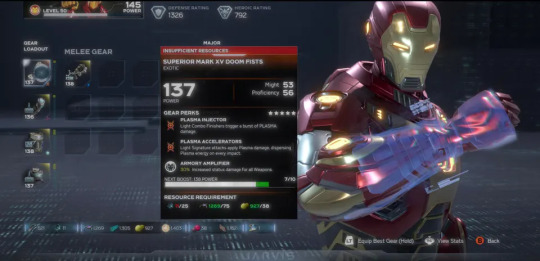
So much of Marvel’s Avengers is grinding for grinding’s sake. Everything takes longer to unlock and build up than it should, clearly designed in such a way to squeeze money out of the playerbase. After a certain point, the goal is no longer to make a satisfying game for players and instead to make it into an infinite revenue machine. At the game’s launch you had TONS of cosmetics that could only be gotten through a tedious grind of in-game currency….or you just pay up with real money. At one point the developers even tried to market an experience boosting item for players, before it was removed due to protest. Keep in mind this was a full-price game. Just a few years prior we had Marvel’s Spider-Man as a solid single-player game that had NO microtransactions at all, and a TON of costumes you could unlock by…playing the game. How novel! Speaking of Spider-Man, let’s not forget that one of the most popular superheroes of all time was made into a PlayStation exclusive for no other reason than greed. Now, I’ve played the game long after the final update just unlocked all cosmetics for players to enjoy for free, and what few things I have to unlock from in-game vendors shows me that this grind must have been awful to live through, and it must be even worse if you HAD paid for stuff without knowing that one day it would be made free with the flip of a switch.
On top of all of this, there was also artificial bloat inserted into the game’s progression systems with the focus on loot and raising your player’s Power Level. Over the last few years I’ve seen a lot of games worship at the altar of “gear score” and I hate it every time. They completely miss the forest for the trees regarding what makes loot and loadouts work in other games. Often times your own abilities as a player are downplayed in favor of forcing you to micromanage your gear, and it unfortunately infects the Avengers experience. Despite the fact that you’re playing as Earth’s Mightiest Heroes, you don’t feel all that powerful unless you have the right arbitrary number attached to the endless loot you sift through during missions. Hulk Smash….but only if you put on the wrist guards that give him plus 5% damage when it’s raining outside. Remember how in Spiderman: Homecoming Peter has to grapple with being a hero despite Tony taking away his fancy suit with all those gadgets? Or how this game’s own campaign is constantly touting the platitude that “Good isn’t a thing you are, it’s a thing you do?” Yeah well actually the gear makes the hero, so get to grinding if you want to actually embody these characters!
You constantly have to deal with gear you get from enemy drops, finding them in strong boxes, or completing missions. While you do on occasion find some gear with some tangible effects that you can tuck away for a specific mission, the bulk of gear is garbage and exists almost purely just to sell off to get a pittance of currency in exchange, or later on to feed existing gear and make it stronger. But with each mission you’ll get better and better gear, constantly having to replace what you already had, so don’t get attached. So many of the modifiers and stat bonuses to gear are so minor they don’t even feel noticeable, and what’s more, it’s all there to keep up the illusion of progression.
There’s no actual progression from the gear system; the game automatically scales to whatever your Power Level is when selecting most missions. There are SOME missions that have a higher Power Level by default that you can’t take on until you’re at that level, but they didn’t feel noticeably more challenging than other missions. Now, I never hit the Power Level cap with any character, and I’ve seen evidence that some missions are hidden from view unless your Power Level is high enough, so I can’t quite speak for the pure endgame content, but the bulk of the game showcases just how horrible the gear system is as a progression system. It’s worth noting that there’s also individual levels for each character, which actually works FAR better as a real progression system. Each level up gets you a skill point that can be put towards multiple skill tress that further expand each character’s moveset and allows for experimentation to suit different playstyles and strategies. Gear systems CAN be down well, but it doesn’t work in this game, and I can say with confidence the entire experience would have been better without its inclusion. Getting off of my soapbox then, we should probably discuss the actual contents of the game itself, starting with what many touted as the best part of the whole game….the single-player campaign.
AN INHUMAN CAMPAIGN
A fair bit of the pre-release coverage of this game was focused around the story. Well before we saw any gameplay or even know what type of game Marvel’s Avengers was going to be, they were hyping up the voice cast as if it was a movie. Despite all of that focus, the single-player campaign didn’t exactly live up to my expectations for more than a few reasons, despite a decent start.
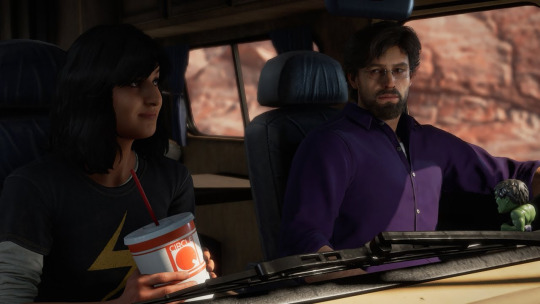
The premise is an interesting one for starters. The Avengers are blamed for a tragic accident and forcefully disbanded but years later a superhero fangirl, Kamala Khan, sets out on a journey to help clear their names and get the gang back together. Kamala is one of a few newer Marvel characters that has gotten a fair amount of buzz, similar to the likes of Miles Morales, and it’s undoubtedly great to see her take on a major role in a game like this. The early bits of the game put you in her shoes as she struggles to come to grips with her new found super powers, and the dynamic she has with the Avengers is endearing. That said, over time it started to feel like the story was being stretched thinner and thinner, and more problems started to emerge that sadly weren’t solved by the ending.
For starters, Kamala takes up the bulk of screen time. I don’t mind her being the main focus of the narrative, but for a game named after the Avengers…the team itself actually doesn’t do as much as you’d think. While we get to Hulk and Iron Man early enough, and Black Widow has a decent behind-the-scenes impact on the plot, I really feel like the narrative didn’t know what to do for Thor or Captain America. By the time the whole team is back together the game is about over, and any fun banter or moments they could have had together was mostly relegated to how they all feel about Kamala. There are times when the game’s narrative almost feels like it was written like Kamala’s fan fiction, where she is the center of everything and the other Avengers seem far too trusting and supportive of her right away, not to mention she faces little to no consequences for her actions at times. I want to stress I DO like Kamala and I think Sandra Saad does a good job portraying her, but the game gets awfully close to being a game about Ms. Marvel, featuring the Avengers, and that’s not exactly how the game was advertised.
Outside of that, I take issue with the game’s focus on the Inhumans, or rather, the lack of focus. In the comics, Inhumans are descendants of humans experimented on by the alien race known as the Kree. When exposed to “Terrigen Mist” they develop superhuman abilities, and there’s also a lot of political stuff with a royal family of Inhumans that live on the moon. In this game however, the alien aspects of Inhumans are severely downplayed, and the event that ends up releasing the Terrigen Mist and creating Inhumans here is more or less implied to be completely manmade, with no mentions of the royal family either. While it’s possible the game would have delved into the Inhuman’s alien origins later on (as certain missions do tease the Kree quite a bit in the postgame), all we’re left with in the base game is…effectively bootleg X-Men. There’s this guy, Theo, who can teleport people here and there, and he’s also bright blue…and he kind of just comes across as a less-cool Nightcrawler in every way. When you meet the Inhuman resistance later in the game, they end up being led by…Ant-Man? Because I guess they couldn’t think of or use any other prominent Inhuman character aside from Kamala. For the last few years, as Marvel began really pushing the Inhumans in the comics, TV shows and now games, it was largely as a response to not having the X-Men film rights and not wanting to promote them once the MCU took off. Many fans likewise dislike the Inhumans and view them as poor replacements for the X-Men .While I think both could have their place in the Marvel world and the premise does have potential, this particular game doesn’t really do ANYTHING of note with them.
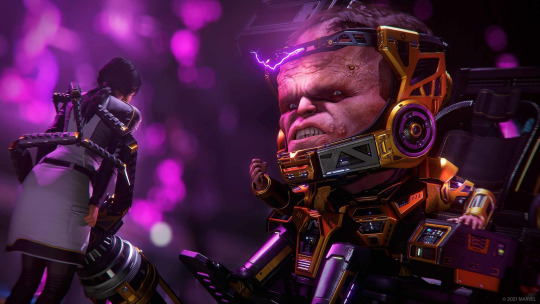
Then there’s the lack of notable villains. While on the one hand I appreciate that the developers weren’t just reusing villains already seen in the MCU like Loki, Ultron or Thanos, their use of A.I.M. and M.O.D.O.K. leaves a lot to be desired. I’m sorry, but M.O.D.O.K. isn’t a strong enough villain to carry the rest of the game, and while there are a FEW other notable Marvel villains in here, I find they’re not used well. Taskmaster is a tutorial boss fight, and Abomination is fought early on…and then that’s about it in the base game. With both of them copy and pasted into post-game missions with a vague “oh, they’re just clones” justification. It wouldn’t be until the other story expansions that we’d get a few more villains like Maestro, an evil version of the Hulk from the future, or Ulysses Klaue, a notable Black Panther villain, but at that point it felt like too little too late. And that’s not to mention that most of the basic enemies in the game are just robots with no real personality or designs that really pop, or else fighting waves and waves of “guy with gun.” What a notable roster we’re working with here.
For all of the potential that the early hours of the campaign showcased, the cracks started to form quickly and my opinion of the story only went down with time. We started with nice cinematics and character banter, some intrigue with how it was all going to come together…but steadily it became apparent that most of the Avengers were being sidelined, the villains were weak, and the emphasis on hand-crafted single-player levels and setpieces would dwindle with time, revealing the game’s true colors.
AVENGERS: AGE OF REPETITON
For as negative as I’ve been so far, I do want to stress that I DID enjoy the moment-to-moment playing of the game and it’s clear a lot of time and effort was put into making a fun action game with Marvel characters. Now, there IS a certain level of balance here to make sure everyone is equally viable, which leads to some characters not quite living up to the power fantasy. Black Widow can take on enemies just as effectively as Hulk can, while Thor and Iron Man’s flight is slow to keep them from leaving everyone in the dust. Despite that, every character has enough tools to make them pop. Hulk can grab minor enemies and use them as weapons. Kamala’s stretchy attacks let her be a menace from any range. Smacking enemies with Thor’s hammer, or flinging Captain America’s shield at multiple opponents never got old. Even the non-powered characters like both of the Hawkeyes or Black Widow were plenty fun to use, armed with a lot of tools to take on enemies and get around the giant levels. From the intricate takedown animations for each character (Thor having a penchant for wrestling, while Kate Bishop uses teleporting to take out enemies in style) to the heavy amount of customization with everyone’s skill trees, there was a lot to like about the combat…but that can’t save a game that is so dull and repetitive elsewhere.
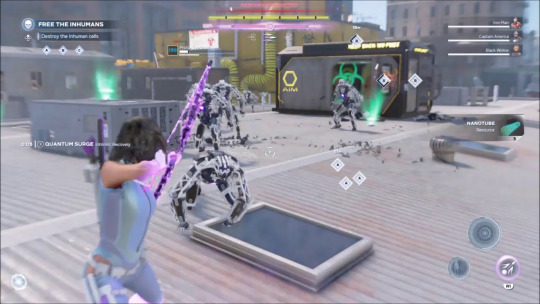
After the first few hours of the campaign I was suddenly forced to start selecting missions on the War Table and saw the game for what it truly was; the same handful of maps, enemies and objectives repeated over and over and over again. Compared to the curated single-player levels, the main missions, designed around multiplayer, are filled with massive maps that honestly felt way too big for their own good. You have to wander about as you look for small enemy outposts dotted here and there, fighting a pretty pathetic roster of enemies along the way. Not only are most enemies rather uninspired robots, but so many of them are just annoying to fight. Snipers that teleport away from you the instant you get close, endless turrets and drones that are always picking at you from far away, and more “elite” enemies that have tons of health to chew through in lieu of being more challenging to fight most of the time. Bosses are especially bad about this; most are huge damage sponges and play similarly to each other, completely shrugging off any attacks you land and taking forever to take out. I understand they’re balanced around four players but even so they would take so long to defeat and required barely any real engagement. Just dodge the big telegraphed attacks, sneak a few hits in and run, then rinse and repeat for several minutes.
Outside of just fighting enemies, your main mission objectives rarely change up in a meaningful way and just a few hours in I had seen most of what the game had to offer with objectives. Save some Inhuman hostages by opening up their cages, or defend some allies from waves of enemies. Maybe you need to use JARVIS to hack into A.I.M.’s database, so defend those computers from enemy hackers! There is on occasion some “puzzles” that would require a BIT of coordination, hitting switches or stepping on pressure plates to open doors for more loot but ultimately that was about as advanced as it got. Most level design would vary from gigantic open environments to linear corridors that are repeated so often I knew them like the back of my hand after just a handful of missions. Now, again, maybe that endgame stuff does change things up, but I’d rather not wade through so much of the same content over and over to see for myself.
And that’s the real shame here…for all the potential I see in this game, it gets exhausting quickly. It takes so long to actually flesh out your character movesets and try everyone out, but by that point you’ll have done the same handful of missions to the point of getting sick of them. Even with the expansions there just isn’t enough meat here to justify the grind. Sad as it is to say, it was painfully clear just why this game failed after just a few hours of playing.
AN UNENVIABLE LEGACY
The domino effect of Marvel’s Avengers’ failure is arguably just as interesting as the game itself. The poor showing for the game cost Square Enix a LOT of money, and was likely a factor in their decision to sell off their Western developers, including the developers of this game, Crystal Dynamics. The year after this game’s launch, Eidos Montreal’s Guardians of the Galaxy game ended up getting the cold shoulder from fans…despite the fact that it was exactly what many fans had wanted; a solid single-player experience with a great story that had a lot of love for the source material. But fans saw a Marvel game with Square Enix publishing it and assumed it would follow in Avengers’ footsteps. Elsewhere, the frosty reception to DC’s live-service superhero efforts with Gotham Knights and the yet-to-be-released Suicide Squad game can be at least partially attributed to this game’s poor performance. While Gotham Knight’s full release was devoid of microtransactions, the grindy nature of player progression and multiple in-game currencies to juggle points to it possibly being removed later in development. Meanwhile, the instant the word “gear score” was uttered at the gameplay reveal for Suicide Squad: Kill the Justice League the game was attacked by fans and the game has suffered multiple delays and as of now, it’s not clear what state that game will release in. All due to one poorly-received game!
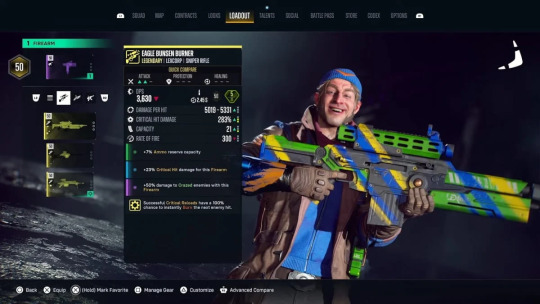
(One screenshot was all it took for people to turn on this game)
It’s clear that the live service bubble has burst; you can only get so many people to sign up for so many “forever games” before something gives. While your mega hits like Fortnite might continue on, it’s clear by now that you can’t quite compete with that and I wouldn’t be shocked if major game releases start to pivot away from this model. It’s also been argued that the superhero bubble might have burst in mainstream pop culture. Several superhero films over the last few years have not done particularly well with fans OR at the box office. From MCU misses like the third Ant-Man movie, or the latest Thor release, to DC’s extremely costly failure with The Flash, it’s possible that superhero games might also be on the way out. That being said, Marvel does still have SEVERAL other games in the pipeline, such as the next game from Insomniac, Spider-Man 2, so it’s possible this game’s failure wasn’t enough to scare them off.
It’s sad to see how poorly this game performed in the end, even if it’s easy to see why things went this way. In another world, this game could have been a smash hit, creating a platform filled with fun things to do and multiple Marvel heroes added over a very long life. I can only imagine how they might have made certain characters work if they had only gotten the chance. Had the game launched in a better state, or hadn’t gone the live-service route, things might have been very different, but regardless the damage has been done. With Square selling off Crystal Dynamics and Eidos to Embracer, and mass layoffs hitting multiple Embracer entities, Crystal Dynamics included, there’s no hope of a second chance with this title. I can only hope the best for the people involved that they can use their talents on a better game down the line
With Marvel’s Avengers officially delisted from all major storefronts and the future of the game’s online services somewhat uncertain, I thought it important to talk about this game before it is lost to the annals of history. For all the problems I had with the game, I was happy to at least play it before it was too late. I can see that this was far from a cheap cash-in title, and a lot of talented people gave their all on a game that just didn’t work out for a multitude of reasons. I can only hope that someday we can get a more successful spin on Earth’s Mightiest Heroes, and game developers can look at this game as a cautionary tale for how to somehow ruin what should have been a guaranteed success.
Excelsior!
-B
#blog#xb-squaredx#review#video game#avengers#marvel's avengers#ps4#ps5#spider-man#marvel#captain america#kamala khan#ms. marvel#square enix#Youtube
4 notes
·
View notes
Text
The Frustrating State of Splatoon 3
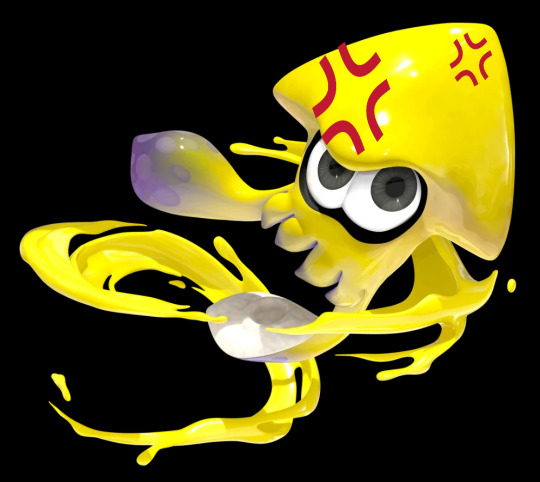
Splatoon 3 was among the best-selling games of last year, and if you read my top games of the year post you’d see that I ranked it relatively highly. In just eight years, Splatoon has gone from the strange new IP on the struggling Wii U to being a major franchise for one of the biggest game developers out there. Being right there from the beginning, it was a magical time as the game slowly came into its own. However, almost one year into Splatoon 3’s release, I find myself torn. While largely enjoying the game as much as I ever have with the past two entries, 3 in particular has some pretty glaring issues that is slowly but surely whittling away at my patience and desire to play at all. So join me as I vent a bit about the state of Splatoon 3.
THE NETCODE! IT DOES NOTHING!
When it comes to most Nintendo series, online play is an afterthought, if it has it at all. Generally speaking, the company has shown to be laughably out of date regarding their consoles’ online infrastructure and the online experiences of a lot of their big titles. So imagine the problems when it comes to designing a game like Splatoon that is predominantly an online experience. The first two Splatoon games had their share of issues but they were fun enough…but something went wrong with 3.

From day one of release, up until the time of writing, I have suffered countless connection issues and errors in Splatoon 3, far more than I had with the first two games combined. Now, to this game’s credit, there have been attempts to address certain issues that have plagued the series. Matches end in a No Contest ruling if someone disconnects early in a match, you won’t be assigned a loss if someone on your team disconnects, and people that disconnect frequently are not only assigned losses, but also can get penalized and timed out of playing. These are some great improvements…if the infrastructure for the game even worked. Splatoon 3 is one of only a handful of games on Nintendo’s updated in-house server system, and I have to imagine the developers were grappling with issues well into the game’s release and couldn’t quite smooth them out. It was extremely noticeable in the early days of the game’s release, and even after several patches that allegedly helped with matchmaking and connections, I still see issues frequently. I have pretty good Internet, and actually sprung for an Ethernet adaptor to have a wired connection with my Switch. I have rarely had issues in other games and yet I’ll still see random disconnections in this game…and then it has the gall to blame ME for it and put me in time out. Oddly enough, Splatoon 3 is pretty much the ONLY game I play currently that has any kind of punishment system for disconnections…and yet it’s also the most unstable game of the lot. Ironic, really.
Outside of people disconnecting, which isn’t always the game’s fault, there’s also the game’s matchmaking and lobbies. At first I was really thrilled with the game’s overhaul of lobbies and queuing for matches. In the previous games you’d be stuck watching a screen as people slowly filed in for a match, without much to do. Being able to now freely run around in a training room and try out your weapon while the game searches for players in the background is great! What is less great is when the game flashes a “communication error” or “one or more players disconnected” message and completely crashes the room. This happens so frequently that it’s rare I play more than one game with a given group of randoms. I have noticed far less issues when grouping up with friends, and I appreciate that it is far easier to play with friends in general here, but it still ruins the overall pacing of a game session with a lot of starting and stopping of matchmaking, whereas in Splatoon 1 and 2 I could get a faster series of matches after that initial wait.
I understand that online connectivity can have tons of variables in play. In fact, for a time this past April I had a number of online issues that took me quite a bit of time to solve. It wouldn’t be fair to expect a flawless experience every single time I boot up Splatoon 3 but even accounting for other people rage quitting or the Internet in general having some hiccups every now and then, the frequency of issues is still far too high. Even if the rest of the game was flawless, the simple fact that it just doesn’t WORK at times makes for a stain on the rest of the package. But of course there’s more to this game’s problems than this, so let’s move on.
DUDE, WHERE’S MY FLANK ROUTES?
Stage design is important in any shooter, but especially one like Splatoon, a game defined by the ability to ink and swim over any terrain. Each game in the series certainly has its ups and downs with stages, but I’m particularly disappointed with 3’s so far. I think it’s telling that my favorite stages in 3 are actually from the two previous games. There are a number of things at fault here, with the most baffling one to me being the decrease in verticality for most stages. Many stages are flatter, with less ways to get to higher vantage points. There’s also an increase in un-inkable terrain, especially regarding walls. By itself that’s not necessarily a bad decision if the developers just wanted to go into a different direction…but then why did they include new mechanics that are clearly based AROUND having more verticality? The Zipcaster special weapon is supposed to let you grapple around the stage, but on many stages the special barely has any impact. It’s like if you take Spider-Man out of New York City and see that his web swinging is far more ineffective when he doesn’t have giant skyscrapers around him at all times. There’s also the Squid Surge, a universal technique that lets you quickly shoot up inked walls, but most of the time it’s easy to forget it even exists because so few stages feel like they were designed with it in mind. Even the single player largely ignores the mechanic at times, which just makes me question why it was even included at all. It feels like the developers weren’t all on the same page here.
You could also apply that to the lack of alternate routes or flanking options in most stages. Many stages in Splatoon 3 are little more than straight shots to the middle of the stage, with it often becoming a bloodbath with no way to quickly escape. You have forced drops that make it difficult to retreat to higher ground, if not impossible. I think the stage that showcases this the most is Hammerhead Bridge, which is from the first game but has been so heavily altered it’s practically a different stage. The bridge is basically just one straight line, and as a result the stage is one series of chokepoints after another. Once one side breaks past the middle it becomes harder and harder for the defending team to force them out. Having an alternate route to get around this and flank them from behind would help alleviate the spawn camping that usually results on that stage, but they’re gone. With that in mind, Hammerhead is probably my least favorite stage in the game; matches just devolve into being the first team to push past the middle and lock the enemy down for the remainder of the match. Some stages are more open than others, but on the whole it feels like options are limited and more than ever it’s easier to be backed up into a corner. What is especially frustrating is that pre-release footage of stages like Eeltail Alley or Scorch Gorge showcase dramatically different layouts that were more open, and yet the final release leaves us with stages that drastically limit your approach to the other team. Clearly, plans changed during development.

(Stages like Mahi Mahi Resort saw drastic changes from Splatoon 1 (Left) to Splatoon 3 (Right), becoming smaller and flatter)
Now, Splatoon is a live-service game and there are constant changes and additions to be excited for, and to a degree the stage situation has gotten better. Stages like Manta Marina or Flounder Heights offer more vertical options and are mostly untouched from their previous games, though personally I’m not very impressed with most of the new post-launch stages. One aspect the developers seemed to be aware of was the power that certain ranged weapons had on some stages. Eeltail Alley and Mincemeat Metalworks could be completely locked down by a good Charger or Splatling if they claimed the middle bridge. After the 3.0 update though, signs and other objects were added to some stages to provide some cover and keep long-range weapons from having such an advantage though the changes feel more like a bandage over a larger problem with the stage design on the whole. The series has completely renovated older stages in the past and that might still happen with 3, but as it stands we’re nearly a year in without major changes. Time will tell on how well this matter is handled but for the moment there are some days I log in and see the stage rotation and just immediately close the game because I’d rather not deal with certain stages at all.
SALMON RUN: REMEMBER, YOU’RE HERE FOREVER
Salmon Run was one of the best additions to Splatoon 2, a unique co-op experience that clearly had potential to be built on in a future game. 3 definitely makes some good improvements. Having the mode available at all times for starters, and the ability to toss eggs a good distance forward is a game changer that would make it tough to go back to 2’s version of the mode. That said, other changes for the mode haven’t been nearly as welcome I find.
As a live-service game, Splatoon needs to find ways to keep players coming back for more. Players already earn rewards for playing in the mode, though it often only takes a handful of games before your bonus rewards dry up until the next shift starts. In comes the addition of the Xtrawave, and a chance to fight a King Salmonid if you’ve managed to clear all three normal waves. The Xtrawave is itself a fun challenge that can cap off a successful win-streak, without any penalties for losing. That said, the rewards for clearing Xtrawave feel very lacking for the effort you have to put in. Scales are awarded for participating in the Xtrawave, gaining more if you manage to defeat the King, on top of how high the hazard level is when the wave began. While finishing quicker with high hazard levels can net you more scales there is a hard cap on how many you can earn, not to mention good old random chance when it comes to getting the rarer silver and gold scales. In fact, if your hazard level is low enough it’s apparently just straight up impossible to get gold scales. So the mode pushes you to juice up that hazard level and play over and over and over again to get just a handful of the things…and when it comes to what you can trade them in for, you’ll be working your tailfin off to afford anything of value. There are some stickers and figurines for your locker, with cosmetic items like extra slop suit colors and even some gear you can wear in normal multiplayer, but there are some problems here. The prices are pretty absurd for how long it takes to build up any of the rare scales, and what’s more the game’s shop won’t even show you everything you can buy unless you spend some scales to “uncover” more rewards. It already takes forever to earn scales but you might be forced to buy things you don’t want just to uncover stuff you DO want…and then you’re right back to having to grind out and save up for more.
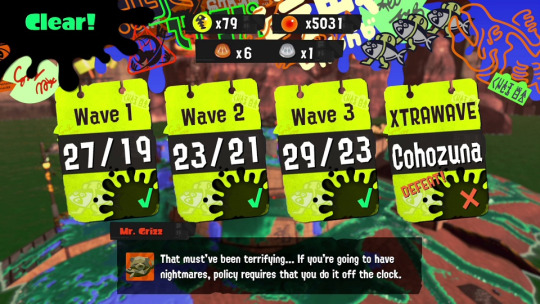
Really, “grind” is the perfect term here. This game expects you to devote a significant amount of playtime to get any form of reward, with very few ways to speed the process along. While it took them a bit to implement it, the new Big Run events do increase your scale rewards which is appreciated…but they are rare, happening at most twice in a season and only for about two days at a time. On that note, Big Run itself is an interesting idea, having the Salminids taking over a multiplayer map and pushing players to get as high of a score as possible to get a trophy. The Eggstra Work mode that was also added recently is somewhat related, having players go through five pre-determined waves in the push to get the highest score. The problem is that both of these modes only really reward the hardcore fans of Salmon Run, giving casual players few incentives to play along. The scores you need to get to even get a bronze trophy are fairly demanding for a more casual fan, and if you don’t care for score at all…there’s not much these can do for you. Splatfests at the very least grant you sea snails to further upgrade your gear, in addition to being a hyped-up event in-game centered on Turf War, the most beginner-friendly mode in the game. To be brutally honest, the continued focus on getting that score higher and higher has turned me off of Salmon Run in general. This, coupled with Salmon Run being just harder in general makes me more frustrated than anything else. Some shifts are just filled to the brim with enemies that start to mesh with one another and at times there’s so much going on the game actually starts to lag and slow down. If their intention was to keep me invested and want to come back to the mode, they managed the opposite, which is a pretty damning issue for a live-service game.
SEASONAL DROUGHTS
The success of Splatoon is largely tied to how Nintendo seemingly understood how to make a live-service continually appealing. While a full-price game, all further updates for multiplayer are free and often go for 1-2 years of the game’s life. Splatfests and other events ensure that there’s always a reason to come back later. The third game tries to change things up a bit regarding rewards and updates and honestly I think it mostly does a good job, though it isn’t without some downsides. In Splatoon 1 and 2 updates were typically weekly; every Friday or so you’d get SOMETHING new. Sometimes that meant a new weapon, or stage. Other times it might mean a completely new mode (more so in the first game). Splatoon 3 has instead adopted the season approach to content updates. Seasons last three months, and on day one of a new season players are given a ton of new things all at once. Roughly 10 new weapons, two new stages (so far the pattern being one returning stage and one brand new one), a balance patch and a new Catalog. Catalogs are effectively this game’s take on the Battle Pass that plagues so many other live-service games, though it’s mostly inoffensive. Catalogs have 100 levels to them, but pointedly cost the same amount of points to level up each time, and you get a huge bonus of points for your first win of the day. I think they serve as a decent, but attainable challenge to complete each season, without too much FOMO attached if you don’t finish them. That said, anyone that plays a lot of ranked tends to complete Catalogs quickly and then they don’t have much left to look forward to for the rest of the season.
Even if you’re not big on the Catalog, a growing sentiment with players is that the seasonal model isn’t enough to keep players coming back. All that new stuff at the start wears off before we’re even halfway through a season and the wait for the next season gets harder and harder to bear. These events like Big Run and Eggstra Work are clearly meant to help with that, though I’ve already detailed why I think these fall short. This game’s iteration of Splatfests have issues too. Going with three teams rather than two, on top of the controversial Tricolor Battles has resulted in a lot of complaints with each Splatfest, rather than excitement. Tricolor Battles were labeled as unfair to Defender players as early as the game’s pre-release beta Splatfest, and even after they were reworked slightly going into the first winter season, there’s been other issues. The Cryptid Splatfest ran into an issue where the vast majority of players picked either the Alien or Loch Ness Monster teams, with only 8% of players picking Team Bigfoot (at least in North America), meaning that the majority of players couldn’t earn points in Tricolor Battles, as they were thrown in with fellow Alien or Nessie players. And then there are the new Challenges, added with this past Sizzle Season.
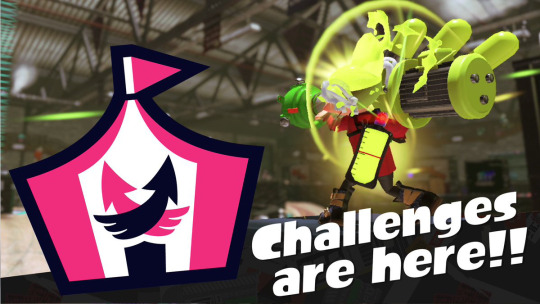
On paper, Challenges seem like a great idea. Wacky rule sets that give players another reason to turn the game back on, but again the execution is lacking. Challenges themselves occur irregularly with limited time slots. One challenge might start on a Wednesday evening from 10 PM to midnight, and the next time slot would be Thursday morning at 6 AM, as an example. If you aren’t available on that day or that specific time…tough luck. The whole issue of playing the game on its own schedule versus your own has existed since the first game, but stuff like this feels nonsensical. There’s also the fact that the rule sets vary, some being quite interesting, like fog rolling into a stage periodically, while others amount to playing one of the Ranked modes without sub abilities…which doesn’t really feel nearly as fresh. And the rewards for challenges are also fairly minor, getting badges if you place high enough (once again going the score-attack route) and if you get five wins you get…a free roll of the Shell-Out Machine. Yippee. All of this wraps back around to the same core issue in that I don’t think a lot of the content in Splatoon 3 really values the player’s time. Scheduled events are rare and you have little control over actually being able to participate in a lot of them, and the rewards just don’t feel worth the time investment, outside of the Catalog. Despite their best efforts to retain players, I fear they might actually just drive them all away.
CONCLUSION
To wrap things up here, I want to stress that I do often enjoy playing Splatoon 3 and I’m pretty sure I’ve managed to put way more time into it than the first two games combined at this point. The updates to mobility with the Squid Surge and Squid Roll feel great, the new main and special weapons are fun, visually the game continues to be fantastic and its single player campaign was a welcome improvement from the first two games. Splatoon 3 clearly benefitted from the developers having gained more experience with the previous two titles and there’s tons of overall polish and content packed into this game. As a live-service, it will also continue to change and by this time next year when the last of the planned updates will be finished, it very well might be in a better place.
I don’t like to be negative and just rant and rave without any amount of constructive criticism, and ultimately I want this franchise to continue doing well and improving itself. There’s nothing else on the market like this (we’ll see if Foamstars can holds its own I suppose), and as a fresh, new franchise for Nintendo the last thing I want is for it to crash and burn. Splatoon 3 in some respects feels like a worthy successor to the previous titles and does feature a number of positive changes and additions to the core game, but the issues are even more prevalent than ever and I really hope the developers take all of this into account with the next game, whenever that happens. Considering this game was developed at the peak of the COVID 19 pandemic, on an aging console that likely couldn’t match the developer’s ambitions, this could have come out far worse, and despite what the last 3000 words or so might tell you, Splatoon 3 is far from a bad game. It’s a good game, that at times can be great fun, just held back by a number of smaller issues that I’ve love to see addressed so this trilogy can end on a high note. Maybe in a year I’ll do a follow-up and see how things have changed, but for now I guess I’ve said my piece. Thanks for listening.
-B
2 notes
·
View notes
Text
Tears of the Kingdom Review: Building a Better Sequel
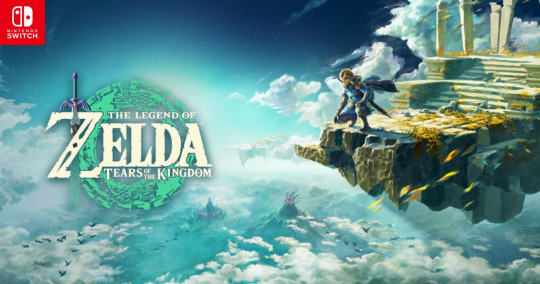
Breath of the Wild was a massively successful entry in Nintendo’s acclaimed Legend of Zelda series. It sailed past the best-selling installments, and served as both a swan song for the ill-fated Wii U console, and the first breath of life for the Switch, which has become a massive success in its own right. BOTW wasn’t just considered to be a great Zelda game, but it served to redefine how open world games could be made, and its effects on the industry are being felt to this day. A sequel seemed inevitable, but even so, many questioned if Nintendo could make lightning strike twice. After six long years of waiting, Tears of the Kingdom is here…and it makes BOTW look like a tech demo.
UPHEAVING THE FAMILIAR
One of the biggest obstacles Nintendo likely faced in development was finding a way to make the world of Hyrule fresh again, despite largely using the same map from BOTW. Their answer is The Upheaval. TOTK opens with Link and Zelda investigating the source of a strange, toxic substance seeping out from deep below Hyrule Castle. The Gloom sickens and weakens anyone that touches it, and eventually they see the source is a decayed, withered body held in place by a strange, glowing arm. Soon enough the body stirs and a torrent of Gloom is unleashed on Hyrule. The Master Sword (and most of Link’s right arm) is destroyed, Hyrule Castle is suspended high in the air and Zelda vanishes after being engulfed by a strange light. In the aftermath Link finds himself on a floating island, one of many now dotting Hyrule’s skies, with the mysterious arm having replaced his corrupted one, and with it he has two goals: stopping the strange figure and finding Zelda.
The structure of TOTK is largely the same as the predecessor, being almost completely open after players complete a lengthy tutorial. For what it’s worth, I find this game’s story a bit more interesting than BOTW, but TOTK still inherits some of that game’s issues when it comes to narrative. When you have a game where 90% of the plot is both optional and can be done in any order, it can be difficult to make things impactful and coherent. As a result, the Zelda team arrived at a solution that is understandable, but a bit grating after a point. Most main missions are largely written as if they could be the player’s FIRST main mission after the tutorial, and the end result is a lot of repetition as the same exposition dump is given to players multiple times over the entire playthrough.
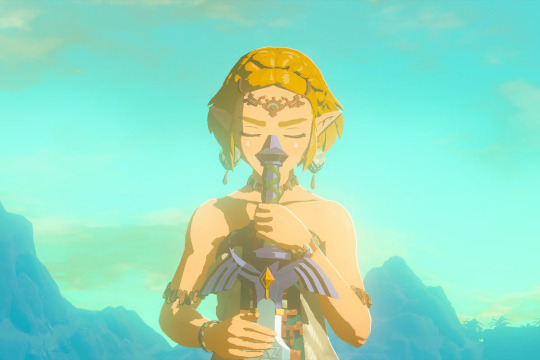
Similar to BOTW, the juiciest bits of this game’s narrative are found in the past. Link can find memories hidden away all over Hyrule, which largely explains the bulk of the game’s backstory concerning the ancient Zonai, a race of beings that were there at Hyrule’s founding but are strangely absent in the present day. This is also how we primarily get the main villain, this game’s incarnation of Ganondorf, fleshed out. As a result of the game’s commitment to nonlinearity it’s possible to skip all of the set up and arrive at the conclusion without any of the build-up, which happened to me. Suddenly I know of the game’s biggest twist and the answer to the game’s main driving question, which made any subsequent plot moment lose a lot of impact. While the game is often very good at acknowledging sequence breaks with certain quests, it was a bit annoying that the game continued to play coy despite having laid out the main answer to me so early on. Admittedly, that won’t be everyone’s experience, but that was a big issue for me that held the narrative back a bit. Well that and some bad audio mixing. It would have been nice to actually hear the sparsely used voice acting over the often booming music!
I do appreciate that this game’s overall tone is a lot more optimistic and focused on unity compared to BOTW’s almost crushing loneliness, serving to give TOTK its own identity. Link has plenty of allies right from the get-go this time around, with a base of operations near Hyrule Castle that slowly expands as the game goes on. It’s pretty rewarding to see the races of Hyrule join together, at least after you help them with their own issues Ganondorf’s revival has caused. As with the previous game, the overall art direction is also fantastic, making for some breathtaking vistas at times. As much as the Switch is really showing its age, the technical aspects of this game are proof that specs aren’t everything. Being able to load up this massive world with almost seamless navigation and juggling of physics objects is nothing short of astounding considering the Switch is little more than an outdated tablet at this point, and it manages to be at a mostly stable 30 FPS, making a marked improvement from BOTW. While I have my misgivings with some of the narrative structure, I was immediately pulled in and think the game has a great start, but there’s plenty to sink your teeth into, as I’ll demonstrate.
TIERS OF THE KINGDOM
BOTW was already a gigantic game, but TOTK pushes to somehow stuff in even more. Broadly speaking, we can look at three different tiers of the kingdom (heh), each with their own distinct feel and gameplay loop. Starting with the sky, there’s this calm, almost ethereal feeling to most of the sky islands found in this game. The Great Sky Island that players start out on definitely paints a good picture of what to expect as they continue exploring…however I found that the sky was far and away the most lacking part of the game’s world.
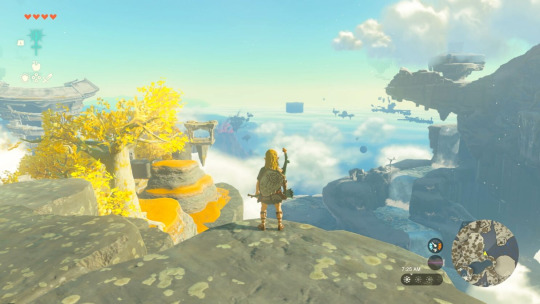
The Sky Islands are both lacking in size and frequency, a criticism that also plagued Skyward Sword from back in the Wii era. The Great Sky Island really set me up for disappointment, when most other sky structures are barely a fraction of its size and start to feel same-y after a point. You pop up into the sky, find a shrine, maybe a treasure chest…and then you’re done. Only rarely can you find somewhat larger, more interesting structures, but they’re surrounded by a TON of empty space. To a degree this is probably intentional. If the entire skyline was filled with floating islands it wouldn’t look very good from the surface, so having some room to breathe makes sense aesthetically. There’s also the fact that making sure the islands are more spaced out naturally makes it harder to get to them. You end the tutorial without your paraglider, and early in the game your stamina won’t hold out long enough to sail through the massive gaps in the sky to reach another island. That way, there’s this sense of mystery and anticipation when finding the next destination in the sky. I would look up at massive sky labyrinths or floating spheres and wonder both what was in there…but also how I’d even get up there. Even so, the fact that some sky islands are so small you can’t even really spot them on a zoomed-out map is a step too far. I’m shocked at how much they were played up in marketing when they barely factored into my total playtime.
Thankfully, there’s a lot more to this game. The surface is where the bulk of the game’s focus on community really comes into play. You have all the different villages and regions to explore, and it’s where the bulk of vendors and quests will be. Without Guardians roaming around, you notice a LOT more NPCs just out and about in Hyrule, and it was a welcome contrast to the other tiers and their relative isolation. Be it checking in on the latest gossip at stables, or getting my fashion on at Hateno Village, there was always something to do. The bulk of the game’s Shrines of Light are also found here, giving players quick, isolated puzzles that slowly drip feed health and stamina upgrades. Even if you want to go visit the sky, you’re basically required to return to the surface in search of new ways to get up high, such as the Skyview Towers invented by Purah and Robbie. These not only fill in your Purah Pad’s map, but also catapult you high into the air, giving you the chance to reach certain sky islands, or get a different perspective as you plot where to go next. But sometimes you might notice some strange areas on the surface that require…deeper examination.
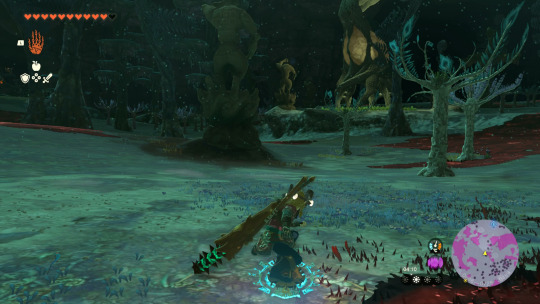
All over Hyrule players can find massive chasms that are surrounded by Gloom, but if you’re brave enough to head down one you’ll find one of the game’s biggest secrets…the Depths. A gargantuan subterranean region, I found the Depths to be a very interesting inversion of the game’s normal environments in more ways than one. For starters, compared to the boundless freedom found in the surface and the sky, you have to take it slow and steady underground. Most of the Depths are pitch black, and you never know what is lurking just beyond the shadows. Link will either have to use special seeds to create temporary light, or seek out Lightroots that can illuminate larger chunks of the map permanently. Unlike when you use the Skyview Towers to map out the sky and surface, Lightroots only illuminate a small radius around them, causing me to slowly work from root to root, occasionally being sidetracked by various treasures and structures to explore. Eventually, I noticed that Lightroots connect to the Shrines of Light found on the surface and suddenly it all came together: the Depths are just an inverted surface. Every mountain becomes a massive, deep valley. Every body of water turns into an impenetrable wall. Similar to the sky, players will have to leave the depths and find another way back down in order to get to certain areas, but even more than that…being in the Depths for so long can be fatal. Gloom is much more concentrated down in the Depths, and enemies are also infected with it. Taking damage from Gloom goes a step further and effectively “breaks” your heart gauge, requiring special meals made from Sundelion flowers found mostly on the sky in order to heal, that or natural light from the surface or Lightroots. As dangerous as the depths are though, they’re the main source of Zonaite, a special ore that will be incredibly handy when using the wide range of Zonai technology found throughout the game.
THE FUN OF CHEATING
The Skeikiah Slate from BOTW is no more, but Link has arguably better powers to work with this time around with the help of his nifty new arm. During the tutorial, players gain four main powers from the Zonai to help on his adventure and it doesn’t take long to realize that Link is so powerful now that you’re basically playing with cheat codes.
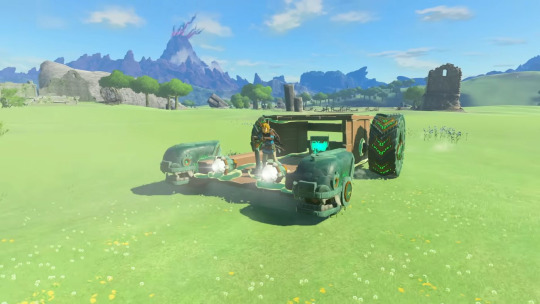
The first and likely most important power is Ultrahand. At first glance it seems like a reskin of Magnesis, letting you pick up and move objects, though this time you aren’t limited to metal. But the real kicker here is the ability to combine objects together with…basically magical glue. Take some wooden boards and glue them together, attach some wheels and BAM…you have a makeshift cart. Or you can use one of the many different ancient Zonai devices by attaching them to a wide variety of things for almost limitless possibilities. Zonai devices often look like modern-day technology, even running off of a battery of sorts that Link can upgrade as he goes through the game. Fans, flamethrowers, steering wheels…the list goes on. Some devices are just strewn about all over the game, but in the sky specifically you can find…basically gatcha machines that dispense TONS of devices in capsule form that you can store and use later on when you need them. What’s more, later in the game you can find the Autobuild power that allows you to save “recipes” of various constructions, and then assemble them quickly, being able to use zonaite if you’re short some parts. What I like about this power is that you can be as simple or as complicated as you want. You COULD just glue some logs together as a makeshift raft…or you could go out of your way to make something far more intricate. For players that’d rather not mess with the ability entirely…while the game is built with it in mind, you can still get by for most of the game without worrying about it as much. Autobuild especially helps cut down on the time spent building things as a really great upgrade too. The entire game could have easily been built around this concept alone, but we still have other powers to cover.
Fuse is effectively a combat-centric take on Ultrahand. Using Fuse, Link can take almost any object and glue it to his weapons. I can put a Zonai spring on a shield, or glue a sword to my sword. I can even put a chunk of meat on my arrowhead if I’m so inclined. Nearly every object or material in the game can be fused to your arsenal, with a variety of great effects that can make weapons stronger, more durable, or given extra attributes. As an early example, I fused a mine cart to my shield, turning my shield into a skateboard that let me grind on rails like I’m in some Sonic game. Getting elemental weapons is as easy as attaching a special fruit or ore to my weapon, and those are way easier to find than elemental weapons ever were in BOTW. Your arrows are also much more versatile now; attach an enemy’s eyeball to an arrow to make it home in on targets, or a bright bloom seed to light up the Depths from afar. Fuse allows even the weakest of weapons to be useful, which is something that just wasn’t possible in BOTW. I can take a stick and fuse a rock to it to make a makeshift hammer that’s great for breaking open ore deposits or brittle walls, so no more stockpiling rare hammer weapons or waiting on my bomb runes to recharge. It also goes a long way towards making battles more worthwhile to even do, as enemies drop horns and claws that can grant HUGE strength increases to weapons. Before, in BOTW I would eventually avoid fighting late-game enemies because they were too beefy to deal with, as you’d lose multiple weapons in the process and any weapons they dropped weren’t as good. It was a net loss. But now even fighting silver enemies isn’t that bad, since that means I can put that silver moblin horn on some middling spear I found and suddenly that is among my strongest weapons. I have my own qualms about combat in general in this game, but Fuse goes a long way towards making it more fun to experiment and stick with than ever before.
Ascend admittedly is a step down in application, but is still quite good. The fact that it was initially a dev tool should be telling enough. With Ascend, Link can jump up through any ceiling and pop out on top of the structure. Sometimes this is just as simple as going up a floor in a house, or being able to explore a deep, expansive cave and then use Ascend to leave, popping out at the very top of the mountain you found the cave in. In the depths there are even some rare structures that lead all the way back up to the surface that Link can use Ascend on. It honestly breaks traditional level design and so the game had to do a lot of careful restructuring to manage but even then with some application of your other powers, it can be pretty easy to Ascend past areas you’re meant to go through normally. But nothing compares to the power of Recall.

Initially, I thought Recall was a very situational puzzle solver. You aim at an object and can rewind it back roughly 30 seconds or so, but further applications showed that it might be the most broken of the lot. Recall has much more range than any other power, and can affect virtually anything you could also use Ultrahand or Fuse on. I’ve had instances where I’ve built a glider, only to go off course or miss my mark, and I would use Recall as basically a reset button to bring it back to a better position. Enemies dying and leaving their valuable collectibles falling off a cliff can be saved with a button press. What’s more, any movement you did with Ultrahand will be replicated with Recall, so I’ve done that to get vehicles aligned or to rise up platforms I would then Ascend onto to get up high. I’ve even completely broken shrine puzzles with Recall, nullifying any challenge they might have otherwise posed. Some might get a kick out of it, but I felt I kind of optimized the fun out of puzzles to a degree. Regardless, these powers are a lot of fun to mess with and even more versatile than BOTW’s power set was. But while we’re kind of bringing up a negative…I may as well get a bit more critical.
TEARS OF THE FANBOY
I want to stress that, despite my complaints here or there, I adored this game and just DEVOURED it over the last month or so. I put over 245 hours into it, doing almost everything of value. Playing the game for long stretches and having it basically absorb an entire month of my life…I’ll be the first to admit my own experiences and annoyances won’t be shared by many, and for normal people that just play in smaller bursts and don’t care about full completion, they likely won’t have nearly as many issues as I did. But…spending that much time with any one game is going to reveal some of the cracks in it, and those did chip away at my enjoyment a bit.
TOTK is a complex game, with a ton of things the player can do at any given moment, but I do think that Nintendo went a bit too hard on filling this game up with actions you can perform, and then realized they ran out of buttons on the controller along the way. Simply put, some actions are far more cumbersome than they should be. Selecting materials to use, either to throw or attach to arrows is tedious. You hold Up on the D-Pad, then use the right stick to find the item you want, but seeing as there are dozens upon dozens of materials you can use throughout the game, eventually that list becomes harder and harder to parse, leading to a lot of wasted time scrolling to find the exact item you need. You can hit Y to sort by different parameters, but if want you want isn’t near the front, then prepare to spend several seconds scrolling down to find it. A “favorites” option would have been a godsend here; just let me label a handful of items for quick reference. Throwing materials is also awkward, having to first throw your weapon, but then selecting an item with Up on the D-Pad as well. While I appreciate having more options for arrows and the like, the elegance of quickly swapping between arrow types in BOTW is missed here.

Speaking of direct comparisons between these two games…let’s talk Sage Powers. Compared to the Champion Powers from BOTW, these are a massive downgrade in both strength and usability. In TOTK if I want to use a Sage’s ability I have to manually walk over to them and ready them with the A button, then usually hit A again to actually use it. In the heat of the moment having to chase down my AI companions gets old fast, and then aside from that there’s the fact that the A button is already pretty multi-contextual as it is. I’ve had tons of experiences mashing A to grab items on the ground, only for Tulin or Yunobo to walk in front of me and have me accidentally activate their power and blow items away. Looking at the four powers in depth, while they have their uses they’re rarely worth the hassle of using them. Sidon’s water shield and attack is very niche, as ice attacks can do the same things as water, with the added benefit of freezing targets. Riju’s lightning arrows take forever to set up, and aiming Yunobo’s fire spin can be tedious. Tulin is about the only Sage that feels well designed, as more often than not I will always have him around to give me a boost of horizontal movement while gliding. I don’t have to worry about tracking him down, or the A button doing something else most of the time. On the ground though, he has the same issues. I enjoy having the Sages around as AI partners to take some of the heat off of fights, but compared to how simple and effective the Champion Powers were in BOTW, all mapped to different buttons and being next to impossible to accidentally do…it’s pretty disappointing.
There are other things to go over too, some of which already existed as problems in BOTW. Just as in the previous game, climbing wet surfaces is torture. TOTK introduces some solutions but they feel poorly implemented. Players can now make tonics that grant “slip resistance” to climb up wet surfaces more easily…but in practice you’ll barely notice the effects. There’s also an armor set that is said to make you immune to slipping entirely, but that is locked behind a quest chain that can take a while to complete…and then once you get the full set you realize that you need to upgrade all three pieces two times to actually unlock the hidden set bonus to make you completely slip immune. On that same note…upgrading armor is still incredibly tedious, especially when it comes to dealing with any pieces you need from dragons. Horses are also still pretty pointless to use after a point. Without even getting into the fact that they can’t be used in huge chunks of the map, like sandy deserts or rocky mountains, not to mention the sky islands or Depths…being able to build vehicles with Ultrahand basically replaces their only real function as transportation. And yet for whatever reason, whistling for your horse is still mapped onto the D-pad. In a game where they’re clearly hurting for more buttons having one relegated to something I barely even considered using is pretty bad.
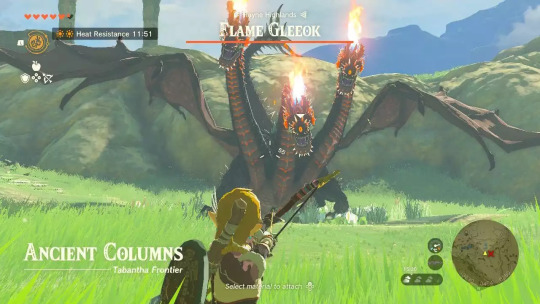
I have plenty of issues with combat in the game as well. I know Zelda isn’t a series where action is the main event, but even so the action is typically satisfying in its own way. I’d best describe it as tedious here; enemies are damage sponges, your own attacks send them far away and force you to track them down, and after a certain point the difficulty curve falls apart. I know difficulty is subjective, but both BOTW and TOTK are very strange about balance. The beginning of the game is the hardest, as you have almost nothing. But once you stockpile some meals to heal, armor to up your defense, and materials for fusion the game can’t really do anything to you. I once thought Gleeoks or Lynels were to be avoided, but getting my hands on enough Keese eyeballs to make homing arrows means I can stun them easily and melt through their health as they lay down defenseless. Mastering the parry and perfect dodge also eliminates most options enemies can even do to you. But admittedly, not everyone IS always going to be perfectly prepared for any given fight, or know that certain abilities can just render some enemies a joke. I can tell that balancing a game that is so nonlinear and open-ended is no easy task, but I do think they made players a BIT too strong at points and hope later games can find a better balance. But overall, that’ll mostly do it on the nitpicks.
CONCLUSION
When I beat BOTW, I had wished I could play it through again with my memories wiped, just so I could experience it all again for the first time. Tears of the Kingdom is arguably the next best thing. A twist on something familiar, with some curveballs thrown in for good measure. Link’s new abilities do a lot to spice up how you interact with the world, and there have been some noticeable improvements to the original’s issues, even if some still remain. With this likely being the future of the franchise, at least for now, I’m interested in seeing what lessons Nintendo can take from these two entries. For my money, Nintendo has managed to iterate on one of my favorite games out there and have made it hard to go back. I’m hard pressed to think of too many things BOTW did better, outside of the novelty of being the first game in this new style. I liken BOTW’s strength to being the joy of discovery, the appeal of exploring the unknown. While there are elements of that in TOTK, this time around the focus is on experimentation. Like the joys of playing with a tub of random Lego pieces, being able to adapt to any solution with whatever you have around, bending and breaking the rules of the game world, the end result is unrivaled freedom and depth that will keep people busy well until the next main Zelda.
Until next time,
-B
#tears of the kingdom#totk#breath of the wild#botw#nintendo swich#zleda#link#legend of zelda#video game#review#blog#xbsquaredx
7 notes
·
View notes
Text
How Monolith Soft’s Future Was Redeemed

Whether you’ve heard of game developer Monolith Soft before or not, if you’re into the gaming landscape they’re definitely a name worth remembering, and they’ve had quite the history over their 23 years in the business. Founded by Tetsuya Takahashi and Hirohide Sugiura, themselves veterans of Square from the 1990s, the company has undergone many trials and tribulations and worked with a variety of different companies from 1999 to the present day. With their latest release wrapping up the current trilogy in the Xenoblade series, I figured there was no better time than to look back and reflect on the journey the company and the founders of that company have gone through, so let’s get right to it!
TAKAHASHI’S PERFECT WORKS
Looking at Takahashi’s resume alone will show that he had a hand in a variety of beloved games during his time at Square. Working on Final Fantasy IV, V and VI among a few other titles such as Romancing Saga, Takahashi and his wife, Soraya Saga, would pitch an idea for the seventh Final Fantasy game. While rejected for being considered too dark for the brand, they were eventually given permission to develop it into their own title, which would become known as Xenogears. Takahashi and Saga had ambitious plans for the title, believing it could become a massive franchise in its own right, though the actual game’s development was fraught with issues.
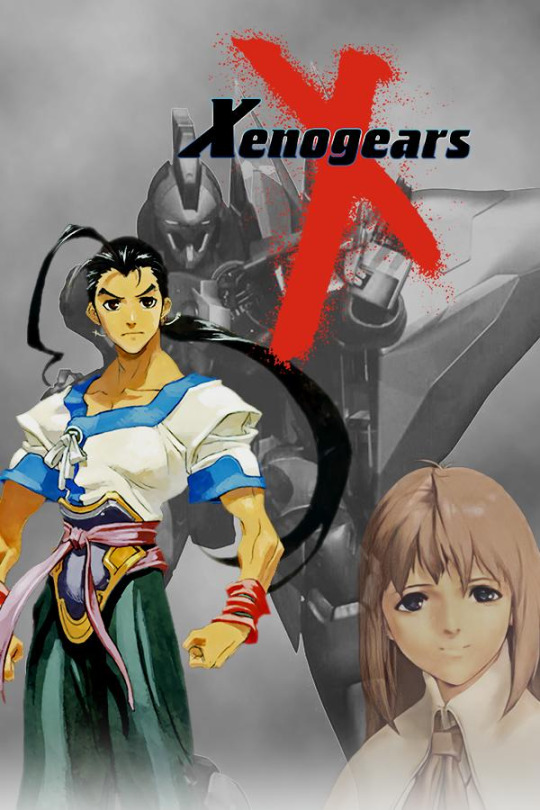
Xenogears was composed of two discs, and the first disc set up lofty expectations for the rest of the game, balancing a story steeped in religious and philosophical themes alongside turn-based battles that would utilize giant robots, or “Gears.” However, the second disc was mostly comprised of narration from characters with hardly any gameplay or cinematics. This was allegedly done as a result of both the development team’s inexperience and inability to extend the two year development deadline, and thus was done as a compromise of sorts, or else the game would have shipped half-complete. The game’s English localization almost didn’t happen, with several translators quitting the project, both due to the difficulty of translating a game loaded up with references to various scientific and philosophical concepts, on top of controversy surrounding its religious themes. Despite these setbacks, the game was still critically acclaimed and it was clear that Takahashi and Saga were keen on developing the game’s world more. Alongside development of Xenogears they had also crafted “Perfect Works,” their plans for other installments in the setting that would span a much larger story. Xenogears itself was considered, chronologically, to be the fifth part of what would have eventually been six entries.
However, Takahashi and company had routinely faced issues with Square both before and during development of this title. Growing frustrated with their prioritizing of the Final Fantasy brand above all else, they would eventually found Monolith Soft, taking with them a number of other staff they worked with. They found themselves in bed with Namco, who would publish their games for much of the 2000s. Monolith Soft would then decide to start over and craft a new franchise that would follow Perfect Works…and that game would become the Xenosaga series.
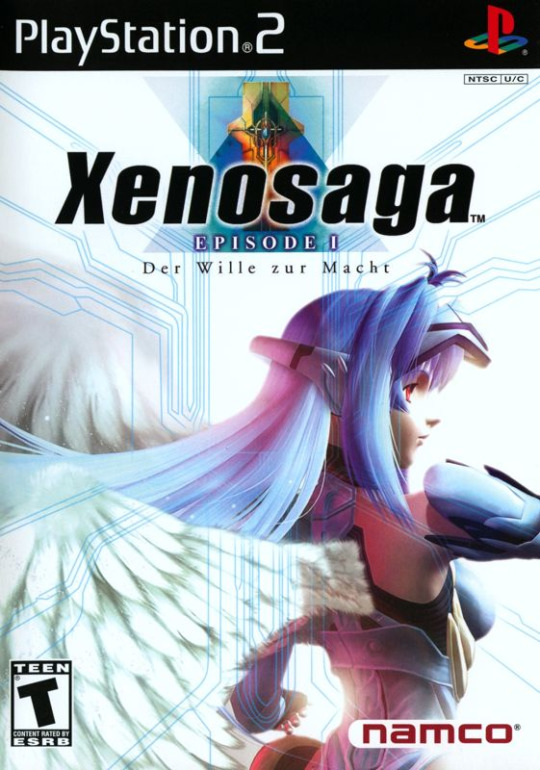
A more explicitly sci-fi series from the get go, Xenosaga was conceived as a six game series, with possible plans for it branching out into multimedia, with an animated series and manga series produced, alongside a few spinoffs titles that would end up staying Japan exclusive. A spiritual successor through and through, Xenosaga contained a number of references to the Xenogears series, alongside a continued focus on mech battles, religious and philosophical themes and turn-based combat. While the first game was a strong debut for this new franchise, each subsequent entry would sell less and less, eventually trimming the series down to three games out of its originally planned six. History repeated with regards to development issues, particularly with Xenosaga: Episode II, as Takahashi had taken on a supervising role, and the team itself was composed of newer staff that wasn’t prepared for such an ambitious title. Takahashi would admit the series underperformed on the whole, part of the reason for the sudden halving of the planned story. Despite a clean start, it seemed as if Perfect Works was anything but a perfect project, with now two failed franchises behind them. However, the winds of fate would wind up changing.
FINDING THEIR FOOTING WITH NINTENDO
Monolith Soft ended up cozying up with Nintendo as the years went on, eventually being purchased by the company and becoming a first-party studio in the late 2000s. Morale at the studio was low after Xenosaga’s abrupt ending, but Takahashi was ready to move onto a new project as a way to boost employee spirits. Coming from an image that appeared in his head of two gigantic gods locked in fierce battle, the idea would develop into a game originally titled Monado: Beginning of the World. However, at the behest of former Nintendo CEO Satoru Iwata, the title would be changed to Xenoblade, to honor the struggles Monolith Soft had undergone over the years and serve as a slight connecting thread to past projects. And the rest is history…to a point.
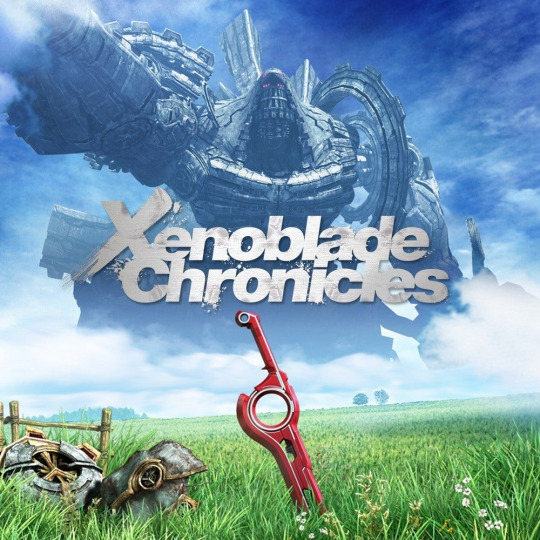
The original Xenoblade Chronicles debuted on the Wii in 2010, a massive near open-world RPG with a deep MMO-inspired combat system and an ambitious story. Compared to past efforts, Xenoblade was a game that Takahashi and company were able to realize with a comparatively smooth development, with few compromises to the original vision of the game at that. Releasing to relatively high critical acclaim, the game was initially not localized outside of Japan. Eventually Nintendo of Europe showed interest and would localize it, but Nintendo of America wouldn’t budge. This game, alongside a few others, actually inspired the “Operation Rainfall” fan movement to give them more attention and see localization (and I’ve even written about it before LINK HERE), and while Nintendo might not publically acknowledge the campaign as a deciding factor the game would eventually be brought to North America…exclusively in Gamestop stores. A low initial print, combined with Gamestop selling “used” copies at high prices, insured it became one of the harder to find Wii games, and while it was somewhat better known outside of Japan, it was still rather niche.
That began to change in the Wii U era, however. In a 2013 Nintendo Direct showcasing early looks at various Wii U games, a mysterious title from Monolith Soft was shown. Codenamed X, it was yet another massive RPG with a decidedly more sci-fi look…that sure seemed familiar. Eventually releasing as Xenoblade Chronicles X in 2015, this title would also see acclaim for its massive world and complex combat, though being a Wii U release it didn’t exactly reach many players. A year prior however, Shulk was revealed to be included in the base roster for Super Smash Bros. for Nintendo 3DS and Wii U, being the last character announced before launch. This helped to put Xenoblade as a series on the map, and gave some momentum that Monolith Soft would continue into the Nintendo Switch era.
Since their acquisition, Monolith Soft would also work as a support studio for Nintendo, particular with their Kyoto office comprised mainly of artists, creating assets for a variety of projects. Over the years, they’ve worked on the Super Smash. Bros. series (Brawl), the Legend of Zelda series (from Skyward Sword all the way to Tears of the Kingdom), the Animal Crossing series from New Leaf onward as well as the Splatoon series. Their help was greatly appreciated with the more recent console Zelda titles in particular, as they were instrumental in creating the vast expanses that would help make Breath of the Wild a smash hit. Considering they’ve lent their talents to a variety of games that have gone on to sell like hotcakes and break past previous franchise records, I think that really helped them prove their worth as an asset for Nintendo, and as such they are given license to continue their own ambitious projects.
At the tail end of 2017, the Switch’s debut year, we would get Xenoblade Chronicles 2, which would go on to become the best-selling entry in the series and experience a boon of new players. More in-line with the fantasy aesthetics of the Wii game, 2 also continued exploring similar themes and further developing the battle system shared across both previous games in the series. Despite its success, the game itself still ran into problems though. With much of Monolith staff working on BOTW it was mostly a skeleton crew on Xenoblade 2, resulting in a number of third-party artists being brought on to ensure the game could be completed, though that also led to complaints about the inconsistent art style and character designs. Technically, the game had issues at launch that were slowly patched out, and being the first simultaneous worldwide launch of the series, it was clear that the English localization was not given as much care as previous games. Despite this, it was clear that this title was what helped to establish Xenoblade as a core Nintendo IP moving forward, and the franchise continues to do well.
A BRIGHT FUTURE AHEAD
Following Xenoblade 2’s release, it would receive a prequel game as part of its expansion pass, Torna: The Golden Country, which fleshed out events happening in that game’s distant past, alongside polishing up gameplay to relative acclaim. In 2020, an enhanced port of Xenoblade Chronicles 1 would release on the Switch, with updated visuals (in particular polishing up the character models), and a new epilogue story, Future Connected. The heroines of Xenoblade 2, Pyra and Mythra, would be announced as playable characters in Super Smash Bros. Ultimate’s second Fighters Pass as well.
In 2022, Xenoblade Chronicles 3 would see a surprise reveal at the start of the year, releasing just a few months later. After the somewhat mixed reception of the previous game, 3 received rave reviews and several Game of the Year nominations. Many felt it to be an emotionally charged journey, once again spanning a massive world and containing complex combat to wrap it all together. In just a few years, the entire trilogy was now available all on one system. Not too shabby for a series initially struggling to get localized.
The major thing to remember with the Xenoblade series is that it was yet another fresh start for Takahashi and company. While still clearly its own thing, as the years went on many eagle-eyed fans would spot various references to past Xeno games. These often were seen as knowing winks and nods, but little else. When it came to various characters and story beats, there were also some connecting threads indicating that Takahashi, after all of these years, might finally be dusting off “Perfect Works” and starting anew again, after he had previously sworn it off and considered the ideas scrapped. One major change this time around however seemed to be based around making sure each individual game in the Xenoblade series would be a standalone tale that wouldn’t require playing previous entries. There were some connecting threads, yes, but ultimately each entry could stand on its own and fully realize a given theme or story idea without having to overtly connect into a larger narrative. And then Xenoblade 3’s story DLC happened.
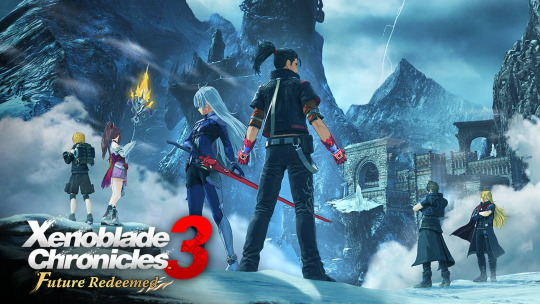
Released at the tail-end of April 2023, Xenoblade Chronicles 3: Future Redeemed was yet another prequel campaign in a similar vein to Torna. Future Redeemed would cover events that occurred in the backstory for the base game, however this time around it became clear VERY quickly that this was where it would all come together. Without getting into the details of things, on top of being wary of spoiling this expansion after it just released, Future Redeemed ends up being the means to tie the trilogy together and end it on a satisfying note, with a conclusion that gave fans a lot of closure. Various theories were finally put to rest, though just as many have sprung up in the wake of that game’s ending.
It isn’t immediately clear just where this franchise, or Monolith Soft as a company, will be going next, but my gut tells me we have some great things in store. The core Xenoblade trilogy may be done, but Takahashi has gone on record stating he wants the series to continue for as long as he can do so. There’s still a lot of clear affection for their previous efforts as well. Xenosaga’s KOS-MOS and T-ELOS were guest characters in Xenoblade Chronicles 2’s expansion pass, and there have been more…overt nods to the series in general as time has gone on. There are rumors here and there that the series might return in some form. At the very least, I’m sure many a fan would be happy with simple ports to current systems, but we’ll have to wait and see just where Takahashi’s Wild Ride takes us.
In the end, I’m just happy to see that Monolith Soft has managed to turn out alright after all these years. I first became aware of them when, on a lark, I picked up a copy of the original Xenoblade. I was struck by that game’s scope and ambition and I’ve been a diehard fan ever since. Seeing just how much they’ve been carrying Nintendo into the Switch era, I think it’s only fair that they get the respect they deserve. On top of it all, it sounds like the company promotes a fairly healthy work/life balance, and their time with Nintendo has enabled them to see their visions through with few compromises. A win-win for all involved, really. Their own original entries might always be a bit niche and definitely won’t be everyone’s cup of tea, but I’m glad their ambitions are becoming more and more realized as time goes on. From humble beginnings in the trenches at Square, to now being a pillar of one of the Big Three game publishers, I can’t wait to see the heights that Monolith Soft can climb.
-B
#xenoblade#xenoblade chronicles#xenogears#xenosaga#perfect works#KOS-MOS#rex#shulk#elma#noah#mio#monolith soft#tetsuya takahashi#wii u#switch#videogames#blog#xb-squaredx
30 notes
·
View notes
Text
Gaming in 2022: A Look Back
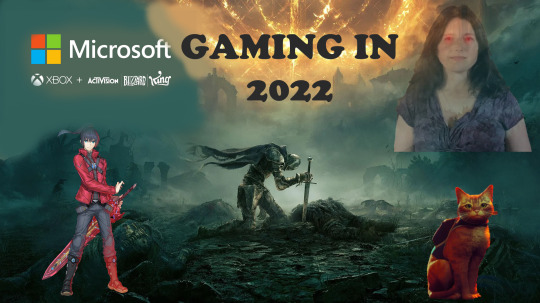
With another year behind us, many have a lot to look forward to, especially in the realm of gaming. That said, it’s also important to take stock of just what happened last year. While it’s taken me a bit of time to get this out there (December was a pretty crazy month), it’s time to look back on gaming in 2022, from the highs to the lows and everything in between. Some interesting trends, drama and surprise comebacks are in store for us so let’s get started!
THE BIG THREE (AND EVERYONE ELSE)
Let’s start with a quick recap of the highlights for some of the biggest companies in the gaming sphere. First, the Big N: Nintendo had a pretty interesting year. The Switch continues to sell well, currently sitting at 114 million units sold, with it now working on overcoming the strong sales of their most successful handheld consoles. Despite loud cries for a Switch successor, sales haven’t really slowed down. In fact, at multiple points this year Nintendo made headlines for strong sales, with the much awaited Splatoon 3 breaking records for the best Japanese launch ever, just a few years after Animal Crossing: New Horizons crashed past the previous record. And just a few months later Pokémon Scarlet and Violet threatened that record as well. Overall, strong sales for many games and some mostly well-received titles too. It was a year for trilogies as we saw the release of Xenoblade Chronicles 3, Splatoon 3 and Bayonetta 3 within quick succession of each other, not to mention Kirby and the Forgotten Land as a strong debut for the pink puffball’s first fully 3D outing. That said, other titles weren’t as warmly received: Nintendo Switch Sports and Mario Strikers: Battle League have a somewhat lukewarm reception, receiving criticism for lacking content that would be rectified with free updates throughout the year. As far as big reveals, the long-awaited sequel to Breath of the Wild was fully unveiled as Tears of the Kingdom, though would be delayed into May of 2023. Adding to this, in a bit of a swerve Nintendo would reveal a two year plan of DLC tracks for Mario Kart 8 Deluxe, on top of reveals like Fire Emblem: Engage and Pikmin 4 slated for 2023. One of the most talked about gaming topics in 2022 however was the full unveiling of the Super Mario Movie. While the casting of Chris Pratt as Mario still draws criticism, once full trailers were out showcasing the rest of the cast and gorgeous visuals the overall perception of the movie has become quite positive as it approaches a 2023 release as well. A busy year for Nintendo, with plenty still on their plate moving into the new year.
Microsoft’s efforts this year have been fairly mixed. On the software front, they didn’t really bring much to the field this past year, something they’ve acknowledged themselves. Outside of some smaller, more narrative-driven games like Pentiment or Immortality the bigger IPs currently tied to Xbox are very quiet. Games like Everwild or Hellblade 2 seem a ways off, with other large titles like Starfield delayed into 2023. On top of that, the overall reception to Halo Infinite continues to be mixed for such a tent pole release. Various updates like co-op or the Forge were constantly delayed, with split-screen co-op, a mainstay for the series, having been dropped entirely. Really, the biggest news out of Xbox this year was Microsoft shocking the industry with the attempted acquisition of Activision and Blizzard. While negotiations are ongoing, with the FTC getting involved at points, there has been much discussion generated about the potential purchase. Microsoft has had some pretty wild arguments as they attempt to paint buying up a gigantic company right off the heels of buying another giant company with Bethesda as necessary to compete with the likes of Sony, though the current heads of the FTC don’t seem to be buying them. Hard to tell where the news will go from here, but it was definitely one of the biggest stories to come out of gaming in 2022.
Lastly from the big three we have Sony, which also had a somewhat slower year. When it comes to large, first-party releases they were spread fairly thin. Horizon: Forbidden West came early in the year, though all discussion on it seemed to be snuffed out just weeks later with the release of Elden Ring, Fromsoftware’s latest smash hit. While we would see releases like the Last of Us remake later in the year, discussion didn’t really pick up again until the proper release of GOTY contender God of War: Ragnarok. Two prestige games to bookend the year isn’t too shabby for Sony, on top of their continued efforts to make certain first-party games available on PC, such as the first Horizon game, 2018’s God of War, the Uncharted series and now one of the few true PS5 exclusives in Returnal. On that note, it would seem that 2022 is the last major year for cross-gen games, which has somewhat contributed to the latest console generation’s rather sluggish start (but hey, a global pandemic on top of several other issues will do that). As the year went on however, it does seem as if PlayStation 5 consoles are becoming slightly easier to acquire and sales are generally on a positive turn, at roughly 30 million consoles sold at the end of 2022. As a response to Microsoft’s continued bids to acquire studios, Sony has also announced a plan to purchase Bungie, likely in a bid to have them craft a first-party multiplayer title to compete with the likes of Halo, Bungie’s former claim-to-fame, or even their own efforts with the Destiny series. Sony also caught flack for their VR support this year, revealing not only the hefty price tag on the PlayStation VR 2, but that it would not be compatible at all with the previous VR system. For the big movers and shakers of the industry we’re definitely seeing the ongoing aftershocks of the COVID-19 pandemic, with delays and dry spells, not to mention supply issues, though it does seem that stability is on the horizon.
For the smaller developers out there, there’s definitely some good and bad spread around. Fromsoftware finally released the long-awaited Elden Ring and created a smash hit the likes of which the company hasn’t seen before, selling over 17 million copies by 2022’s end. In addition to winning Game of the Year from The Game Awards, they also dropped a full reveal trailer for their next project, Armored Core VI: Flames of Rubicon, which delighted many long-time fans. While many have argued over just how successful the company has been in recent years, some still calling them a rather niche developer, Elden Ring’s success seems to have cemented Fromsoftware as among the most prominent Japanese developers, and all eyes will be on their future work.
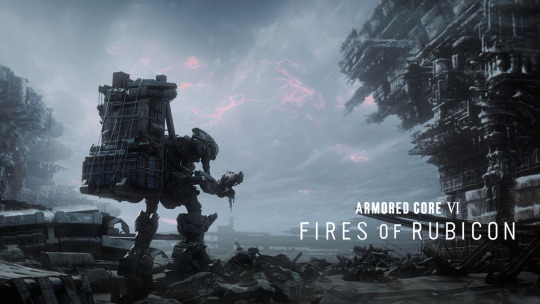
Square Enix had a somewhat rocky year. While further details on the likes of Final Fantasy XVI, as well as the next installment in the Final Fantasy VII “remake” were real highlights, alongside the reveal of Kingdom Hearts 4, a number of smaller titles released throughout the year were more mixed. The strategy game The Diofield Chronicle, the action RPG Valkyrie Elysium and farm sim Harvestella had a so-so reception, but then there were more acclaimed titles like the Live A Live and Crisis Core remakes, as well as Strange of Paradise: Final Fantasy Origin. But the year started with quite the one-two punch of Babylon’s Fall and Chocobo GP, both lambasted by critics and players alike. The former was seen as a disappointing action MMO, with the latter being a greedy live service racing game that held back what could have otherwise been a welcome remake of the older Chocobo racing games. But far and away the biggest story coming out of Square Enix was selling off their western studios to Embracer, and not long after the sale Embracer would close down what was once Square Enix Montreal. For one of the more prominent developers out there, it was quite the spotty track record this year.
When it comes to third-party consoles or gaming platforms, we saw the death of one and rise of another. Google’s Stadia, a cloud-gaming service, was formally shut down, though customers were refunded all purchases, so there’s that! Elsewhere, Valve released the Steam Deck, effectively a portable gaming PC to mostly positive reception. While likely not going to overtake the Switch anytime soon, it stands as a viable alternative for gamers that want more portability with much better specs. All things told, the industry has had its fair share of ups and downs, but it continues onwards, and as a result there are some interesting trends coming out of the year.
A NEW ERA OF FIGHTING GAMES, THE REVIVAL OF HORROR AND…SONIC IS GOOD AGAIN?
We’ll start with my personal bias and once again dive into the world of fighting games. Generally speaking, things have been on the upturn for the fighting game genre. The pandemic finally forced Japanese developers to recognize the importance of quality netcode and we have been hit with multiple announcements of retrofitting the netcode into older titles, and even more current titles. Arc System Work’s entire modern catalogue has either had rollback added or will be added in the near future, while enjoying continued success with Guilty Gear Strive on top of the release of DNF Duel. Strive’s DLC also ended up getting quite a bit of attention throughout the year, with the release of Testament, a nonbinary character and fan-favorite Bridget, who has come out as transsexual in this new installment, many praising ArcSys for their portrayal (mostly). SNK isn’t far behind, releasing King of Fighters XV to great acclaim, with it boasting quality netcode, on top of them announcing the implementation of rollback for the most recent Samurai Shodown game as well as announcing a new Garou game to end the year on a bang. After the mixed reception to the previous entry, the proper unveiling of Street Fighter 6 has been extremely well received. The updated visuals, warmly-received newcomers to the roster, impressive online and a bevy of single-player offerings has many hyping this up as perhaps the best Street Fighter yet, due out in June 2023. Namco fully unveiled Tekken 8, and while concrete details are still unknown, many praised the updated visuals and hope the game’s netcode will be up to snuff with the competition. We also saw the release of MultiVersus from Warner Bros. A platform fighter starring a gaggle of characters from various IPs under WB’s control, it managed to make massive waves as the open beta hit, becoming the best-selling game in July with over 10 million downloads in that first month alone. Being a successful free-to-play game certainly gives other full-priced fighting games some pause, though it remains to be seen if this success might impact the genre in a greater capacity. Still though, things are looking good for fighting game fans, but they’re not the only genre fans eating well.
Horror fans have had their ups and downs, though in recent times the genre has seen a resurgence of sorts, and not just from smaller indie games this time either! Fans were hit with a double-whammy of reveals for the long-rumored Resident Evil 4 remake, alongside a Silent Hill 2 remake. In addition to confirming an Alan Wake remake, Remedy would also confirm work on Alan Wake 2. In an ironic twist, EA has also prepared a Dead Space remake launching just a few months after the spiritual successor The Callisto Protocol. That said, there were still some smaller developers out there that deserve some spotlight, and late in the year horror fans were suddenly gifted with Signalis, a stylish throwback to classic horror games that has been very well received.
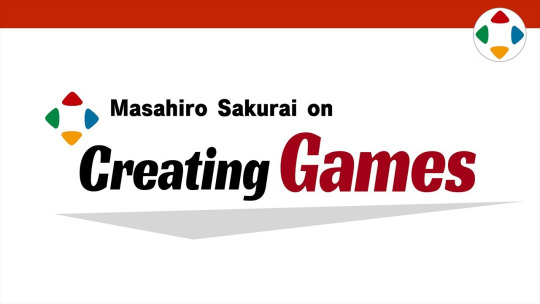
Something that might be a bit of a coincidence this year was a number of people from the game industry sharing their insights with pivots into the likes of podcasts, and YouTube videos. Industry legend Hideo Kojima is starting his own podcast, while former employees from Nintendo of America, Kit and Krysta, launched their own podcast and shed some lights on the inner workings of Nintendo. Probably the most interesting of all though was Masahiro Sakurai, the man behind Kirby, Super Smash Bros. and Kid Icarus Uprising becoming a YouTuber as he has entered “semi-retirement.” His YouTube channel boasts surprisingly high production values as he offers up a variety of game development tips, tricks and insights delivered in entertaining, concise videos at no cost. That certainly wasn’t on my Bingo card for this year.
We can keep the positivity going strong here, as 2022 was a fairly good year for adaptations of games for the most part. While there were some panned ones, such as the Uncharted movie, the Netflix Resident Evil series, and the live-action Halo series, this was also a year that gave us some solid animated adaptations. Arcane was seen by many as a fantastic look into the world of League of Legends, with amazing animation and an emotional tale that had people excited for more in that game’s world. Netflix’s Cuphead animated show also received a warm reception from fans for paying tribute to classic animation and giving players the chance to see a different side of the quirky cartoon cast. Something that caught everyone off-guard was the runaway success that was Cyberpunk Edgerunners. While tying in with the CD Projekt Red video game, this also draws from THAT game’s inspiration, the Cyberpunk tabletop game. Animated by Trigger, Edgerunners had praise heaped upon it for the stylish animation, emotional gut punches in the story and embodying the style and flair of the cyberpunk genre even better than the game did. It was so successful it had a pretty large impact on the game’s sales as well. There was also the second Sonic movie…and speaking of…
So, Sonic has had it pretty rough for a while now, we can agree on that right? A punching bag to the gaming population at large, he hasn’t been seen in a positive light by anyone but the most diehard fans in quite some time, and yet 2022 seems like it might just be the start of a redemption arc for the blue blur. While the first movie was successful, the second movie in particular did quite well with a third movie already green lit, on top of a separate Knuckles series on the Paramount+ app. Elsewhere on the animation scene the Netflix show, Sonic Prime, has been mostly well-received for its energetic animation and interesting premise, though we only have a scant few episodes to judge it right now. The IDW comics have received praise for quite a while now, but the real test was the release of the first major Sonic game in years: Sonic Frontiers. While opinions are somewhat split, the overall consensus has been positive. Most consider the game a step in the right direction for the series in terms of tone and storytelling, the plot itself penned by IDW comic writer Ian Flynn. The open world…or rather “open zone” gameplay has mostly been well-received with particular praise given to Sonic’s control. The soundtrack also goes pretty hard too, just to give my own two cents. For the first time in a while, Sonic has a lot of positivity surrounding him and it’s great to see the underdog come out on top for once.
THE BIGGEST HITS AND MISSES OF 2022
If we’re talking underdogs though, indies are always struggling against the bigger dogs in the industry, so it was quite cathartic to see one of the more successful sleeper hits of the year come from one person. Luca Galante, also known as poncle, published Vampire Survivors in early access in late 2021 and the game truly blew up in 2022. A shoot ‘em up where players maneuver through waves of enemies as their character attacks automatically, the game boasted a roguelike design with random power ups and such strewn about to make every run of the game unique, alongside a consistent dopamine hit of new weapons, power ups, and synergies to continuously experiment with. While the overall presentation is a bit cheap, the game itself is quite cheap, with strong word of mouth allowing it to become of one of the best success stories of the year, inspiring a number of imitators in the short time it’s been out.
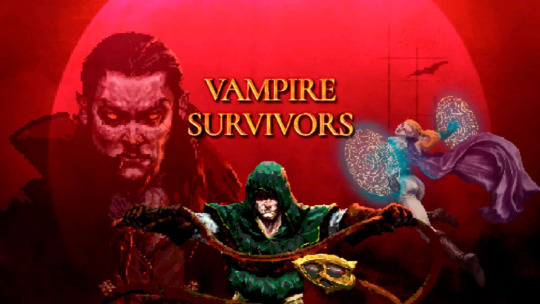
When people look back on 2022, there are quite a few games that managed to stand out in one way or another. Elden Ring certainly is among the biggest winners of the year with tons of acclaim and sales success, there are the big aforementioned Sony prestige games with Horizon and God of War, Nintendo’s three-hit combo of trilogies with Bayonetta, Splatoon and Xenoblade, on top of a few other notable games from smaller developers. Asobo Studio’s A Plague’s Tale: Requiem and Bluetail Studio’s Stray managed to garner quite a bit of attention. The former continues from the previous A Plague’s Tale’s brutal and unnerving rat-based horror and for Stray…well, who wouldn’t want to play as a cute cat in a robotic, post-apocalyptic setting? There’s honestly a huge amount of games that came out last year that deserve tons of attention. Beat ‘em ups got a fair share of play with River City Girls 2, Teenage Mutant Ninja Turtles: Shredder’s Revenge and Sifu. The former two build off of classic 2D beat ‘em ups and have some gorgeous pixel art, while Sifu embodies the style and flow of martial arts movies, with the added twist of your character aging with every death and giving players a hard limit to how many times they can die before having to start from scratch. I wish I could list every single notable release, but there’s only so much time I could use to spotlight them all.
Not every game is perfect, or for everyone, but a good many games this year got raked through the coals from fans and critics alike for a variety of reasons. Considering the ongoing allegations from Activision-Blizzard, not to mention the potential Microsoft buyout, is it any surprise that the release of Overwatch 2 would generate such controversy? For starters, many weren’t exactly on board with the game’s seemingly minor changes to aesthetics and the paltry amount of new heroes at launch. Overwatch 2 changed gears to a live-service model complete with a battle pass that forces players to grind to obscene amounts to unlock new heroes to play as, and at launch received flack over the requirement of a phone number for voice chat that actually locked out certain players if they weren’t on specific plans. The fact that the original game was absorbed into Overwatch 2 and is no longer playable also didn’t go over well. Of course that isn’t to say the game didn’t do well though, so it goes to show how even massive controversy can’t really keep people from their favorite games.
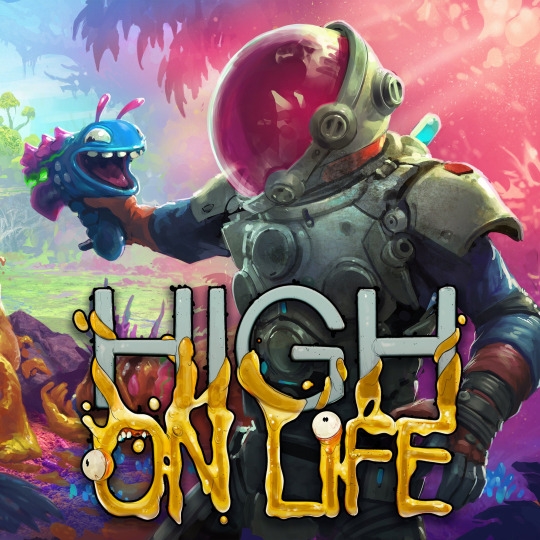
Similar flack was levied at Gotham Knights, a co-op action game set in the Batman universe that was lambasted by many for an overly repetitive, grindy design that was very likely going to follow in the footsteps of the Square Enix Avengers game that crashed and burned awhile back, though any live-service elements were stripped out of this one. The Saint’s Row reboot, however, not only got lambasted by longtime fans of the series, but the sales apparently weren’t all that impressive and developer Volition isn’t in the best straits at the moment. Despite riding high on the hype of being a true Dead Space spiritual successor, The Callisto Protocol was seen as a disappointment by survival horror fans for the game’s strange focus on melee combat, as well as a subpar PC release. Probably the most overtly reviled game this year, at least on social media, was High on Life, a first person shooter by Squach Games. While by itself a competent FPS with some neat combat and puzzles, for many the kiss of death was the heavy involvement from Justin Roiland. Even BEFORE all of the drama with Roiland’s sexual abuse scandal, many had grown tired of the same voice Roiland put on for many characters as well as the rambling, improv-heavy dialogue…though it still seemed to do quite well on Game Pass so…make of that what you will.
BAYONETTA BOYCOTTS, BROKEN BACKS AT TWITCH CON, AND CONTINUED CORPORATE KERFUFFLES
While Nintendo largely skates by with games that are, at worst, a bit disappointing, they managed to find themselves in quite a few controversies this year. While the release of Bayonetta 3 should have been a welcome one for longtime fans who could finally play the game after a lengthy wait from the first announcement, mere weeks before release Helena Taylor, the former voice of the titular character, took to Twitter and called for a boycott of the game. She alleged that she had been offered a mere $4000 for her voice work on the game and she had argued for a fair wage only to be rejected. While further investigation would show she wasn’t being entirely truthful, the debacle ended up making Bayonetta 3 a catalyst for extended talk about how voice actors are often undervalued by multiple industries. The game’s release itself generated some complaints levied at its ending as well, though nothing nearly as big as the VA controversy. Considering Platinum also launched Babylon’s Fall this year, a game that crashed and burned almost immediately after and will be shut down not long from now, it’s been an off year for them. Then there was the launch of Pokémon Scarlet and Violet. You would think one of the most profitable franchises of all time would have something approaching quality control and yet the release of the latest generation of Pokémon games resulted in this game joining the likes of Cyberpunk 2077, and the GTA Trilogy in what is becoming a trend: releasing highly buggy, borderline broken games right at the end of the year. The game’s poor performance in the open world, alongside various visual and audio bugs made the rounds on social media, with many once again questioning why such a prolific series would allow games to release in such a state. Despite that, many felt the games were among the most fun in the franchise in a good long while, praising the open-world approach, which softened the blow somewhat.

Then, just as the year was about at its end, Nintendo once again drew the ire of the Super Smash Bros. competitive scene. After partnering with Panda Global last year, many had hoped this was the start of Nintendo working well with eSports and competitive Smash, but the cancellation of non-Panda events, including the Smash World Tour opened old wounds. The Panda CEO, Alan Bunney, would step down but that hasn’t stopped roughly 80% of Panda’s signed players from leaving the company in protest. Panda allegedly got Nintendo involved in closing these other events down, seemingly eyeing a monopoly and as it stands 2023 is likely to be a very rocky year for the Smash scene, and serves as a stern warning to others in the fighting game community about the dangers of working with corporations on their terms.
Outside of some games being of lower quality though, the industry at large, like anything else, still has some unsavory dealings that sprang up throughout the year. Admittedly the year was off to a good start, with Riot forced to pay up as a result of their sexual harassment case. Sadly, comeuppance like that wouldn’t exactly last. Hard to pick where to start here, really. Rooster Teeth, an entertainment company with roots in the gaming industry, is no stranger to controversy but in October of this year a former employee alleged mistreatment at the company on a number of grounds that Rooster Teeth itself acknowledged in a response, claiming that they would do better, though I suppose old habits die hard.
Twitch Con was the subject of some controversy during the event in October. A ball pit ended up being the site of multiple injuries by attendees, the foam bits used to fill it not being very deep and solid concrete found underneath. One attendee, Adriana Chechik, broke her back in two places, the tweet showing this going viral and putting eyes on Twitch Con’s lack of safety precautions. Seeing as Twitch also changed up the revenue sharing with creators, going from a 70/30 split to 50/50, they aren’t exactly gaining any fans at current.
Late last year to the surprise of many G4TV returned to television. A revival of the gaming-centered channel, featuring a number of new and old talents attempting to reclaim that magic from the early 2000s sadly closed its doors late this year. The news itself went out in a tweet that ended up being the first time many members of G4, such as Jirard the Completionist, would find out they were losing their job. While G4 was once a big deal in the gaming scene, I think this revival showcased just how much the landscape in gaming media and journalism has changed. As disappointing as it is to see the channel fail once again, at least you got Scott the Woz episodes on cable for about a year so…n-no that doesn’t really seem worth it at all, does it?
The man who is often credited as the creator of Sonic, Yuji Naka, ended up in the news several times this year, and in the process has lost much of his once lauded reputation. Following the disastrous release of Balan Wonderworld back in 2021, Naka made headlines as he addressed some behind the scenes drama regarding the game’s development. He claims he was shut out of development and his vision was not fully respected or realized with the game, laying the blame solely at the feet of Square Enix and Arzest, who assisted with development. However, later in the year he would be hit with not one but TWO different arrests over insider trading so…maybe he’s not exactly squeaky clean either.
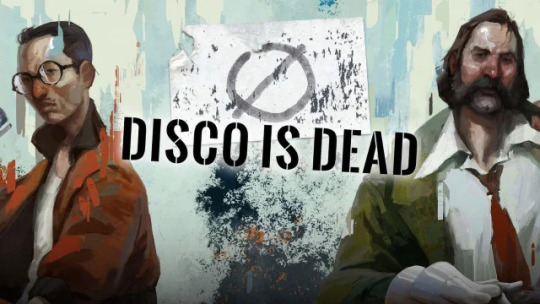
(Photo credit to gamepressure.com)
Perhaps the most unfortunate bit of business this year has come from ZA/UM, the developers behind the acclaimed narrative game Disco Elysium. The ZA/UM Cultural Association, separate from the development studio, was disbanded last year and three of the leads behind Disco Elysium were ousted from the company. There have been accusations that the current leadership ousted them under false pretenses and as it stands now, the original creators of the Disco Elysium game are suing the company. Taking a game that was lauded for its iconic artwork and writing, a deeply satirical tale that took shots at politics of all kinds, and seeing unchecked corporate greed ousting the creative leads that gave that game the special sauce that led to such acclaim is saddening. At the moment it is unclear just how things might shake out with court proceedings and if any other accusations might be unearthed, but going into 2023 it isn’t exactly boding well for the in-development sequel.
On a somewhat lighter note, 2023 had some surprising leaks and resurfaced projects hit mainstream attention. An older version of the infamous Duke Nukem Forever was found, hot off the heels of a leaked copy of the cancelled Rayman 4. Considering how hard it can be to find these pieces of gaming history, if nothing else these are interesting finds. That said, there was an extremely substantial leak from Rockstar from the still in development Grand Theft Auto 6 game that garnered the most attention this year. It just might be the biggest leak of a high profile game at the moment, and quite a lot of discussions stemmed from it. Some complained about having a female lead, others criticized the game’s visuals…despite said game not having a set release and judging it solely off of footage from in-development builds that are not meant for the public eye. If nothing else, it likely made things even more difficult for the developers and someone likely lost their job from this if nothing else. With remote working becoming a bit more of a standard as the pandemic lingers on, it’s likely that proper security practices will have to be updated to adapt to the new development environment.
IN CONCLUSION
Whew! A lot can happen in a year, who would have guessed?! It’s a lot of work combing through all kinds of articles, podcasts and social media posts as I curate topics for discussion but I find it a labor of love for this industry and the games that are birthed from it. Remembering the big news stories of the year, the biggest games and the most notable flops…it all helps to put things more into perspective. Sometimes you can see new stories and the biggest titles of the year coming far in advance. Elden Ring was always going to be big, for example. But then there are the surprises of the year: Vampire Survivors coming from out of nowhere and garnering huge success, for one. Sonic’s redemption arc isn’t something I was counting on this year but it’s a welcome surprise nonetheless. While a LOT of bad can still be found in this industry, it’s important to take that alongside the triumphs. Gaming has really never been bigger than it is now. The Game Awards accrues more viewers than the Oscars, and while it’s been off to a slow start, a big shiny console generation is really starting to kick off. We have big games to look forward to, and plenty of surprises are surely in store. I try to stay positive and while I ended on a bit of a downer this year (again), it’s clear the industry will continue to move forward. 2022 was a solid year with some really big games, and 2023 is shaping up to surpass it in some regards with some highly anticipated titles. We have the next Zelda and Final Fantasy titles to look forward to, Starfield might actually exist and get to be a thing, and that’s just the stuff we already know about! I have no doubt there’s controversies and seedy dealings that will be brought to light this year, like any other year, but the fact that more noise is being made about better work environments at all is comforting to me. People aren’t just sitting down and taking it, and ultimately we all continue to move forward, doing our best to ensure tomorrow is a bit better than the day before. Let’s hope 2023 can be a better year.
-B
#2022#gaming#elden ring#vampire survivors#stray#xenoblade#god of war#za/um#disco elysium#activision#microsoft#nintendo#sony#smash bros#panda global#sonic#cyberpunk#g4tv#news#controversy
4 notes
·
View notes
Text
B-Squared’s Top 10 Games of 2022!
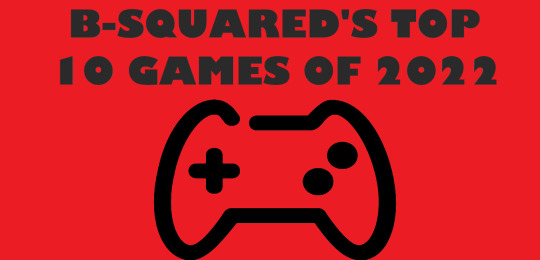
It’s that time again! Where I chase trends and rank games that I played this year on an arbitrary scale that is purely subjective! This year had some real strong releases…most of which I didn’t really play for one reason or another. There are just too many games, and not enough time (or money) to get to them all! Some of the more talked about games this year unfortunately passed me by, so this list might look different from yours and that’s OK! Now, of the games I DID play this year, I liked most of them and have some things to say, so let’s dive into the 10 games I liked the most this year.
#10 - FIRE EMBLEM WARRIORS: THREE HOPES

This year was filled with rumors of the next major Fire Emblem game being revealed, and while that DID happen eventually, few were prepared for another Warriors spin-off, this time centering on the cast and setting of Three Houses. Three Hopes pulls double duty as both a second attempt at a Fire Emblem Warriors game, as well as a reinterpretation of the overall plot for Three Houses. An alternate take on events with a new protagonist in Shez, Three Hopes was a fun action-packed romp through the lands of Fodlan, with tons of fanservice for those that loved the most recent Fire Emblem game. With a large cast of playable characters, three distinct stories to choose from, and an interesting blend of the hack-and-slash action Tecmo Koei is known for alongside the RPG and more character-driven elements of Three Houses, Three Hopes was a welcome surprise for this year before Fire Emblem Engage graces us in early 2023.
#9 - MULTIVERSUS
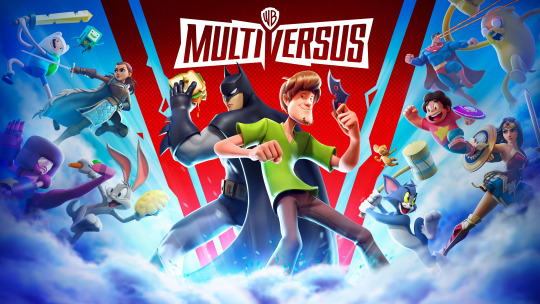
When leaks spoiled that a Warner Bros. platform fighter was in development with QUITE the odd selection of characters in late 2021, I didn’t think much of it. Slowly but surely as more was shown however, MultiVersus became quite the surprise fighting game hit for 2022. Despite a lot of high-quality titles out this year, like King of Fighters XV or DNF Duel, it was MultiVersus that made a huge splash with some impressive player numbers in the opening weeks. A team-based platform fighter, the game manages to carve out its own niche in the increasingly crowded platform fighter subgenre, and alongside that the potential cast for this game insures there’s something for everyone. From classic Looney Tunes, to the cast of Game of Thrones, or even LeBron James himself, you’d be forgiven for thinking that such a mash-up wouldn’t work. Instead, the strong art direction manages to make every fighter feel like they could actually exist in the same world without it being TOO jarring, and it helps that the developers are going all-out with some really interesting movesets to make sure each character is true to their respective texts. Velma supports allies by looking for clues and calling the cops…er…Mystery Machine to take away foes, while the Iron Giant’s moveset is mostly just him having fun or eating some scrap metal, only to bring out his combat mode to save his ally. The sole issue the game really has is the free-to-play business model that encourages grinding out countless matches for meager returns, and charging exorbitant prices for various cosmetic items. Despite all of that, MultiVersus is a game I sunk a lot of time into this year and makes a case that fighting games can go free-to-play and still manage to do quite well for themselves.
#8 - MARIO + RABBIDS: SPARKS OF HOPE
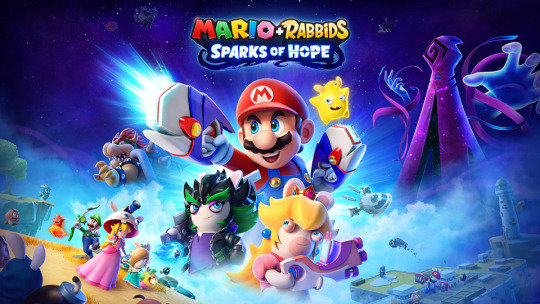
Probably the craziest release of 2017 was a Mario and Rabbids spin-off from Ubisoft that, for whatever reason, was a tactical RPG. Despite the odd premise and gameplay shift, Mario + Rabbids: Kingdom Battle was a surprisingly good time and seemed to sell rather well. With that in mind, a sequel seemed like a smart decision, and so here we have Sparks of Hope. A space-faring adventure with Mario and company, this is one of those sequels that does just about everything bigger and better. Levels are more expansive and fun to explore, the roster of playable characters grows, and the story is just a bit darker. Combat has been made a bit snappier while maintaining the strategic freedom that made the first game so great and the end result is a content packed romp that was pretty hard to put down. Having a playable Bowser is always a good sign that a Mario spinoff is gonna be great, but what’s most surprising to me is that Ubisoft has found a way to make the Rabbids less irritating…and maybe even kinda cute? This two-game streak has somehow managed the impossible: they got me to tolerate the Rabbids. With Rayman DLC in 2023, the fun is only just beginning for this inspired crossover.
#7 - POKEMON SCARLET/VIOLET
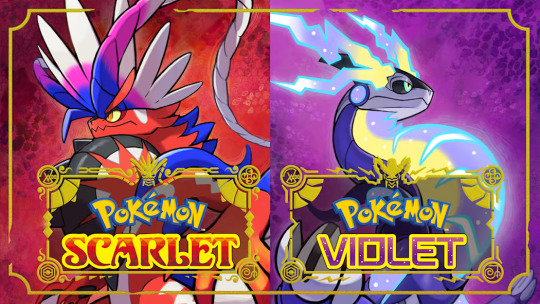
The Pokémon franchise has had its fair share of ups and downs lately, but even so a new generation is definitely still something worth celebrating. Pokémon Scarlet and Pokémon Violet are themselves very interesting games when looked at in comparison to what’s come before them. The franchise’s first full-blown open world adventure, players are given newfound freedom to explore the world and progress the story in whatever order they desire. On that note, I wasn’t really ready for the story to stand out as much as it did. Surprisingly heartfelt with some really sweet moments, the cast of Scarlet and Violet feel well-realized; more so than the casts in most Pokémon games. The Paldea region is a ton of fun to explore, with some great new Pokémon to capture as well. I would do anything for my adorable Tinkaton. That being said, this entry was mired by a number of damning technical issues that were inescapable and really dulled my enjoyment. While there is hope these issues might be addressed in future patches, it is my hope that future Pokémon games can launch in a better state. After the release of Sword and Shield, the future of the franchise seemed in question, but after 2022 I have faith the series is on the right track and we’re on the cusp of a brand new era for the franchise where it can really shine bright.
#6 - MONSTER HUNTER RISE: SUNBREAK
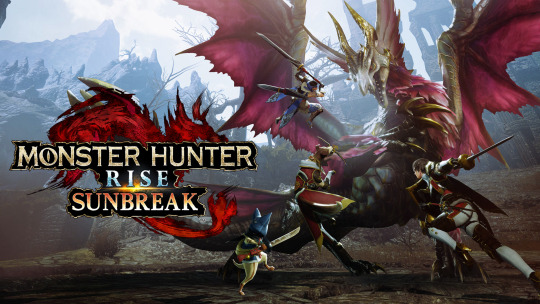
Now this one might be cheating a bit. The Sunbreak expansion for Monster Hunter Rise might not technically be a FULL game, but it has more than enough content to count in my book. Building on the systems in the base game, Sunbreak delivers on a more challenging adventure for hunters to tackle. Set in a more European-inspired locale, it was a blast taking on not only the base game’s roster of monsters with new tricks up their sleeves, but the brand new monsters inspired by classic European folklore. From the lupine Lunagaron, to the bulky Garangolm, and the vampiric Malzeno leading the pack, it was great to lose countless hours in a blink in the pursuit of just one more hunt. And of course there have been tons of free updates since launch to further tide hunters over lasting well into 2023 as well, so really what more could you ask for? Well you know besides cross-play or cross-progression? If nothing else, the expansion gave me an excuse to jump back into Rise’s world, swinging around like I’m Spider-Man with the Wirebugs and learning a whole new assortment of powerful Silkbind techniques. With Rise heading to other consoles in 2023 as well, players that still haven’t experienced it won’t have many excuses left.
#5 - BAYONETTA 3
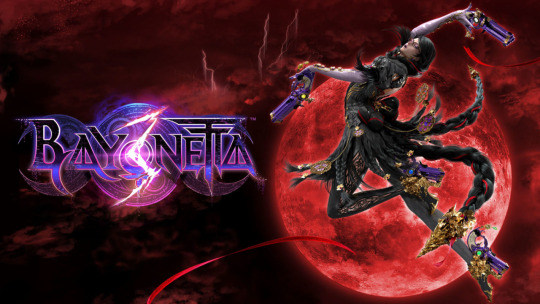
You might have noticed my extensive review of Bayonetta 3 from a bit ago, so I’ll try not to retread things too much, and if you want to hear more of my thoughts, you know where to go. A game that was over five years in the making from its initial teaser, it was definitely one of the most anticipated titles for me this year. Platinumgames blends their over-the-top spectacle with deep and satisfying combat as they attempt to move their most well-known franchise forward, and despite stumbling on some things, they still came out swinging. The scale of some of these setpieces are out of this world, and even in normal combat the ability to summon and fight alongside a gigantic demon at virtually any time definitely gives Bayo’s latest romp a distinct identity all its own. The music might also be the strongest in the entire series, which is honestly kind of saying something. I can’t get the various battle themes out of my head, alongside the operatic piece “Fertile Rondo,” from what might be the game’s signature scene. While some didn’t quite like the focus on demon summoning, and uh…well the story has its own controversies to untangle, there’s no doubt that Platinum brought out all the stops for this one and after so long I’m glad it’s finally here. We have an honest-to-God Bayonetta spin-off in March 2023 to look forward to as well, so we won’t have to wait too long to see everyone’s favorite umbran witch.
#4 - SPLATOON 3
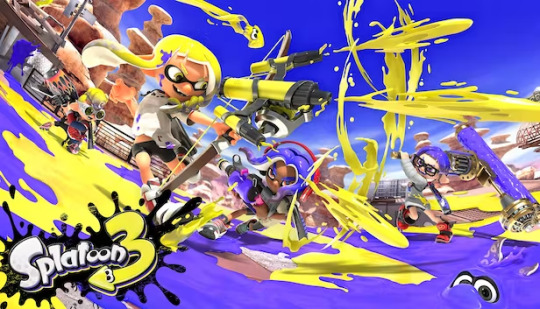
This was a year of hotly-anticipated third entries in ongoing Nintendo franchises, and perhaps the biggest of them was the launch of Splatoon 3. An absolute smash-hit of a series, particularly in Japan, the squid kids (and octarians) return for messier, inky battles alongside the signature “fresh” attitude that has set this series apart from every other core Nintendo title. While there was a lot of whining and gnashing of teeth over whether this game needed to even exist, or if it was different enough from past entries, Splatoon 3 delivered on a content-rich, highly polished multiplayer shooter, and most critics have been rather silent after its record breaking opening in Japan. With new weapon types, tweaked mechanics and a story mode that goes surprisingly hard, it’s a game I find myself coming back to and playing months after release. I’ve played more of Splatoon 3 in the first few months of its life than I put into about the entirety of Splatoon 2, just as an example of how much it gripped me. While the core of the series remains the same, the progression systems and constant stream of rewards has kept me coming back, and there’s only more in store down the line. With two years of planned free updates with a paid single-player expansion on the horizon, it’s pretty clear Splatoon 3 is going to be in my rotation of games for a good long while. Now if only they could fix the matchmaking…
#3 - POKEMON LEGENDS ARCEUS
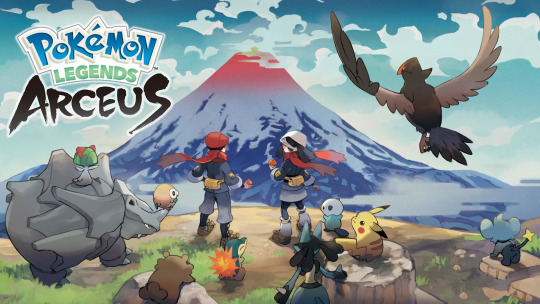
It’s rare to get TWO Pokémon games in a year, and while Scarlet and Violet will undoubtedly get more attention as they kicked off a new generation, for my money I was much more impressed and satisfied with Pokémon Legends: Arceus overall. Releasing right at the START of this year, it’s been a constant in my mind, as an ambitious new direction for the series that I hope continues in some form going forward. Taking place in the distant past of the Sinnoh region, players are confronted with wild, aggressive Pokémon at every turn in a world where Pokémon Trainers are not yet a common occurrence. With the game having far more focus on catching and cataloging the Pokémon available in the region, this is really the first game in a long time where I felt compelled to “catch ‘em all.” Adding to all of this, Arceus’ revamped battles and streamlined approaches to teaching moves and buffing up stats on Pokémon resulted in a game with a far quicker pace that was a breath of fresh air in a series long accused of becoming stagnant. Admittedly, a lot of these changes came at the cost of what many consider to be core elements of the series. There were no gyms, barely any trainers to fight, and many of the design decisions likely wouldn’t work in a more traditional game without extensive rebalancing. The fact that this game largely drops any multiplayer component is pretty telling in that regard, and for those reasons I can understand why many would prefer something like Scarlet and Violet over this one. That said, the technical issues found in the generation 9 games weren’t nearly as present in Arceus and on top of that despite the environments being far simpler and smaller than the open world counterpart, I found navigation and exploring to be FAR smoother in this particular title which helped push it over the edge for me. I hope future Pokémon titles can blend the best of both attempts to create something truly special moving forward, but what we have now is a solid foundation that I really hope is built on.
#2 - KIRBY AND THE FORGOTTEN LAND
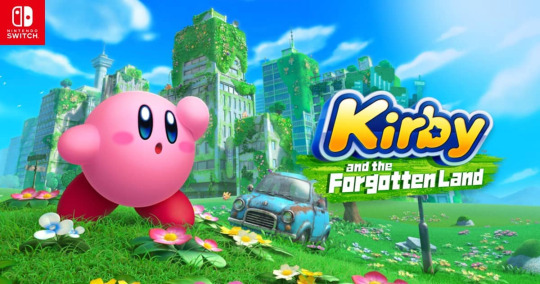
Everyone knows Kirby is a pretty consistently good series, but to see a Kirby game ranking this high should tell you this is something special. Kirby and the Forgotten Land is the pink puffball’s first fully 3D mainline adventure, which is noteworthy enough on its own, but the fact that their first attempt feels more polished than most other platformers well into their 3D era is what elevates this further and nearly made it my game of the year. Kirby finds himself in a strange new world, the ruins of a bygone civilization dotting the various levels he travels through. That alone helps to give the game a lot more personality. You aren’t just going through a generic desert or beach level; it’s the ruins of an old mall that was beaten down by the elements, or .a flooded city barely glimpsed beneath the sparkling waters. While levels aren’t as open as some might like, they’re designed well, with plenty of hidden goodies to find if players are savvy enough. Adapting Kirby’s array of Copy Abilities into a fully 3D space was clearly a tough one, and while I do wish we had more powers available, the ones chosen feel great to control. Being able to evolve abilities into stronger forms is a nice bonus, and tying this all together is some surprisingly solid boss fights. Kirby games aren’t typically too challenging to get through, and sure this is no replacement for the Devil May Cry or Bayonetta games, but this is a great introduction to the genre for younger players. The fights are filled with some great spectacle and surprising depth, not to mention…you trigger slow motion if you perfectly time a dodge so…need I say more? I mean, I will. Hal Laboratory really knocked it out of the park here; the game looks amazing, the soundtrack is a real standout (even amongst other Kirby games) and compared to the somewhat lacking Star Allies this felt like a fully-formed game that left me almost completely satisfied afterward. The level design to rival the best platformers in the genre, a soundtrack that feels like it belongs in some epic RPG, with some combat and boss fights that make it feel like baby’s first Bayonetta…part of me still finds it odd to rate a Kirby game so highly but Forgotten Land is anything BUT forgettable and shouldn’t be missed.
#1 - XENOBLADE CHRONICLES 3
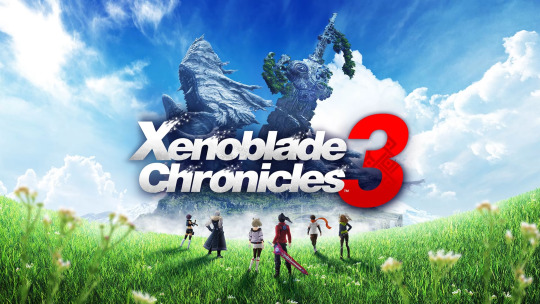
Watching the Xenoblade series grow over the years has been a great experience. From the original Wii title that I lucked into getting, having no idea how rare it would become, to the ambitious if destined to flop Wii U title, Shulk appearing in Smash Bros. and the Switch era’s solidification of the brand as a core, if niche, series…it’s just great to see developer Monolith Soft continue to top themselves. Rumors abounded for quite a bit before its unveiling, but when the February Nintendo Direct closed with the proper reveal the surprise was still palpable. Xenoblade 3 quickly shot up to be one of my most anticipated games of this year, and after it launched in July I knew very early on this was going to be my Game of the Year.
Set in a world stuck in an endless war, six young soldiers, once sworn enemies, must learn to work together to set the world to rights. Xenoblade 3 tackles the horrors of constant fighting, the fragility of life, the fear of leaving an impact before you’re gone, but it also highlights the value of life, and makes seemingly mundane things we take for granted feel like miracles. It is a game that, even in the depths of a perpetual nightmare, never once loses hope for a better tomorrow. With how dark the world seems nowadays, I found this story really resonated with me; it’s the kind of story that I felt I needed to hear, gripped by my own indecision and fear of the unknown. Watching Noah, Mio and the rest of the group grow and come together was a heartwarming, and occasionally heartbreaking, journey and I came away loving the entire team. Monolith Soft crafted a gorgeous world that builds off of the previous mainline Xenoblade games, but still manages to stand on its own by delivering a character-focused narrative that had me gripped from the first moment. On the gameplay side of things, for as complex and at times overwhelming as the Xenoblade games can get at points, 3 is the most streamlined and approachable game in the series. The class system was a lot of fun to mess around with, and combined with some really gripping sidequests and optional party members to add to the group, it stands out as the first Xenoblade game where I did absolutely everything in it. I couldn’t put it down for the longest time, and by the end I felt sad that the journey was over. Xenoblade Chronicles 3 really feels like Monolith Soft firing on all cylinders; we have gorgeous vistas in a strong anime-influenced art style that pushes the limits of the Switch’s hardware, a powerful, memorable soundtrack with songs that still give me chills to this day. Seriously, The Weight of Life is also my Song of the Year. Taking the best elements from every previous entry, 3 feels like the most consistent game in the franchise. While there are aspects in the other games I might prefer over 3 in general, the entire package is the best it has ever been for Monolith Soft. We still have more to look forward to in 2023, with extra quests and costumes in the expansion pass, on top of a new story that, judging by 2’s DLC, will be a full game on its own. The entirety of the Switch era has really shown Monolith Soft has become the backbone for modern Nintendo; from their support teams assisting on first-party entries like the Splatoon series, Breath of the Wild and Animal Crossing: New Horizons, to the continued success of Xenoblade… I can’t wait to see what they have in store for us next time. It’s likely to be another GOTY contender.
And that will do it for my Game of the Year discussions for this year. Obviously a lot of BIG games weren’t in this list, and I’m sure if I had gotten to them things would have shuffled a fair bit. I sadly missed out on Sony’s prestige titles like Horizon: Forbidden West or God of War: Ragnarök. Despite being surrounded by discussion on Elden Ring, I didn’t get around to it and might not for quite a while. There are even several smaller titles that caught by eye, like Neon White, Freedom Planet 2 or Stray that I’ll attempt to get to in the near future but ultimately…there are just too many games and not enough time. Gamers are spoiled for choice these days, and that makes me happy to see the industry still delivering some real solid hits. For as bad as things can get, I always have a game within reach to entertain me and occasionally hit me in such a way that it stays with me long after finishing it, and really I can’t ask for much more than that. Here’s to a great year in gaming, and here’s hoping 2023 can continue to deliver!
-B
#GOTY#gameoftheyear#2023#blog#videogames#nintendoswitch#playstation#ps4#multiversus#xenoblade3#kirby#bayonetta#bayonutters#pokemon#legendsarceus#scarletandviolet#eldenring#godofwar#stray#splatoon3#mario#monster hunter#rabbids
1 note
·
View note
Text
The Bittersweet Taste of Bayonetta 3
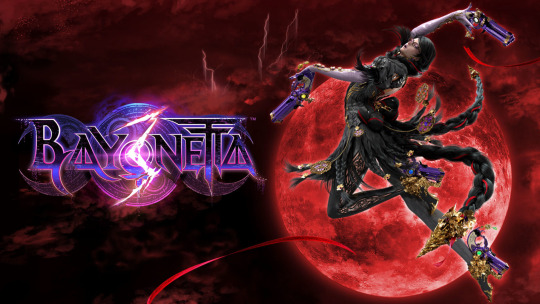
PlatinumGames is among my favorite developers out there. Rising from the ashes of Capcom’s Clover studio, they are on my short list of developers that make amazing games that really resonate with me. Their games are quirky, often mechanically deep and a bit unwieldy. They’ve managed to carve out a cult following over the years, and by far their most infamous series has been the stylish action of Bayonetta. In 2017 Bayonetta 3 was announced but as the years passed with no news, many grew nervous. Platinum’s output since then has been quite inconsistent, and earlier this year they released Babylon’s Fall, a game that didn’t crash and burn so much as spontaneously combust before it ever got off the ground. There’s this cautious air around Bayonetta 3’s release; it isn’t enough to just be a good game in its own right, but many feel that Platinum’s future rides on it succeeding. In the weeks before the game released, the game became the catalyst for a discussion on properly compensating voice talent. Bayonetta’s original voice, Hellena Taylor, called for a boycott, claiming she wasn’t offered a fair wage, though later information would imply she was omitting information to make her case look better. Regardless, the air around Bayonetta 3 wasn’t all that positive and I’m sorry to say that, after having gone through the game, I find it didn’t come out the other side smelling like roses. Bayonetta 3 is a very interesting game to talk about, for a variety of reasons both quite positive…and unfortunately very negative. One of my most anticipated games of this year, it has given me some mixed feelings and leaves a bittersweet taste in my mouth.
ENTER THE BAYO VERSE
After two games where Bayonetta has taken on the legions of heaven and hell and taken on a few gods, there’s really only so much the series can do to raise the stakes. The game opens with the introduction of our main threat: Singularity. A being so strong it threatens not just the universe, but the entire multiverse. As Singularity consumes one unlucky world, a young woman named Viola just barely escapes, traveling to another universe and enlisting the help of Bayonetta to stop Singularity and save all of reality before there’s nothing left. There’s definitely a more dire tone to a lot of the game, as we can see firsthand the destruction of Singularity’s forces, with Bayonetta and company being pushed to the limit to save the day. Of course, there’s still plenty of fun, campy moments throughout, like impromptu dance offs, a demonic concert (complete with glow sticks!) and more than a fair share of tasteful nudity and the sensual style that has made the series infamous. The opening prologue level certainly hits a lot of the same beats from past entries; Bayonetta’s living it up in town, something goes wrong, Enzo is made a fool, and she beats up some basic enemies while taking her clothes off and eventually showing off some fantastic new guns. Viola serves as a pretty interesting foil to Bayonetta at the start as well; despite putting on a cool front, she’s clumsy and goofy, frequently at odds with Bayonetta as she struts about with all of the confidence of a seasoned Umbran Witch. With the titular witch taking on a bit of a mentor role, it’s a decent starting point for another adventure. The promise of interacting with different variations of our heroine as they jump from world to world also just seems rife with possibilities. That said, this strong start can’t quite hide the game’s frequent rough edges in the presentation.
As the Switch gets on in years, the lacking quality of its hardware only becomes more apparent, with even Nintendo’s own first party offerings often having to make sacrifices to run on what is ostensibily an outdated smartphone. The Bayonetta series has never really been a graphical showcase, though there’s aspects of 3 that definitely feel more than a bit dated, even going back to the original game’s release during the seventh console generation. NPC character models look and animate quite stiffly and environments are often extremely empty and lacking in high-quality textures. Sadly the game’s performance follows suit, being a bit of a downgrade from even the previous entry on the Wii U. The game targets 60 FPS but often is somewhere closer to the 40s or 50s, with occasional dips below that in more hectic moments. Now, I’ll be the first to admit I’m not the most sensitive to this stuff and it never really impacted my gameplay, at least to a degree I was consciously aware of it, but it is a shame the game can’t give more consistent results.

(source: Eurogamer )
I do find the game is smooth enough most of the time, and it’s clear Platinum brought their A-game when it came to the overall presentation despite all of this. Cutscenes are still directed with that manic energy that makes Platinum’s titles such a joy to experience. Bayonetta herself, and most of her enemies, are animated extremely well, with tons of personality oozing out of many attacks and even idle animations. The menus are a bit sleeker than past entries and generally things are as seamless and smooth as could be when getting into and out of combat encounters. There’s a lot less of the stop-motion cutscenes in this game as well, which helps the overall story feel a bit more high budget and consistent. Music is also pretty consistently great. From the eerie, ethereal music often accompanying Singularity’s minions, to the peppy battle themes accompanying Bayonetta and Viola’s various scraps, there’s a lot to like. One of the real highlights would be “Fertile Rondo,” an operatic jam that doubles as a huge reference to The Fifth Element.
Voice acting also remains generally strong throughout, with returning actors like Yuri Lowenthal, Grey DeLisle, and Dave Fennoy feeling right at home with Luka, Jeanne and Rodin respectively. I have to really credit the amount of charm Anna Brisbin gives to Viola, and overall the character made a good impression on me. Of course, this also means I have to touch on the controversy with Bayonetta’s voice change. Taylor’s take on the character was great, and regardless of who replaced her, it was always going to be a bit awkward, but Jennifer Hale is a pretty good get in that case. A veteran in voice over, Hale’s credits are numerous and should honestly speak for themselves, and I would say she nails this take on Bayonetta, to the point it almost feels like she’s always played the character. There are points she sounds almost uncannily like Taylor, though admittedly it isn’t always consistent. But overall, she embodies the sass and style associated with the character and makes the transition about as flawless as could be hoped for overall.
I have…more things to say regarding the overall story, but we can save that for later. Instead, there is still an underlying action game under all this, so I’d better get to talking about that.
SIZE ISN’T EVERYTHING (BUT IT HELPS)
There’s been a fair bit of escalation throughout the Bayonetta series from game to game. The first title mostly focused on Bayonetta herself beating up hordes of angels, with only occasionally summoning limbs of demons for her Wicked Weave finishing strikes, and often a fun QTE at the end of major encounters to finish off bosses that teased more of the demon. Then in the sequel, Infernal Climax took center stage, where for a brief time ALL of Bayonetta’s attacks summoned demons, and at one point you were even directly controlling the demon Madama Butterfly for part of a boss encounter. But the threat in Bayonetta 3 is so great that summoning the whole demon is both frequent and required to even hope to win. In a bit of a twist on things, the main villainous faction are man-made homunculi, and since they aren’t angelic in nature Bayonetta’s summons have no real desire to help out in battle. Thus, she invokes the Demon Slave ritual to take direct control over them, allowing players to control the demons in real-time. There’s definitely some stipulations though; Demon Slave constantly drains Bayonetta’s magic meter and once emptied you’ll have to wait for it to fill to a certain amount to summon them again. Demons can also eventually turn on Bayonetta and go on a rampage if attacked enough, and perhaps worst of all, Bayonetta is stationary while players are in control of demons, meaning players need to learn the proper time and place to invoke it. Players can equip up to three demons at a time and freely switch between them in combat, in many ways allowing demons to serve as additional weapons to Bayo’s arsenal. Admittedly, some of the demons are a bit unwieldy and require practice to use efficiently, and some are a bit situational, but all of them bring something unique to the table and further expands Bayonetta’s combat options.
One facet I really enjoyed about the game is the Demon Masquerade system. Depending on the weapon equipped, at points Bayonetta can take on a form similar to the demon said weapon is based on, which can drastically change her mobility. With her default guns, Colour My World, she takes on Madama Butterfly’s visage and gains the ability to slowly hover through the air on her wings, while with Gomorrah’s weapon, the massive G-Pillar, she takes on a more feral stance and hops about, with a fast air dash to help her cross gaps quickly. Players also use skill trees for each weapon to unlock more moves in her arsenal that also have her transform to perform them, like powerful crowd-clearing attacks, or the near-universal gap-closer moves that have her home in on the nearest enemy. Demons also have a similar skill tree to enhance their own movesets, and by filling out both you gain one final upgrade that fleshes out each moveset. It’s a bit different from being able to buy moves in Rodin’s shop, but it works well enough as incentive to keep fighting and trying out different weapons.
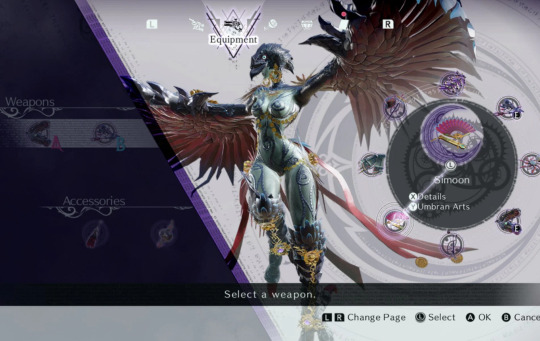
On that note, Bayonetta 3 has some of the best weapon variety in the entire series, if not THE best. While this game does away with the ability to set weapons on both your hands and feet, thereby reducing the amount of interesting weapon combinations and synergies, this change allowed them to go all-in on some out-there weapons that wouldn’t have worked otherwise. One of my favorites is Abracadabra, a combination of a top hat and cane that allows Bayonetta to moonlight as a magician, allowing her to summon various projectiles out of her hat at random, as well as utilize powerful electric blasts. Or there’s Tartarus, a slow but powerful weapon consisting of thick, stone doors that can plow through enemy attacks, but when opened can summon a variety of weapons, including some powerful gatling guns that rip through targets. I could go on, because there are TONS of weapons in this game with their own quirks and uses, all with their own demon that has their OWN intricacies. Many demons are often large beasts, like the dinosaur-esque Gomorrah, or Baal, a giant toad, but there’s more than a few unique demons like Wartrain Gouon which…is a train. And when you summon it, you have to draw the train tracks and hit attack buttons along the route before the train barrels on through and slams past all in its wake. The sheer options available is amazing, to the point that it’s a tad disappointing you can only have two weapon sets at any time. That said, while weapon variety is great, enemy variety leaves a bit to be desired.
Most of the homunculi enemies suffer from one of two major issues: they have samey designs that keep them from standing out and feeling distinct, or they’re giant enemies that are basically designed purely for demons to rip through their inflated health pools. If you’re someone who ends up hating using demons in combat and would rather ignore it, then have fun chipping away at these damage sponges! Of all of them, the Virga enemy might be the least fun to fight in the game. Basically a giant Wiggler enemy from the Super Mario series, it never stops moving or attacking and often has no reactions to any attacks done to it, making it difficult to get through the fight unscathed. That’s on top of the camera frequently clipping into it and making it almost impossible to see. Really, the camera might be the greatest enemy in the game. Not only does this game employ a “soft-lock” and force Bayonetta to attack whichever enemy has triggered it, but the “hard lock-on” often forces the camera to make strange, sweeping movements, and it isn’t long before that lock-on is broken and you’re forced to do lock-on again. On top of that, enemies break the series tradition of mostly not attacking when off-screen, and won’t hesitate to take potshots at you with little warning. With the combat areas in general much larger to accommodate the demons and large enemies, this can also mean it’s quite easy to lose track of some smaller enemies and be forced to whirl the camera around frantically to find them. After the previous two games had such a tight camera by comparison, this is a bit of a downgrade unfortunately.
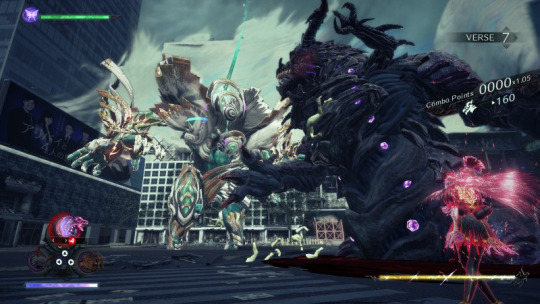
Generally, when Bayonetta’s core combat is allowed to shine and it all clicks, it works amazingly well, but sadly there’s even more things inserted into the game in the name of variety that often bogs the entire experience down a bit.
NEW KID ON THE BLOCK
While Bayonetta’s flashy combat is the star of the show for the most part, at various points in the story players will engage with different gameplay styles and different playable characters. This is really nothing new with most games from Platinum, as they love to sneak in schmup sections and setpieces to change things up, though I find that in the case with THIS game…they don’t often land and come across as annoying padding. There’s multiple instances throughout the game where Bayonetta will ride atop a demon, or players just get to command it directly, which are far more sluggish and unresponsive than in normal gameplay, Demon Slave or otherwise. A good example would be a timed platforming section as you ride atop the flaming spider Phantasmaraneae that is noticeably slower and less agile than when it is used in Demon Slave combos, OR the much faster, responsive Demon Masquerade version of it, complete with an awkward camera that’s often far too close. But then we go bigger with more climactic battles culminating in Bayonetta invoking the Deadly Sin ritual, offering up her own heart to empower demons and allowing them to go even further beyond their original powers. I wouldn’t say these sections are all-together bad, but the variety frequently goes against what I came here for in the first place. I want to play Bayonetta 3 for high-octane action, not weird rail shooters or slow kaiju fighting games and DEFINITELY not rhythm games, but you’re forced to play these if you want to advance through the game. This series is a more arcade-like action title that really tries to get you to replay levels and get better scores, and these sequences are kind of a drag to do again. Had they been their own self-contained chapter, I wouldn’t mind as much, but they’re often at the end of already long chapters and really bring down replays. That said, this game now saves your highest score for each separate Verse of a chapter, and you can pick specific “checkpoints” in a chapter to minimize replays, so it doesn’t sting as much as it could.
That said, it doesn’t stop there. Throughout the game you can play as both Jeanne and newcomer Viola, but sadly there’s a lot to be desired there. In Jeanne’s case, you play through short 2D side-scrolling segments with a focus on stealth as she seeks out a scientist to assist in defeating Singularity. So you have a series that prides itself on cool, kick-ass characters and suddenly force them to hide in vents and do stealth kills to the cannon fodder grunts? Feels more than a bit out of place. Again, these aren’t really BAD…but they’re not that fun and take away from the very first time Jeanne has been playable during the main story, as she’s usually relegated to being an unlockable moveset clone of Bayonetta after you beat the game.
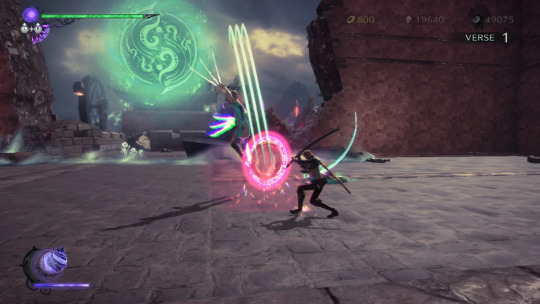
Viola though is where my real disappointments lie. We’ve had different playable characters before, but they’re either near identical to Bayoentta in gameplay (Jeanne and Rosa), or restricted to a separate mode (Rodin and Balder), so Viola being an out-and-out NEW character that’s playable during the main story SHOULD be really interesting but she instead feels half-baked. Armed with a katana, some throwing darts in lieu of a gun, and the demon Cheshire as a familiar, Viola on paper seems like a fun enough alternative to Bayonetta. She’s got some fun, flashy sword combos, and in an interesting twist, when she summons Cheshire to help, she’s free to continue moving around and attacking because Cheshire isn’t under direct player control. It gives her a completely different bareknuckle moveset and feels satisfying on its own. But unfortunately, it becomes clear this game was not designed with her in mind. The bigger enemies are clearly made for the Demon Slave summons to tear through, but Cheshire just doesn’t cut it. He’s often slow and at times actively lofts about and smokes on his pipe rather than attack, leaving Viola to fend for herself. Some friend. Adding to this, Viola’s moveset is decently fleshed out…but it’s still just ONE weapon compared to the plethora of other weapons Bayonetta can mess with. She lacks variety and feels really stale after a bit. With so many weapons in this game, surely they could have spared at least ONE for Viola. But the worst aspect has to be how she activates Witch Time, a core mechanic in these games. Bayonetta dodges attacks to activate it, slowing down time and letting her go to town on the defenseless enemies as a result. Viola meanwhile must parry incoming attacks by blocking, which brings to mind Metal Gear Rising Revengeance, another Platinum title. A couple problems here though: most enemies don’t seem balanced for the parry at all. They either do huge, sweeping attacks that either miss Viola completely, or have ridiculously tight timings to even land the parry in the first place. It’s WAY less forgiving than Bayonetta’s dodge and one optional challenge mission involving you only being able to damage enemies while in Witch Time nearly had me tearing my hair out. Playing as Viola frequently feels like trying to jam a square peg into a round hole. Maybe that’s the reason she’s only playable in three of the game’s chapters, falling behind even Jeanne’s side-scrolling missions in frequency. She feels like a last-minute inclusion, despite playing such a big part in the story.
IN CONCLUSION (kind of)
With all I’ve said up until now, I have qualms with some aspects of the core gameplay but I largely had a blast. When the game just lets you focus on fighting, the game is fun and dynamic, with TONS of satisfying tools to learn and master. The game’s larger levels allowed for more downtime as I searched out optional missions or collectibles, and I largely appreciated the change in scope. Some levels left a bit to be desired, feeling more like large boxes than real places, but there are times when the game really shines. The levels taking place in an alternate Egypt are what I wish the entire rest of the game was like. Huge, sprawling locations with tons of secrets tucked away, what felt like small dungeons with some quick puzzles and interesting combat encounters, and probably the best of the Deadly Sin gameplay change ups. I largely enjoyed Bayonetta 3 as an action game, with spectacle that few other series can match. Despite some rough edges in performance and visuals, and some annoying setpieces, it is clear Platinum gave it their all to make a game that attempted to surpass the high expectations of fans. The music goes HARD at times, the story has some real standout moments that I loved, and in a lot of respects this might be the most fun game in the series when you factor it all in. This feels like not just an evolution of the Bayonetta series, but Platinum continuing to tweak and iterate on ideas found in their other titles. The DNA of many of their games exist within this one, serving as a bombastic, content-rich entry that in many ways was well worth the near five-year wait from the initial reveal.
With all that said however, the game’s ending left me extremely conflicted on the entire product, and I want to go into that, but also I’d rather not spoil it for people that might want to go into it themselves. I’ve put my concluding thoughts here ahead of a spoiler-filled section on this ending for that reason. So, overall despite some rough edges, Bayonetta 3 is a high-quality title that stands up with some of Platinum’s greatest….as long as you just completely ignore a terrible ending that feels like they’re trying to torch the franchise and run away.
THE ENDING: MESSY, RUSHED AND UNEXPLAINED
PlatiumGames isn’t really known for their storytelling; they make really fun, goofy action games, and barely anyone really talks about those games’ narrative. So, for anyone that hears Bayonetta 3’s story is bad, it makes sense to think “Well, who cares about story in a Platinum game anyway?” In general, a lot of video games place gameplay over story, so is it really that big of a deal if Bayonetta 3’s story falls flat as long as the gameplay is good? For a lot of people, I’m sure that is enough and I can understand them brushing off complaints. But that isn’t enough for me. Just because this is an action game, I don’t think the story should be half-baked. Plenty of action games, not just from Platinum, manage to strike a better balance, and despite the shortcomings of the previous games in the series, I like the world and characters Platinum have created here. Which is why the ending stung as hard as it did, as it feels almost vindictive towards all that came before, and if that wasn’t the intention, they really botched the execution.
Bayonetta 3 has a lot of great ideas for a fun story, or even a great one. But the problem is that Platinum tried to shove too much into one game, and as a result almost every plot point and bit of narrative potential is wasted. Multiple important details that make the story comprehensible are locked away in character bios that most players aren’t likely to dig through and read. Certain elements of the endgame feel unearned, and the game’s tone changes so often the whiplash is constant and jarring. So, let’s delve into those points one at a time.
I’ll start with the tone. Most of Platinum’s work are over-the-top and not really meant to be taken too seriously. They employ humor throughout the vast majority of their work, they aren’t afraid to blatantly homage things they think are cool and to me they’re at their best when they just have fun with their premise and setting. Bayonetta 3 has a lot of these moments for sure, but they attempt to blend it together with a darker, more dramatic turn and it just does not work at all. The prologue chapter has the entirety of New York flooded, as Singularity begins his assault. The death count alone in this chapter easily eclipses the other two games. Even Enzo, the plucky comic relief, is reduced to tears as his family has seemingly been killed. So when Bayonetta and Rodin are just quipping back and forth it really feels misplaced. Did this game want to be serious, or just as irreverent as past titles? They needed to pick a lane and stick with it. Honestly, I don’t think being more serious fits either Platinum or the Bayonetta series, and if they did want to try to branch out, I think they overcompensated.
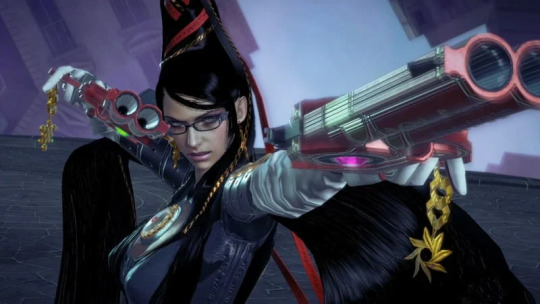
(Bayonetta without a confident smirk on her face is just...wrong!)
Bayonetta, much like her predecessor Dante from the Devil May Cry series, is a power fantasy. She’s sexy, she’s powerful, she’s always in control. The draw of these games is seeing her mop the floor with celestial beings without breaking a sweat. So when this game tries to up the ante and establish higher stakes, they really struggle with doing so in a way that feels organic. The game opens with one universe’s Bayonetta being killed by Singularity, which works as a demonstration of the threat he poses. The problem is that this keeps happening throughout the game; every single alternate Bayonetta we encounter gets about five minutes of screentime before being unceremoniously killed in a cutscene where they become uncharacteristically incompetent. No one in this game ever looks behind them. So there’s drama here and the stakes are higher than they’ve ever been, but that comes at the cost of Bayonetta as a character looking less powerful and capable. This dark tone and constant death toll also just kind of spoils all of the fun a multiverse tale like this could have had.
When promotional materials made it clear this was a multiverse story, I was looking forward to all of these various character interactions…so imagine my surprise when there’s not much done with that premise at all. For all of the infinite possibilities that come with bringing a multiverse into your story, all Platinum could seemingly think up was “What if Bayonetta lived in another country?” There’s flashes of interesting elements that never get fleshed out on-screen at all. The Tokyo Bayonetta is a delinquent while the Egyptian Bayonetta is a princess with Jeanne as both her bodyguard and her superior in combat. I did enjoy the Paris Bayonetta sections though. Working with her mother Rosa, they’re a pair of thieves with that world’s Enzo chasing after them as a cop, like Lupin III’s Zenigata. But I wanted MORE of that! The Chinese Bayonetta is a war general who apparently lost her eye in an interesting story…the game has no interest in telling us that story though! They had an opportunity to really shake things up; what if we had a world where Enzo was the one with the magic powers, or one where Bayonetta was a Lumen Sage instead of an Umbran Witch? I also find it odd that while we do get to see some alternate Jeannes and Enzos, we only get one alternate Luka and zero alternate Violas, when having more could have made some interesting contrasts. I could forgive a curbed roster if they did much with them, but the bulk of the game just has us hopping from universe to universe, taking every alternate Bayonetta’s demons and weapons for our own and promptly forgetting about them. The Egyptian Bayonetta has a character arc concerning her lacking confidence and overreliance on Jeanne squeezed into two chapters of the game when that could have been fleshed out over the course of the game instead. With our “prime” Bayonetta serving as a mentor to Viola, it could have been interesting to see multiple Bayonettas attempt to give Viola advice, to showcase how different these alternative selves were, but alas, there was just no time apparently.
Further adding to the missed potential, there is the entire concept of fairies introduced into the series with this game. Now, if they wanted to introduce a new faction I have no real objections. Bayonetta’s already fought angels and demons, and spends the entire game fighting these strange man-made homunculi, so beating up some fae folk isn’t really that big of a stretch…except the game barely touches on them at all. After two games without them being mentioned, suddenly Luka is revealed to be part fairy, and this influence is then retconned to be the reason he became a journalist. Despite the fact that the first game made it clear he was obsessed with “the truth” because he watched his father being torn apart by angels he couldn’t even see so uh…that doesn’t really fit. If this is meant to merely tease them being fleshed out more in a sequel, this really wasn’t the place to do it.

I can’t talk about Luka without touching on the controversial romance subplot with him and Bayonetta. Now, this is controversial for a number of reasons. For one, while Bayonetta did flirt with Luka a fair bit in the first game, they barely interacted at all in the second game or this game for that matter. The chemistry just wasn’t really given time to develop. That’s not even getting into the backlash from the series’ gay fans. Over the years a lot of queer folk have kind of “claimed” Bayonetta as a series, mostly from the game’s constant campy tone, combined with a lot of romantic subtext with Bayonetta and Jeanne. But the backlash goes beyond just a ship they liked not being made canon, but moreso this strange subtext applied to Bayonetta and Luka’s relationship in this game that many feel is at best “bi erasure” and at worst downright homophobic or heteronormative. At various points, Singularity calls Bayonetta “Arch-Eve” and Luka “Arch-Adam” so there’s this idea that they’re like…a universal constant and are destined to be together? This coupled with Jeanne not really getting to do much in this game is viewed as a slap in the face by some fans. I don’t really believe Platinum was intentionally going against their gay fans here, and I do think some fans took their own headcanons a bit too far. I’ve heard some even try to claim that there just was no way straight people could get anything out of the series and uh…yeah I don’t really see that point at all. For my own two cents, I just think this romance was really rushed and should have been fleshed out more throughout the series. Or just have Bayonetta, Jeanne and Luka in one big happy threesome, I don’t know.
All of these rushed plot points and dashed potential end up getting twisted up into a very long, grueling final boss fight where…things just kind of happen suddenly, without any explanation before or after. All of the killed Bayonettas (and Jeannes) are revived…and then disappear again, the game being unclear on if they’re still gone for good or were saved. Two more Bayonettas, each clad in the first and second game’s designs respectively, appear to help out in the final battle, but they also vanish without a trace randomly. Then the final blow is dealt to Singularity and a vortex opens up in the sky at the EXACT moment Bayonetta loses control of her demonic summon. This is all a contrived situation purely to force Luka to save an unconscious Viola as she’s pulled into said vortex, thereby allowing Gomorrah to kill Bayonetta definitively. Luka cradles Bayonetta’s soul as they are both dragged into hell, all while Viola cries out for her mother and father and pounds the ground in frustration. Cue credits. Oh, except for the part where Viola suddenly fights…Dark Eve. A character that isn’t explained in-game at all and is only fleshed out in the character bios that update after the game is beaten. By somehow fighting off this uh…dark amalgamation of all of the other dead Bayonettas…somehow this means Viola has proven she has what it takes to take on the mantle of Bayonetta. We get another stinger where we see she is taking on jobs from Rodin, with the game seemingly setting up that any future Bayonetta games will have her in the starring role. Cue dance party ending!

Where do I begin here? The game’s inability to confirm anything really muddies the waters here and makes the ending come across as more somber than I think was intended. New York seems fine in this stinger, and Enzo’s family is seemingly alive and well…but what of the other worlds? If they’re all back to normal…why isn’t Viola with her real mother and father? On that note, why did the game wait until the exact last second to confirm something most fans guessed before the game even came out? I feel that dragging out Viola’s parentage until the very end of the game did nothing for the story, especially seeing how little Viola really factored into the story at all. Then there’s the ending with her as the new protagonist. The game sets this up as an optimistic passing of the torch but…I just don’t think it’s earned at all. Throughout the entire game Viola is showcased as being a bit of a joke. She never gets to actually defeat anything of real significance, and even in the final battle with Singularity she’s batted away and becomes a liability at the end. Sure, she defeats Dark Eve, but the sudden appearance of this random character the game barely tried setting up undoes any amount of triumph the moment should give the audience. I like Viola, but she isn’t ready to headline this series.
In the time since the game’s release, series creator Hideki Kamiya has commented on the backlash, stating that Platinum hadn’t been as clear with some things as they should have been, and that Bayonetta 4 would address these concerns and criticisms. Of course, there’s the question of if PlatinumGames as a studio will even exist long enough for another game to come out, but assuming that it does happen, I suppose there is a chance they could smooth this all out. Maybe we see that Bayonetta and Luka are living it up in hell, and all of the other universes are fine and dandy. Maybe Jeanne is still around and can help out Viola as she comes into her own. That’s a lot of maybes though, and there’s no guarantee THAT game wouldn’t just drop the ball in its ending too.
A lot of the issues I levy at this game could also apply to the other two games. All three games feature villains with no actual substance to them, with no motives for why they do what they do; they exist to be a big boss fight to cap off an action game. All three games don’t really explain everything as well as they could, with the first two having time-travel nonsense wrapped up in the narrative. I wouldn’t call the stories for the first two games good, and going into this game I didn’t really have high hopes on a good narrative, but I assumed there would at least be a fun one. I think that’s the biggest problem here; the fun is gone. Bayonetta 3 tries to raise the stakes but in the process, it lost a lot of what made the first two games so compelling for people. Yet they try to carry on like everything is fine, with a dance party ending filled to the brim with characters that are, as far as this narrative tells us, dead, and we’re left with a character we barely know headlining the series as everything else fans have come to love about the franchise is long gone. It feels like Platinum saw the ending to Devil May Cry 5 and thought “Hey we can do that too!” except they completely misunderstood why that game’s ending worked as well as it does.

Not to go into it too much, but Devil May Cry as a sister series to Bayonetta has already done the passing of the torch thing, with Dante eventually letting the younger Nero take over. What I think Platinum missed here is that it took Capcom TWO games to fully allow Nero to graduate to the main protagonist role, and even then, I feel like the massive gap between the two games is what allowed fans who previously disliked Nero to eventually cool down and come to accept him. Adding to all this, Nero was at least playable for half of Devil May Cry 4 and roughly half of Devil May Cry 5, whereas Viola gets barely three levels to herself in Bayonetta 3. Even though both Bayonetta 3 and Devil May Cry 5 end with the previous protagonists in Hell, Dante doesn’t seem all that bothered by it and the narrative allows enough wiggle room to bring him back with little trouble. In Bayonetta’s case, her end seems far more permanent. Despite some similarities, the contexts differ dramatically.
I think I’ve gone on long enough here. I really want to stress I didn’t expect to come out of this game feeling as down about it as I did. I heard people not liking the ending, and assumed they were just jaded Bayo/Jeanne shippers…but I couldn’t have been more wrong. It’s frustrating, as in some respects I feel like Platinum can and HAS done better. For as silly as it was, The Wonderful 101 had real heart to it, and I think to this day that is the best story Hideki Kamiya has ever written. While Bayonetta 2 didn’t have the best narrative, I think it was an improvement over the first, and humanized Bayonetta a fair bit. My criticisms stem from my desire to see Platinum succeed. I am without a doubt in their corner and want to be excited for their games, and in recent years it’s been hard to be a fan. Astral Chain was pretty interesting, if a bit wonky at points (and also didn’t have the best story), but from 2020 onwards Platinum felt like a shell of their former selves. Using a Kickstarter to port a barely-touched “remaster” of The Wonderful 101, releasing self-published titles like World of Demons on the Apple Arcade and nowhere else, or the ridiculously overpriced schmup that is Sol Cresta. 2022 opened with the disastrous launch of Babylon’s Fall, and now this game, despite delivering on the action, had to stumble so hard at the very end. When they first started their company, co-founder of PlatinumGames, Tatsuya Minami stated that they chose to be named after platinum because “platinum never loses its luster,” and that was their motto for making games. But as 2022 draws to a close, their shine has dulled, and I’m having a hard time coming to terms with that.
Ultimately, that’s just my take on things. I value story a lot, as you can probably tell, so a bad ending for me matters a whole lot more than a lot of Platinum’s audience I’m sure. As I’ve mentioned before, Bayonetta 3 is still a high-quality title when it comes to stylish action, with plenty of fun setpieces, tons of weapons and tools to master, and a presentation that is constrained only by its hardware. I wouldn’t for a second label Bayonetta 3 as a bad game. It’s great, in fact, and one I would recommend to others…I just wish I didn’t have to attach an asterisk to the end of that recommendation. Despite it all, I’m glad this game finally came to fruition and I desperately hope Platinum can regain some of their luster in the years to come.
Until next time.
-B
#Bayonetta 3#Bayonetta#viola#jeanne#platinumgames#platinum#action game#character action#nintendo switch#bayonutters#review#spoilers#devil may cry 5
22 notes
·
View notes
Text
Xenoblade Chronicles 3 Review: The Best of Both Worlds
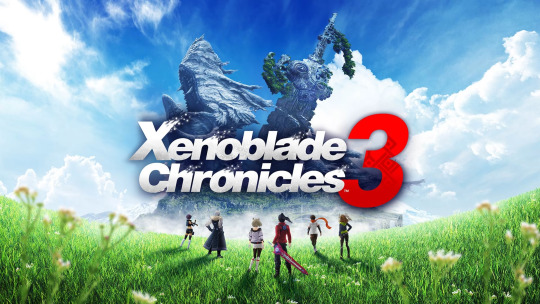
Monolith Soft knows a lot about ambition. From their early days as a game developer, they’ve always strived for more. With ambition however, there’s often compromise. For co-founder Testuya Takahashi, his vision has often been unfulfilled despite his best efforts. From Xenogears’ infamous second disc, to Xenosaga being cancelled partway through the six planned entries, and even with Nintendo’s own Xenoblade franchise there have been issues that held the games back. Xenoblade Chronicles wasn’t initially localized outside of Japan, Xenoblade Chronicles X was both on the ill-fated Wii U, but also had re-writes that severely impacted the story, and Xenoblade Chronicles 2 was made with a skeleton crew, as Monolith Soft was also assisting with two major Nintendo games (Breath of the Wild and Splatoon 2) that would launch in the same year. Despite all the hardship, Xenoblade has become a bona-fide franchise and with the latest release, Xenoblade Chronicles 3, we might be getting a look at Monolith Soft when the shackles can finally release and they can complete their vision without compromise.
FIGHT TO LIVE, LIVE TO FIGHT
Something to address right away: it is perfectly OK to play Xenoblade Chronicles 3 without having played any prior game. While connections exist, the focus is on the world and characters introduced in this game, and while having extra context is nice and you might notice some references to past entries, it is far from required reading. With that said….
In the world of Aionios, there is nothing but war. Two factions, Keves and Agnus, are locked in an eternal struggle. They don’t fight for resources or politics; they fight and kill because it is the only way they can stay alive. These factions find themselves at the mercy of the Flame Clock, a measurement of their remaining life force. Though they must also eat and sleep, they too must take the lives of the enemy faction to keep their own Flame Clock filled. The people of Aionios learn to fight from the moment they are born, and have frighteningly short life spans, or “terms,” of roughly ten years. Should they make it to their tenth term, they are taken before their queen for a Homecoming ceremony, returned to her and laid to rest. A life of nothing but fighting, no one questions the natural order…until one faithful day.
Six soldiers, three from Keves and three from Agnus, find themselves on an unorthodox mission and end up meeting a man named Guernica, who is far older than anyone they have ever seen before. He tells them of a “true enemy” and that the world was once different, though it isn’t long before the group is attacked by this enemy: Moebius. Though fatally wounded in the battle, Guernica bestows a strange power to the six youths, enabling them to fight back against Moebius and give the world a fighting chance to set things right. With both factions branding them as traitors and Moebius also working to hunt them down, it is up to an unlikely ensemble to shatter the nightmarish status quo and find out what it really means to live.

Xenoblade 3 at times is the darkest entry in the franchise to date. A somber atmosphere, the game doesn’t shy away from the horrors of war. The fact that most characters in the game are basically child soldiers is merely the tip of the iceberg. Each of the main cast have experienced trauma from the constant fighting, from the people they’ve lost and what they’ve had to do just to survive in the nightmare of Moebius’ creation. Noah and Mio, our main leads, are off-seers, tasked with sending off those that die in battle, so they are both the closest to death among the main cast but also the ones who are quickest to set aside their differences in an effort to set the world to rights. Noah is a lot more philosophical about life and death throughout the game; despite being against fighting if he sees another option, he’ll still take up arms if he sees no other choice. Mio meanwhile is fairly restrained and kindhearted, but is constantly weighed down by the knowledge that she is on her final term, with roughly three months left to live at the game’s start, giving her a sense of urgency to complete the group’s mission before it is too late. That’s not to say the game can’t have more light-hearted moments though; though not to the extent of Xenoblade 2 there are often characters and missions with a more laidback, comedic bent which serve to mostly balance out the otherwise bleak setting, and leave us with memorable secondary characters. Despite the dark setting, there is a sense of optimism that shines through and keeps the game from being too exhaustingly bleak. On top of that, it might just have the best main cast in the series.
A goal for the development team was to flesh out the main cast, to not have any one “main character” that took up the bulk of screen time and development, which is definitely something the other Xenoblade games have been guilty of in the past. While Noah and Mio are given a bit more focus in the core plot, the rest of the group aren’t far behind and have their own effects on the narrative at various points. Lanz, easy to write-off as the hotheaded idiot of the team, works through his own trauma throughout the game and has to come to grips with letting go of his past if he wants to walk forward. Eunie, a brash if well-meaning friend of Noah and Lanz, struggles with strange visions that haunt her and give some eerie implications into the greater setting. She also has some of the funniest lines in the whole game. Taion, who I feared would quickly fall into a route “smarmy know-it-all” archetype displays a fair amount of depth early on. Despite being among the least-pleased with working with his former enemy, he’s smart enough to rein it in and at least attempt to get along with everyone. Despite taking a lot of pride in his strategic prowess and at times coming across as stoic, his more emotional moments lead to both some of the more touching parts of the game, and also some of the funniest. Sena, at least initially, came across as a bit lacking. She’s the plucky girl who seems to be Mio’s personal cheerleader; however her development is more subtle. Despite being driven and powerful in her own right, she lacks confidence in herself and is constantly seeking validation. She sees herself reflected in other characters throughout the game, and eventually learns of her own self-worth, though I do feel that quests ostensibly meant to be focused on her aren’t always keeping her in the forefront, so it isn’t perfect.
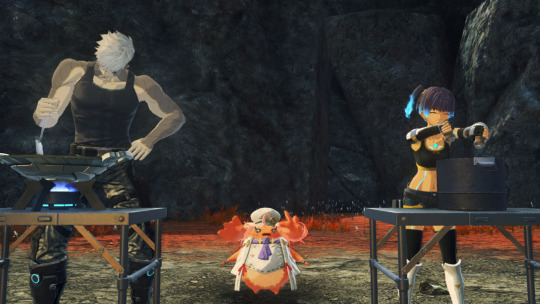
While the main cast feels more fleshed out than any previous Xenoblade game, I do feel that the antagonists are a tad undercooked as a result. Moebius are billed as hedonistic monsters who orchestrate the eternal war behind the scenes mostly out of boredom. They pointedly refer to this all as a game, and have no real respect for any life but their own. While easily detestable, I do feel that the vast majority of Moebius lack depth, coming across more so as Monster of the Week styled obstacles than real characters. Coming off of the villains of Xenoblade 2, in my eyes the strongest antagonists in the franchise, this is definitely disappointing. Then again, seeing as Torna in Xenoblade 2 was a tight-knit group of five, it was far easier to flesh them out compared to Moebius’ 25 members. They went with quantity over quality, but even with the “main” members that received larger focus, I do feel that the game fumbles a bit at giving us villains that are all that memorable. While I want to avoid outright spoilers, I do have to mention I find the ending also loses a bit of steam. The game has a real emotional and narrative high point and…kind of runs on fumes after a while; though I think the ending is strong enough. I do feel there are more unanswered questions with this game when the credits roll, and some moments that don’t make much sense if you stop to think about them. Xenoblade 3 at points seems to be going for a more thematic, symbolic story than an overtly logical one, so I can let a few things slide. Seeing as there is story DLC coming next year though, it is possible the closure and explanations I yearn for are a ways off.
On the whole though, I think Xenoblade 3’s story is very well done. An interesting hook at the start, a steady supply of new developments that push things forward, with a large variety of interesting characters and the best main cast in the series yet, even with the ending stumbling a bit. Monolith Soft seems to have taken a lot of the criticisms of the English dub of Xenoblade 2 to heart here as well, as the English performances are excellent across the board. Lip synching also applies to either the Japanese or English audio tracks, so we no longer have the more awkward moments from Xenoblade 2 where things didn’t even remotely match up. As far as other aspects of the presentation go, Xenoblade 3 continues to push what should be possible on hardware as old as the Switch. Vast landscapes filled with things to see and do never fail to impress, while the overall character models are expressive and detailed. The main cast can even get dirty when out exploring, with a dedicated option to wash clothes when at camp. What the game might lack in high-fidelity textures it often makes up for in its strong art direction and expressive anime cel-shaded style on characters, making this one of the Switch’s most technically impressive games. Also worth noting, there has been more focus on making the game look good in handheld mode as well, which was often seen as an afterthought for previous Xenoblade games on Switch. Coupled with a targeted 30 FPS frame rate the game is about as smooth as one could hope for, considering the console specs and sheer scope of the game. I also feel I should point out how seamless the game is when switching from cutscenes to gameplay. Previous entries in the series would have to fade to black to quickly load in boss fights but in 3 the game instead has a more stylish zoom out straight into gameplay out of the cutscene. While there is a definite difference in quality for the pre-rendered cinematics versus the in-game cinematics, the transitions between the two are a lot smoother, and coupled with voice work even in many of these in-game moments, the overall presentation is a good deal higher than past entries in the series.
youtube
To go this far without mentioning the game’s music is a crime unto itself, but to be honest here, when it comes to Monolith Soft, I simply just expect great music by default. Thankfully, Xenoblade 3 delivers here. From a beautiful piano piece that serves as the main menu theme, to several fantastic battle and field themes, there’s almost too much to parse when picking favorites. Compared to the previous games, Xenoblade 3 has a heavy emphasis on flutes, tying in with Noah and Mio’s instruments when working as off-seers, and giving the game its own distinctive sound. It can be hard to name favorites but I’ll try anyway. The Moebius battle theme itself includes ominous chanting, which ties in with the player tackling higher beings with god-like power, and at points the song even sounds like it is laughing at you, emphasizing that Moebius sees this all as entertainment over anything else. “A Step Away” is one of only two vocal tracks in the game, playing at the game’s emotionally draining darkest hour and may or may not have caused tears to be shed. For my money though, “The Weight of Life” has to be my favorite, despite how little it plays in the game. A climactic song that amplifies the cutscenes it appears in, it showcases just how hard the team has to work to overcome overwhelming odds and has moments of intensity that give me chills every time I hear it. Appearing at the end of the game’s second official trailer, I couldn’t get it out of my head then and still can’t. As always, Monolith never disappoints when it comes to music. Well…except for the fact that using a Chain Attack completely overrides whatever theme is playing, which means you can miss out on the more dynamic boss themes. So that could be better. That said, we still have an actual game to describe here, so I’d best move on.
BATTLE WITH CLASS
To anyone that has played any of the games in the series up until this point, Xenoblade 3 will be easy enough to get into, but for those that might be new to the series, here is a quick run-down of the basics before we get into what this game does differently. Speaking broadly, all Xenoblade games play out very similarly to MMO-styled combat. Players are free to move around in control of one character while the rest of the party is controlled by AI. When in range, you’ll attack automatically, though these attacks are often weak. The real damage comes from using Arts, special attacks with a wide range of uses and effects, which undergo cooldowns after use. Some Arts require you to hit opponents from a specific position, like Noah’s Edge Thrust, which does more damage from behind. Depending on which faction they belong to, Art cooldowns differ slightly in this game. Kevesi characters like Noah, Lanz and Eunie, have to simply wait for the cooldown to expire similar to Xenoblade 1. Agnian characters (Mio, Taion and Sena) instead recharge their Arts with auto-attacks similar to Xenoblade 2. Many Arts also are used in status combos, with the party using specific Arts in sequence to force a given status onto the enemy. Noah might inflict Break on opponents to stagger them, and Lanz can follow up with an Art that inflicts Topple, making the enemy defenseless for a time, as an example. While the AI generally follows along with what you want to do, this game also allows you to swap control to any main party member during battle, and even outside of that you can give some orders to allies to make them do specific things if need be. For the most part as long as you do your thing, you can let the rest of the party handle things on their own, but having the option is certainly nice.
This game really emphasizes proper team composition and everyone acting according to one of three roles: attacker, healer or defender, which should be fairly self-explanatory. New to this game is a wide variety of classes characters can obtain, all of which fall under one of these three roles. While Noah and company all have their own starting classes, throughout the game players can recruit extra party members, known as Heroes, and unlock the Heroes’ classes for the rest of the party. As a class is used, it levels up separately from the character and after certain milestones players will gain skills and Arts that can be used regardless of class, which is where some real interesting customization happens. You could have characters learn some healing Arts so they can help out regardless of class, or just give characters more offensive options in general. Given enough time it becomes easier to do various status combos or inflict some big damage, but the game still has plenty of other systems at play to make you even stronger.
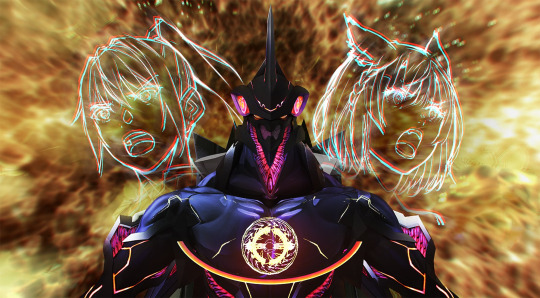
Following the inciting incident in the game, the core party gain the ability to Interlink into powerful forms known as Ouroboros, which they can freely use in combat a bit later on to great effect. While active, the Ouroboros has powerful Arts unique to them and they take no damage from attacks, though the form has its drawbacks. The Interlink will eventually overheat if not cancelled early, locking out the form for some time, and early on before the forms can be properly leveled up you won’t last long and be able to do as much. On top of that, characters have specific Interlink partners; Noah with Mio, Eunie with Taion and Lanz with Sena. If one of the pair is defeated in battle or hit by certain statuses, the Interlink cannot be performed. There’s also the problem of being down a character. If your healer Interlinks your party loses out on any heals, so you better make them count. While not an instant-win button, with practice the Ouroboros forms can help turn the tide of harder battles, but for situations that require even more power, there’s always the series staple in the Chain Attack. Once the Chain Attack gauge is filled, players can activate it at any time. Time stops and players can go all in on one enemy with the ability to use any Art on any party member. Without getting into the intricacies, the player is given an assortment of “orders” at the start of each “round” of the Chain Attack, which all have different effects if completed. Noah’s order has attacks potentially bypass an enemy’s defense, for example. The goal of each round is to use Arts to build up Tension Points. Once you reach 100 Tension, the order is executed. Rinse and repeat until you either run out of party members or the Chain Attack gauge empties. Heroes have their own orders that can be incredibly powerful; Valdi adds more Tension to his Arts if fighting a machine-type enemy, for one. And later on, Ouroboros orders can be used if certain conditions are met for even more damage. It takes a bit of luck and coordination but this game’s iteration of Chain Attacks might be the best yet in the series…perhaps even too good.
The series has quite the reputation for being difficult to get into and having quite complicated combat, though 3 aims to streamline things a great deal and ease players into things. From an honest to God training mode, to the slow but steady introduction of major mechanics with dedicated tutorials, Xenoblade 3 is perhaps the most straightforward game in the series, even if the beginning of the game somewhat goes too far with handholding and forcing players to do something as simple as, say, equip a piece of gear onto a character step by step. I’d rather the game teach me at all than flash a tutorial prompt on screen that can never be revisited though, so it’s a massive improvement from Xenoblade 2! Navigating menus is also made easier, with shortcuts that let me get right to where I want from the main game, like letting me open up the area map or party customization screen instantly, and those shortcuts can even be customized. There’s lots of smaller accessibility features in the options as well to make things flow smoother, like letting your AI allies Interlink on their own or leaving it to your explicit order. These quality-of-life updates really start to add up over time.
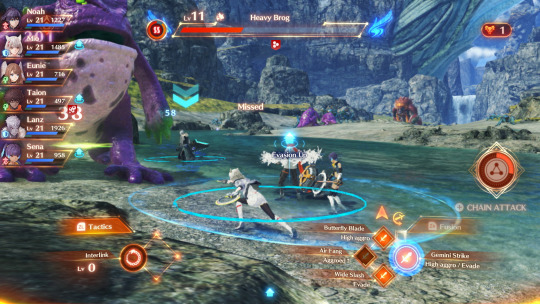
Throughout the series, Monolith Soft has streamlined combat and with 3 they’ve landed on a really solid series of systems. The combat is faster and snappier than in 2, though retains that game’s improvements from 1’s combat, such as attack cancelling and the more streamlined UI. That said, an issue this game shares with all but Xenoblade Chronicles X is the inability to jump and run in combat, which can get awkward in the often bumpy terrain battles take place on. Getting launched by an enemy attack can cause you to get stuck on a small hill and be unable to get back to fighting unless you holster your weapon, at which point you’re a sitting duck. While the UI is streamlined and the game generally does a MUCH better job of teaching you, some fights are still a cluttered mess. I’m not sure it was really worth it to have the entire party (plus one Hero) active at once. Against larger, single targets like bosses it is mostly fine, but when fighting multiple enemies at once it becomes sensory overload, it being a legitimate problem trying to find who you’re locked onto and knowing what’s even going on. Those issues are fairly minor though, and the end result is some of the most engaging combat the series has ever had. Other aspects like equipment are further de-emphasized as was the case in 2; you can equip some basic accessories and gems to your character, as well as fiddle with the skills and arts you obtain by mastering classes, but that’s about it as far as “builds” go. As someone who dislikes having to constantly buy new armor and weapons for huge RPG parties, I’m not all that upset to see things simplified down like this and find the class system engaging enough when trying to optimize characters, so I think it balances out. While fighting is a huge part of the game, let’s not forget there’s other aspects to this gameplay experience too!
SATING MY WANDERLUST
As a series, Xenoblade really excels at sating my wanderlust, boasting vast landscapes filled with things to see and do that are often quite striking. In some respects, 3 makes some great improvements from the previous entry, though I’m still left wanting more. Aionios, according to the developers, is roughly five times bigger in terms of walking distance compared to Xenoblade 2’s Alrest, though I find the ways to navigate this world aren’t scaled up to match. Your run speed and jump height and distance aren’t much different than in either Xenoblade 1 or 2, despite the world being so much bigger and it just doesn’t cut it. Often the jumping is mostly to get over the small bumps in the road that you should logically be able to already walk over but can’t for whatever reason, and it’s otherwise useless for any amount of platforming, and while I made frequent use of the fast travel system to get around there’s still large stretches where I would turn auto-run on and put my controller down to do something else as the group crossed large expanses. The most infuriating thing about all of this though is that Monolith Soft already solved these types of issues with Xenoblade Chronicles X on the Wii U. That game was also massive, bigger than Breath of the Wild in fact, and was a seamless, open world to boot. And to match that players not only could run FAR faster than in any other game, they could jump far higher and farther to make navigating the vast world of Mira fun in its own right. And later still you would gain access to a giant robot, the Skell, to cross even larger expanses faster and eventually unlock the flight module to make the world your oyster. While I’m not asking for 3 to add in a giant robot to fly around in (I mean I wouldn’t say no either) at the very least I wish this game took the running and jumping from X. Later in the game you do gain access to a boat to cross a large aquatic region…but its controls both leave something to be desired and the sheer scale of this ocean means the boat only makes moving from point A to B SLIGHTLY less tedious.

To the game’s credit though, it does improve on one of my least favorite aspects of Xenoblade 2’s navigation. In the latter, you would frequently need to unlock paths forward with field skills and constantly open up menus to swap around Blades to get the appropriate skills in order, but it was a real mess and pace breaker. In 3 field skills are taught to the party after meeting certain Heroes, and just have them permanently active from that point onwards. The game even teases you a bit at the beginning by showing you tightropes you won’t be able to use until a ways later into the story. That said, there’s only four field skills in the entire game and two are completely optional, and even in those cases I can count the times you DO need to use them on one hand. Expecting every Hero to have their own field skill would have been overkill for sure, and in this specific case I’m glad Monolith Soft didn’t go for quantity over quality. Sadly, the game couldn’t improve on 2’s map at all, as it still makes it difficult to judge differences in elevation. Certain symbols only show up on the minimap but not the full map, and you’re limited to just one pin you can put on the map per areas, which simply isn’t enough. Seeing as so many people from Monolith Soft worked on Breath of the Wild, which had detailed maps that showed off things well, as well as multiple pins and such to work with, this is a pretty disappointing step down. Far from unusable but there’s more that could have been done here.
Thankfully, the game does improve on one aspect the series has always been a bit iffy on: the quests.
HOLDING OUT FOR A HERO (QUEST)
Xenoblade has often had a LOT of quests, but very few were really worth doing outside of the experience or money they’d give you. The first game went a little too hard on MMO-styled quests that just amounted to killing a given number of enemies or gathering a given amount of items. Some quests had more worthwhile rewards and little storylines associated with the NPCs giving them out but it really wasn’t worth having to trudge through all of the basic ones to get to them. Xenoblade Chronicles X was a fair bit better with more engaging quest lines throughout the game with more tangible rewards. Watching your city slowly accept more alien citizens into it was really neat, among other things. But that game also had strange requirements to even take on quests and often limited who could or could not be in your party to even accept them which held it back. The vast majority of quests in Xenoblade 2 were kind of unremarkable to be honest, though the Blade quests were often higher quality…a shame most Blades were only obtainable through in-game gacha that took TONS of luck and grinding to even get. So really, the bar was pretty low for Xenoblade 3’s quests and they still raised it so much higher that it’ll be very hard to top.
Side quests in 3 come in two flavors: basic quests and Hero quests. Basic quests can vary but often concern themselves with NPCs and tend to have their own minor storyline connected to the colony they hail from, while Hero quests are for both recruiting and later strengthening the Heroes you can add to your party. Hero quests come with voice acting and even some extensive cinematics at times, so the presentation really makes them stand out. While some Hero quests are actually required to complete the story, the vast majorities are optional…but if you take nothing else from this section, know that it is within your best interests to do them if you can, because they contain some of the game’s best moments. Be it character development, gags, or some really great rewards in the form of power-ups or party members, I was almost never disappointed with the Hero quests. Some are so good I’m shocked Monolith Soft didn’t make them required, especially since they often tie up loose ends to the core story or some characters’ personal arcs.
Something I came to enjoy about all of these quests is how they would often feed into each other and in some cases build off of one another. Take the quests found in Colony 9. The colony is rather run down at the game’s start and the new commander, Zeon, isn’t well respected by the rest of his subordinates. His initial Hero quest is about learning to trust Noah and the others, but subsequent quests around the colony are about him earning the trust of his peers and eventually getting the colony to start growing their own crops to sustain themselves. This requires the help of Colony Tau, which you encounter much later on, but serves to strengthen relations between the two. Most of the colonies in the game end up being paired off with a colony from the opposite faction, further emphasizing the game’s core themes of looking past initial differences or prejudices and working together for a common goal. Some basic quests can have some unexpected payoff. One questline has you attacked at random points by strange robotic soldiers, which eventually leads to a late-game Hero quest, and that hero teaches you a field skill that enables you to tackle another Hero’s ascension quest as you go off in search of a mythical hot spring. It made me feel validated in scraping every inch of the map and doing every quest when I could. Often times I was torn between continuing the core story and doing as much side content as possible, which is about the highest praise I can think of for an RPG. Things aren’t perfect, of course.
While I would say most missions are at least somewhat interesting for delving into NPCs or occasionally shaking things up, the game does repeat certain quest types a bit too much. Virtually every “follow the tracks” mission is the same, but the tracks themselves sometimes seem to wig out and spontaneously pop into existence. Not bad, but also not very engaging. Any time you have to follow an NPC that walks as slow as possible also kills the pacing of the game. I’m begging you here, Monolith Soft, please never do this again. There’s even two separate quest lines about making it rain that either requires random waiting around or dropping a ton of money on an NPC to make it rain instead. But really, the biggest issue I have with a lot of the quests in the game is how you get them.

Sometimes you’ll just be given a quest straight away, while others will be displayed on the map with a big glowing question mark. But often times you have to gather information on a quest before actually being assigned it. Wander over to NPCs with neon yellow speech bubbles and just eavesdrop for a few seconds and BAM, you have some quest info. But some quests require multiple pieces of information to even accept and even then, you have to go back to camp and specifically discuss the info to gain the quest. Some quests require you to have specific Heroes in your line up OR be discussed at a very specific camp just to give you more hoops to jump through. This does nothing but really add extra steps to the process and I don’t find it adds anything of note but maybe some minor flavor text. I can tolerate it for the most part at least, except for the handful of cases where the information you need to gather can only be obtained at VERY specific times of day. I wasn’t able to even START a few quests near the end of the game because I would have to go to a specific part of the map at a specific part of the day for the CHANCE the conversation would be there to overhear. Granted, you can change the time of day in-game manually but it was still an annoying obstacle that didn’t have to be there.
That said, I did everything in the game, which isn’t something I could say for ANY other Xenoblade until now, as there was always something that would burn me out of the process. Maybe there were just too many quests, or weird requirements to even start them, but Xenoblade 3 is the first game in the series I’ve 100% completed, so that should speak to the sheer quality of most of the side content in addition to the core story. For the most part the game is very keen on making it easy to keep tabs on your progress through quests, or making it easy to see where to go next. Some quests which required you to grab specific items would sometimes mark themselves on your map, and some areas would spawn a large amount of items in said area to make gathering take no time at all. That said, this wasn’t universal and there are still some really tedious questlines involving gathering items that I had to look up to cut down on time. All told though, I never felt the need to just drop a quest and enjoyed having so many things to do throughout the game. Monolith Soft has come far when it comes to their side content, though there are still some pitfalls with the greater balance of the game with all that in mind.
AN UNENVIABLE BALANCING ACT
Balancing a game is hard, especially an RPG with tons of systems layered over one another. Past Xenoblade games have been a bit hit or miss with balance, and going into Xenoblade 3 I was curious how well they’d balance a game where your entire party is battling at once. I think for the most part the game’s intended balance curve when focusing on the story is mostly fine. And it does take steps to keep players from growing too strong too fast and breaking the game over its knee but…well, let’s just say there are some issues with their approach to things.
Most regular encounters are generally fine so long as you are within a few levels of your enemy, and as long as you single out some stronger enemies and don’t attract a group you’ll do fine. Same old Xenoblade. As in past games though, there are varying types of enemies that can rapidly change things, namely the Elite and Unique enemies. Unique enemies are a series staple, basically bosses in disguise and are often far stronger than their level would imply, with Elite enemies a slight step down from that. These two enemy types are a LOT bulkier than standard enemies, and as I found throughout the game, most storyline bosses qualify as these types of enemies as far as health and defense goes. On the one hand, this meant that even in situations where I was quite over leveled, these bosses still put up a fight, but it also kind of makes most fights a drag….unless you use Chain Attacks.

Which leads to my next point: Chain Attacks are kind of broken. They are SO good, you’d be foolish NOT to abuse them, but by using them battles can get kind of samey, all that unique music is drowned out by the Chain Attack theme, and it also makes it easy to over level without even trying. See, similar to Xenoblade 2, if you kill an enemy during a Chain Attack but keep going for as long as possible you end up getting an “overkill” modifier to your experience. Depending on when and where you do the Chain Attack, you could end up getting upwards of 1000 times the normal experience. Add to this that Elite enemies also have a separate modifier for experience you gain from taking them out, as well as the fact that one of the perks to doing more side quests is upping the chances of seeing more Elite enemies…and it means you are DROWNING in experience before you even get to the experience gained from quests and exploration.
Now, in Xenoblade 2 Monolith Soft implemented a system where you would have any non-battle experience stored separately that you could access at an inn to bolster your levels if you needed a boost, or ignore it if you didn’t want to over level. This carries over into Xenoblade 3; however it lacks the ability to level down, which was added to the Switch port of Xenoblade 1, at least until the post-game. So you have a game where it is extremely easy to over level, even if you aren’t trying to optimize it, and that leads to another problem.
Whenever you complete a Hero Quest in this game, a given party member will “inherit” that Hero’s class. So, when you beat Valdi’s quest and add him to your party, Lanz gets the ability to be a War Medic immediately. For everyone else, they have to unlock it slowly by fighting alongside Valdi and/or Lanz in that class, as an example. What the game fails to tell you though is that if you are more than four levels higher than an enemy, characters gain NO progress towards unlocking these classes. Despite the fact you still gain experience and Class Points (to rank up the classes), they saw fit to freeze your progress. In a game where it’s criminally easy to accidentally over level, which pushes you to fight stronger and stronger enemies to actually unlock the classes the game is clearly built around. Which will just over level you even more. It’s a problem that starts small, barely noticeable, but by endgame I was left with a ton of classes I couldn’t really pass on to anybody, which really limited my options.
To be fair here, this isn’t an issue every player is likely to really run into. Not everyone’s going to do every quest in the game, or use all their stored experience. The game is perfectly playable and beatable without getting every class on every character. As I said before, going from story beat to story beat, the game offers pretty decent challenge, and if you don’t abuse certain things like the experience modifiers, you likely strike a good balance with the game. I also only played on the default difficulty so maybe the harder difficulty would have been a better idea. I’ve definitely seen strategies and set-ups that break the game in half and trivialize it even at the higher difficulties but that’s so far removed from an average experience with the game I can overlook it. Monolith Soft likes to put a lot of things into their games and striking a perfect balance between rewarding players for doing it versus not punishing players who don’t engage with every facet is impossible. For the most part, the game works fine as intended and for those that enjoy exploiting and optimizing things out, Xenoblade 3 can be a lot of fun. I just hope in the future they can try to limit punishing players that stray off the beaten path and gorge themselves on all this wonderful optional content. They’re getting better in some ways, but there’s still a lot more that can be done.
BRINGING AND END TO THE ENDLESS NOW
I’ve had a lot to say here regarding Xenoblade Chronicles 3. If you couldn’t tell, I quite enjoyed it and took great delight in devouring it over the course of about 170 hours. As it stands, this game is likely my Game of the Year, or at the very least in the running for it. Monolith Soft has become one of my favorite developers over the course of the Xenoblade series. From their support work on major first-party Nintendo games, to this series, I’ve seen tremendous growth from them. They learn from their mistakes and shoot ever higher, with each original title from them demonstrating that they are some of the best in the business. I said before that Xenoblade Chronicles 3 is Monolith Soft more or less at their best in many regards, and shows a glimpse at their true potential, with their ambitions fully realized.
While I am a bit mixed on certain endgame elements of the story, it was an extremely engaging, emotional title that excelled at giving me a main cast I really cared about. I love Shulk, I…tolerate Rex, but the rest of their party members were hit-or-miss By contrast, I love the entirety of the Ouroboros gang here. Demonstrating surprising depth and story relevancy, at no point did they fade into the background. While the setting definitely takes elements from past titles and longtime fans have a lot to dissect and mull over, making this game mostly a standalone experience allowed the cast to shine, no fear of being upstaged or made to play second-fiddle to returning characters. For anyone joining this series with this installment, I’ll say again that you don’t miss out on too terribly much and the core experience will still hit hard.
This is easily my favorite Xenoblade when it comes to the combat, making for a smooth experience that I easily lost several hours in without even noticing. The ease of swapping between side quests, the main story and exploring the corners of Aionios cannot be overstated here. For as long as the game was, it was hard to put down until I saw the ending through. Despite some bumps in the road, Monolith delivered not just a good story, but a good game built around it. It was a journey that seemed endless, and at times I didn’t want it to end.
For as bleak as the game could get, there was always an optimistic streak that kept it from being too much. For as nightmarish as the world was, the heroes moved forward. Xenoblade 3 is a game all about moving forward; it is about accepting loss, celebrating the good times along with the bad, and cherishing the time you have while you can. As tempting as it may be to live in a stable status quo, that leads to stagnation and ultimately destruction. The future is uncertain, there are doubtless struggles ahead, but despite that fear of the unknown, moving forward is the only way we can go on living. The past few years have weighed pretty hard on me, as I’m sure it has for many others out there, and it has put a lot of things in perspective. I found myself frozen, afraid to move forward or back. Trapped in my own “endless now,” I’m glad to have found hope again. This might be “just a game,” but it was a game I felt I really needed to play at this specific moment in time. It means a lot to me, and I’m glad I was able to share my thoughts on it. A triumph of the genre, Xenoblade Chronicles 3 stands out to me more so than perhaps any other game this year, and I can’t recommend it enough.
#xenoblade chronicles 3#xenoblade 3#noah#mio#sena#lanz#taion#eunie#ouroboros#moebius#rpg#jrpg#nintendo switch#monolith soft#reyn time#shulk#review#xb-squaredx
9 notes
·
View notes